



Sign up: ale[at]furtherfield.org
To accompany Invisible Forces, Furtherfield invites all gallery visitors to take part in a programme of public play, games, making and discussion led by alert and energetic artists, techies, makers and thinkers: Class Wargames, The Hexists, Dave Miller, Olga P Massanet and Thomas Aston.
Saturday 23 June 2012 – 1-5pm
Summer Board Games and Picnic with Class Wargames and Kimathi Donkor
Saturday 30 June 2012 – 1-5pm
Summer Board Games and Picnic with Class Wargames
Wednesday 04 July 2012 – 9-11am
3 Keys – The River Oracle – The Hexists
as part of Moving Forest by AKA The Castle
Wednesday 11 July 2012 – 11-5pm
Technologies of Attunement – Olga P Massanet and Thomas Cade Aston
Saturday 21 July 2012 – 2-5pm
Dave Miller’s Finsbury Park Radiation Walk
It’s a bizarre thing when you stumble upon the “new art movement” filtering through discursive chatter. Is it actually a movement, or is it simply a bunch of like-minded individuals telling me its a movement?
Behold The New Aesthetic then – a new art meme in visual culture whimsically constructed by James Bridle, which manifests itself in a Tumblr blog, a presentation for Web Directions South, Sydney and an original blog post. Recent attention to it has reached feverish proportions coming off the back of a SXSW panel in March and a generally positive endorsement by Bruce Sterling in Wired, plus some group responses on the creators project. More recently, the computational media scholar and philosopher Ian Bogost has posted his own thoughts for The Atlantic.
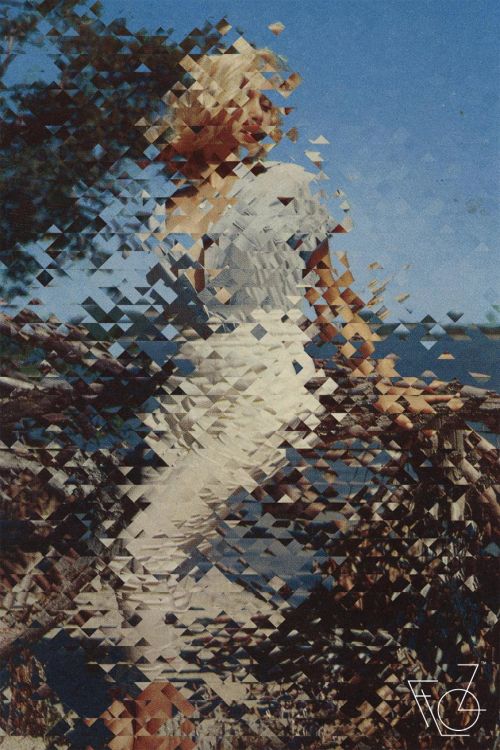
As a meme should do, “the New Aesthetic” has fulfilled its role – it has a lot of people talking about it. Like any meme which dices visual culture with some sort of research element, it has artists, writers, even media and aesthetic scholars measuring their own opinions on it in rank order without anyone knowing exactly where it’s going, what it really is or who exactly is doing it. In our noisy and crowded “I can’t believe I got 50+ retweets” over-networked epoch, this is quite an achievement even if you don’t take it that seriously.
But here’s the question: can the new aesthetic be more than a meme? More to the point, does it want to be? Is it capable of a direction? Can it be serious?
That said (and as Bridle avers) this isn’t really a prominent “movement” of ideas as such. Neither does it present material which it would deem ‘arty’. Instead, it’s an extremely broad and oblique orientation which seeks to document the subtle (and sometimes explicit) changes within our information saturated existence. It simply contextualises the contingent manifestations of computational activity, and how they are reversing and revising computational and human activities back in on themselves. Bridle’s tumblr simply presents the new aesthetic for what it is, much akin to perusing through pictures in a Facebook profile, a Reddit top ten list or clicking on Stumbleupon – simple snapshots of “stuff” which echo a blurring between the world of networks, machines and everything outside of it (with a particular emphasis on where it goes a bit wrong, hence a certain infatuation with glitchyness). Quoting Bridle’s Tumblr page;

“It is a series of artefacts of the heterogeneous network, which recognises differences, the gaps in our overlapping but distant realities.”
In another video presentation ‘We fell in love in a coded space‘ at Lift12, Bridle terms this ‘network realism’ – instances where the amalgamation of computational networked activity blurs with non-computational activity, to such an extent that it reduces any observer to nothing but a curious, passive node, gleefully whittling through instances of vaguely creative stuff. For Bridle, this occurs not just in industry but also architecture, finance, storage, fashion and now an attempt at aesthetic understanding. It’s an infatuation with the alterity of bots, algorithms, pixels and realised fictions. In this presentation however, Bridle is largely concerned with how one can respond or understand the ‘desires’ of bots, unaware that anthropomorphising the situation may not reap the rewards required. In this interpretation the new aesthetic is charged with the task of asking how we can think and orient ourselves computationally, whether it be designers, thinkers, writers, scholars or artists.
Sterling himself, mostly issues praise with a pinch of amusing impatience, as if the New Aesthetic movement should progress faster than it actually is doing, with more ideas and more focus. Kyle Chayka states that artists are already embracing it as a ‘contextual seedbed, rather than a label’. Jonathan Minard understands it as a new method of reflection concerning cultural tool-making, where the ‘dumb tools’ of machinic interface scream images back at us.

Digital Humanities scholar David Berry has blogged a similar view echoing that the new aesthetic is tapping into what he calls ‘Computationality’, a historical paradigm frame-making of sorts, which constructs specific meaning-making practices. Visualisation revolves around processes and patterns and so the list making exercise of Bridles’s Tumblr blog would seem apt in this regard, as it issues unparalleled amounts of pattern making not just as content, but as form. The archive is a jamboree of other pattern recognising events; security face recognition, retro 8bit encapsulation, satellite visuals and generally messing about with an Xbox 360 Kinect. James George mentions something similar but suggests that the new aesthetic should question the critical distance between artistic activity and technological use. It resembles a massive screen dump from a digital artist’s delicious account. Quoting Bridle again in an interview with The Design Observer Group;
“The New Aesthetic is not criticism, but an exploration; not a plea for change, rather a series of reference points to the change that is occurring. An attempt to understand not only the ways in which technology shapes the things we make, but the way we see and understand them.”
To most of the established readers here, it’s easy to criticise the “newness” of the New Aesthetic, in the same way the 90’s trope “New Media” has been quickly bundled away as if it never existed (Marius Watz makes this point). For those of you who have been studying such issues concerning hacking, play, enumeration, collecting, remixing, glitch-ing, (see Rosa Menkman in particular) in the broader realm of the computational arts, there really isn’t anything novel to gawk at: this is more of a rearrange or a rebadge. Indeed, internet discussion has been rife with such criticism, from the triteness of using Tumblr as the ‘official site’, to quick dismissals concerning the New Aesthetic’s distinct lack of any historically serious ‘substantial practice’ – not that it wanted it in the first place (Indeed it’s a pity that it has contingently replaced an identical term for a movement unrelated to Bridle’s own, coined by arts writer Michael Paraskos and realist artist Clive Head. Moreover, depending on how one looks at it, Paraskos and Head’s own movement has similar views espoused by Bridle’s version, including perhaps a direct opposition to conceptualism and foregrounding art as a material practice).
If Bridle were not so sincere about the whole affair, one would be mistaken that this was a too-cool-for-school strategy straight out of a Nathan Barley episode. But thats an easy misread. As Bogost states, Bridle is just curious about the weirdness of the network we all rely on and revel in. But there is a point where fascination with creativity turns into ADHD. The New Aesthetics tumblr site, already does just that, without any hint of standing still. “What’s going to come next? What can we do next? What are the limitations? What happens if I click that? What is that doing there?”
However both Bogost and Greg Borenstein issue a different view about the new aesthetic. They both discuss it in relation to a recent trend in philosophy called Object Oriented Ontology (OOO), a movement to which I am extremely sympathetic to. Bogost explains OOO succinctly enough;
“If ontology is the philosophical study of existence, then object-oriented ontology puts things at the center of being. We humans are elements, but not the sole elements of philosophical interest. OOO contends that nothing has special status, but that everything exists equally–plumbers, cotton, bonobos, DVD players, and sandstone, for example. OOO steers a path between scientific naturalism and social relativism, drawing attention to things at all scales and pondering their nature and relations with one another as much as ourselves.”
The link to OOO is fairly self-evident. If one of the most prominent aspects of the new aesthetic is an obsession with how a machine “sees” the world, OOO is a commitment to the seeing of things in widest possible sense. But while Borenstein generally aligns OOO to the new aesthetic with exuberant equivalence, Bogost’s view is one of general optimism, but not broad acceptance. For a start, the new aesthetics is based on a continual divide and repair between two opposing realms; the physical and the digital, each coming together and breaking apart endlessly, like throwing a box of magnets.
One of the main stipulations of being an OOO advocate is the realist eruption of what counts as a thing, and how that thing contingently relates to different types of entities. This is why Bogost decenters computation in the new aesthetic, and emphasises the multitude of things that escape the physical/digital divide. Their adventures are always-already strewn across the ontological landscape. One of the other main stipulations involves us lacking secure knowledge in fully understanding discrete units on their own terms – we can never experience their being in the same way we experience our being.
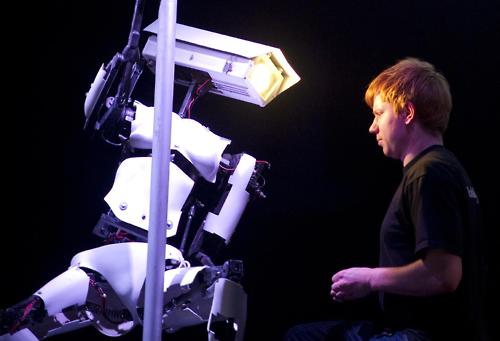
If one has read Bogost’s latest publication, Alien Phenomenology (and if you haven’t, I’d urge you to do so immediately), one would understand Bogost’s view that the new aesthetics misses out not just speculating on the hidden lives of objects other than computers and humans, but it also hovers on the inescapable problem of anthropomorphising machines and objects to within an inch of their lives. The alien aesthetics challenge is provocative.
“[T]his Alien Aesthetics would not try to satisfy our human drive for art and design, but to fashion design fictions that speculate about the aesthetic judgments of objects. If computers write manifestos, if Sun Chips make art for Doritos, if bamboo mocks the bad taste of other grasses–what do these things look like? Or for that matter, when toaster pastries convene conferences or write essays about aesthetics, what do they say, and how do they say it?”
There is an interesting discussion to be had in OOO about the usefulness of anthropomorphising the infinitesimal non-human relationships between the properties of things. Whilst others (including Bogost) see it as an inevitable factor of being one finite human entity amongst a crowd of other finite entities, I see it as a hinderance.
In particular, I’m interested in the way the new aesthetic never manages to access computation ‘just’ as it is. It only takes computation seriously when it functions as a qualitatively intelligent system, which meets or surpasses rational intelligence, or, it directly flips into “dumb tools” of (mis)communicative manipulation for the whims of human mental acts.
But I digress. Last year Bridle released a book called “Where the F**k Was I?”, which accurately sums up the mentality of the movement. The really interesting element of the new aesthetic is that it presents genuinely interesting stuff, but Bridle’s delivery strategy is set to ‘gushing disorientation’. At present, it’s the victim of the compulsive insular network it feeds off from. It presents little engagement with the works themselves instead favouring bombardment and distraction. Under these terms, aesthetics only leads to a banal drudgery, where everything melts together into a depthless disco. Any depth to the works themselves are forgotten.
Memes require instant satisfaction. Art requires depth.
Featured image: ‘Promised Land’ design of transmediale 2k+12
Everything is not connected was the title of one of the talks organised as part of the in/compatible symposium at transmediale 2k+12 (2012), precisely the keynote speech of Graham Harman for the section titled systems. But this year’s programme of transmediale was all about connectedness, or I’d better say, about a curatorial structure of connectedness and subtle linkage.
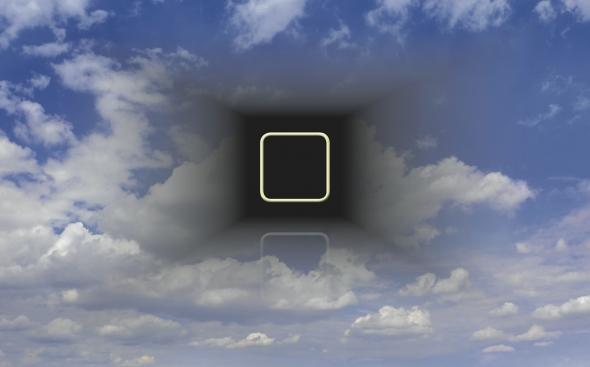
The festival’s format was one of visual and conceptual reminders, and this became evident at the very beginning and during the opening ceremony, in the auditorium of the the Haus der Kulturen on the 31st January.
At the moment of opening a power point presentation, the new artistic director Kristoffer Gansing seemed to experience a technical problem as his file would not open. A technical assistant was then called on stage to fix it, and while we all giggled and looked at each other thinking that this was somewhat like a paradox for a festival devoted to the exploration of art, technology and media culture, we soon realised that the dooming technical failure was a pretext for one of the Prepared Desktop performances by glitch-artist jon.satrom.
Thus, from the very start, we experienced what Gansing often defined as a festival which “is an incompatible being”, suggesting that the 25th edition of transmediale would be different, perhaps more oriented to a multidirectional engagement with its audience and, surely, aimed at making us aware of how much technology is intrinsically part of our everyday lives – physically, mentally and also politically. It seems that Gansing had worked towards making us feel like explorers in order to experience what he described in his curatorial statement as the “in/compatible moment”, the “moment of stasis” resulting from the clash between things that were supposed to flow and converge peacefully within a system. That unforeseeable clash generated by an incompatibility which, according to him, is to be seen (and perhaps also sensed) as a moment full of potentials, as a gap which allows a new rearrangement of the elements of a given system – be it artistic, social, economic or political.
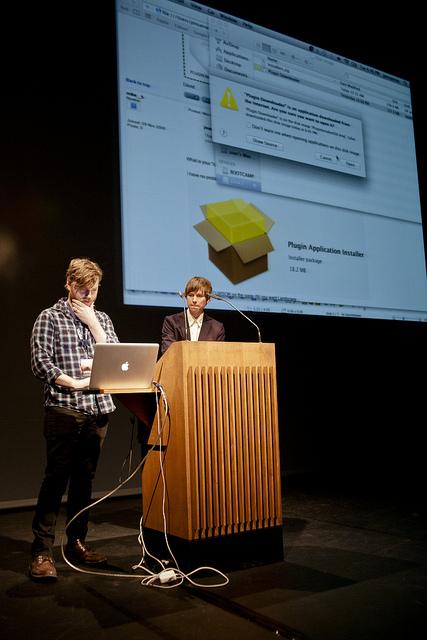
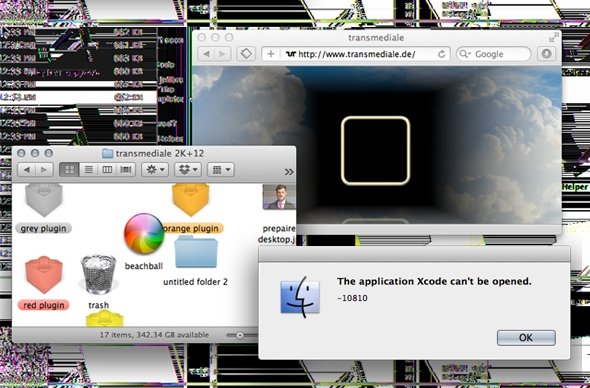
This ‘curatorial tactic’ marked the rich programme of transmediale 2012, which spanned from exhibitions to academic research networks, from online artistic interventions to talks and live performances – worth a mention is also the overall design of the festival’s contextual material, called the Promised Land design theme, which with its retro digital-pop aesthetic [1] seemed to have been devised to reinforce the idea of the clash, the tensions at work within the notion of technological convergence (“the myth” of contemporary society), starting from the very aesthetics of it.
The connectedness I mentioned above is very tangible when looking back at the main themes discussed at the in/compatible symposium – which was divided into three thematic segments:
systems, publics and aesthetics – in that they could be found as extensions across the whole programme, which in turn was developed across six sections:
1- the exhibition Dark Drives. Uneasy Energies in Technological Times curated by Jacob Lillemose
2- The Ghost in the Machine performance programme curated by Sandra Nauman
3- the video programme Satellite Stories curated by Marcel Schwierin
4- 25 Years, a series of events, amongst which talks and video screenings, about “areas of conflict between old and new” that were devised to mark the 25th anniversary of the festival
5- Featured Projects, a series of special parallel projects, such as web-based and site-specific
interventions
6- last but not least, the new addition of reSource for transmedial culture, an “interface between the cultural production of art festivals and collaborative networks of art and technology, hacktivism and politics” presented as a series of ongoing events (workshops, discussions, lectures and performative interventions) curated by Tatiana Bazzichelli.
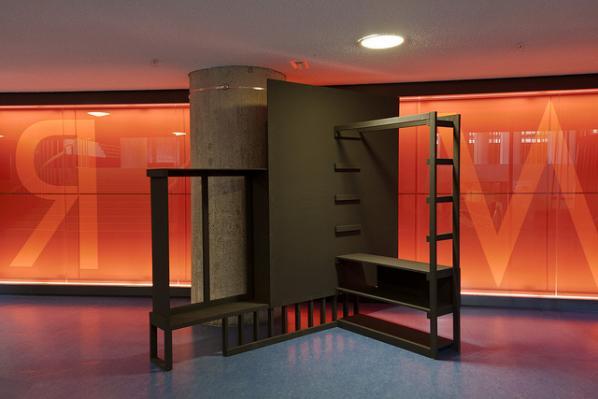
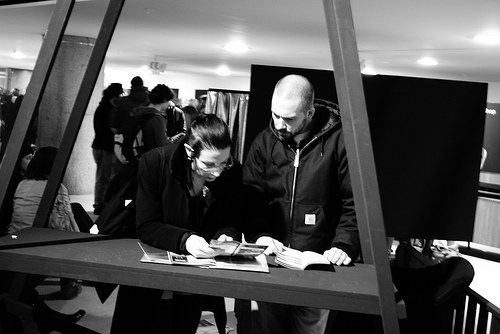
Taking a step back to look at the overall thematic framework of the festival before digging into the specifics of each programme, what should be emphasised is the effort that was made to strengthen the transdisciplinary nature of the festival as a whole. In fact, each section of the programme inserted itself into the wider discourse of cultural production; putting a stress on how deeply technology is intertwined with the every day while looking at the relationship between art and technology from a socio-economic and political perspective that was permeated by an historical orientation. And the latter is precisely what makes this 25th edition different from those I had experienced before.
Gainsing’s perspective – as it was often stated by his collaborators throughout the festival – is that of a media archeologist; and in this sense he occupies a specific place in the media theory-scape of the city of Berlin, which houses the Institute for Time Based Media (Berlin University of Arts) where Siegfried Zielinski is the Chair of Media Theory. As many might know, Zielinski is the theorist who coined the term (or better still, founded the field of) media archaeology with his book Deep Time of the Media (MIT Press, 2002). I would then say that the methodological approach of the artistic director, as well as that of the four festival’s curators, was the one which looks at a present “linked to a past pointing at a possible future”, adopting a perspective that is different and finds “something new in the old” rather than seeking “the old in the new” (quotes from Zielinski, 2002). This is probably the reason of the festival’s holistic character, of the existence of critical and aesthetic linkage between the various panel discussions and performances, research projects and art installations.
This year’s symposium, across three different but converging angles, looked at the tension between functionality and disruption in order to address how the gap existing between the two has been (and could be) “productively used” by artists, as well as by society at large, in relation to available technology – mostly digital and web-related.
The strong connection existing between all panels – grouped under systems, chaired by Christopher Salter; publics, chaired by Krystian Woznicki; aesthetics, chaired by Rosa Menkman– was given by the historical approach of their explorations into the present. Their positions were those according to which it is not technology that impacts society, but it is almost the reversal: it is society – and artists – who, with their behaviours and actions, transform it, generating a new language and new possibilities within established systems, or failing systems. One way to embrace this type of perspective was described by Graham Harman in his keynote speech: it is through differentiating “between background and foreground” and bringing the latter “into consideration”, through accepting obsolescence as something inherent to the state of the technological thing and through embracing the fact that mediums change, that new ways of thinking and understanding reality can be established.
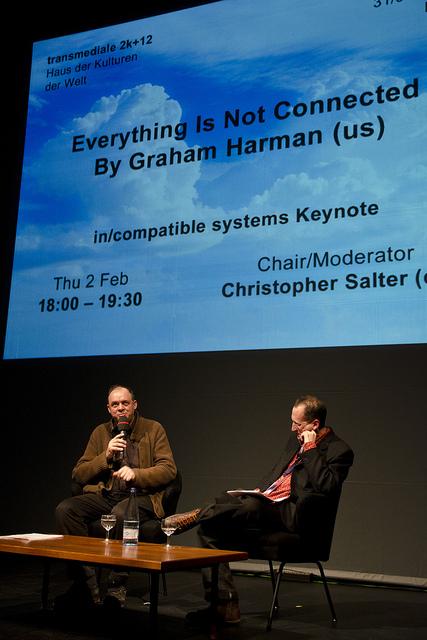
In this regard, the in/compatible aesthetics panels brought about interesting paradoxes in relation to media archeology and technological historicism, such as the necessity to move away from nostalgia for the past and avoid what could perhaps be termed as techno-romanticism. Through a series of panels, spanning from Uncorporated Subversion. Tactics, Glitches, Archeologies to Unstable and Vernacular. Vulgar and Trivial Articulations of Networked Communication, this section of the symposium presented a variegated array of artistic and research practices (from artist Olia Lialina to media theorist Jussi Parikka) that are concerned with establishing methods for challenging given systems, their codes and protocols, in order to establish new languages and modes of operation. All of them presented different artistic scenarios embedded in current socio-cultural frameworks, stressing the fact that “cultural history is shaped by users more than its inventors” (quote from artist and programmer Dragan Espenschied‘s presentation during the Unstable and Vernacular panel).
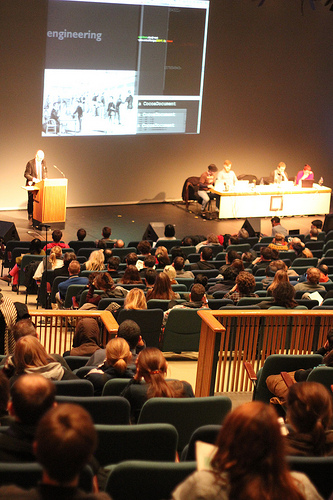
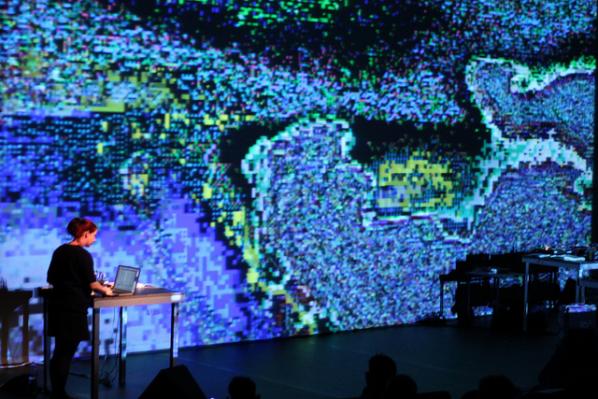
The publics section dealt with “forms of activism and social resistance” that emerge from incompatibility with the economic-political systems. In the instance of the Norifumi Ogawa in his talk Social Media in Disaster, during which he gave a very detailed insight into the “productive and effective” uses of social media during the recent Japanese earthquake and the consequent accidents at the Fukushima’s nuclear plant.
According to the exhibition curator Jacob Lillemose, Dark Drives “explores the idea that uneasy energies exist in technological times” and offers “a thematic reading and an historical mapping of the last fifty years, expressing a critical attitude to existing phenomena as well as exploring possibilities of reinvention”. And it does so with “no promise of overcoming” them (quotes from Lillemose’s curatorial statement).
In fact, the exhibition included works by 36 artists spanning different cultural fields as well as periods. The inclusions ranged from Ant Farm’s Media Burn, Chris Burden’s Doorway to Heaven and William S. Burroughs/Antony Balch’s The Cut-Ups (late 60s and 70s) to Art 404’s 5 Million Dollars 1 Terabyte, Constant Dullaart’s Re: Deep Water Horizon (HEALED) and jon.sotrom’s QTzrk (2010/2011), all while moving through the practices of artists attached to the net.art movement, such as Heath Bunting’s Skint – The Internet Beggar and JODI – the latter with a new light installation, LED PH16/1R1G1B, dated 2011–. Included were also works produced in the 80s by music bands like SPK with their Information Overload Unit. Not only, but the show also presented works which are usually not associated with the conventional art circuit, such as the TV programme Web Warriors produced by Christopher Zimmer (2008) and the music video Come to Daddy by Chris Cunningham/Aphex Twin (1997), along with, as a reversal, old(er) media-oriented work, such as the series of computer prints Leaves by Sture Johannesson, which can be read as early pieces of conceptual art.
This condensed list is to say that the amount of artistic and cultural material on display in the exhibition and the trajectories that it opened were broad to such an extent that Dark Drives functioned more as a general narrative survey than a show with a clear proposition. It was a survey of how uneasy energies might materialise as consequences of the modes and methods in which technology is used and understood, with no much distinction drawn between technology in electronic, computational or digital times.
Dark Drives did not aim to address further its initial statement, nor to narrow down the kind of relationships (and their reasons) between historical instances and contemporary ones; and from my perspective this was its flaw. However, this is the kind of exhibition that a festival like transmediale eventually needed, because to my knowledge this sort of display and curatorial approach had not been presented before: an exhibition which finally embraced the inclusion, with no hierarchies or differentiation in terms of choices of display, of works conventionally shown in gallery spaces along with those traditionally related to (ahem) the still-existing ‘niche of new-media experts’.
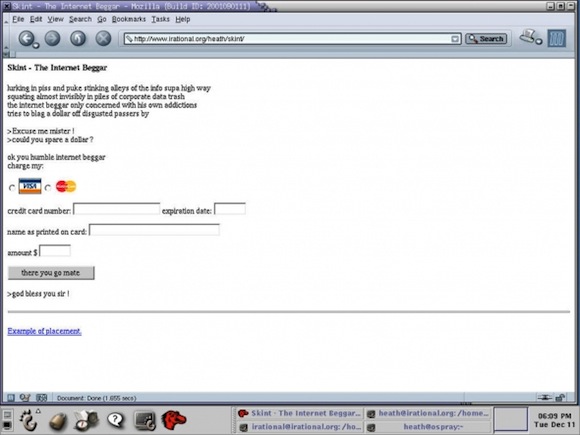
Dark Drives might not be a very daring exhibition if placed outside the context of a media art festival like transmediale, but it is certainly almost subversive in this context, and in comparison with its precedents. The exhibition installation was clever and atmospheric and, as it was for the festival’s format, it was dotted by visual and aesthetic reminders. I’ll give you an example amongst many and various ones that you could have spotted in the show: formulas by Peter Luining (2005), which is a video about manipulating a screen-grabbed image in Photoshop till it becomes a black screen, was shown just a work before jon.sotrom’s Qtzrk (2011), another video based on the process of image deformation – in this case through the use of QuickTime 7; the latter, was, in turn, shown just another work before Heath Bunting’s Skint – The Internet Beggar (1996), a website that operates as a service through exploiting the potentials offered by the network system. The three works all adopted the framework of computer desktop as a display platform for their artistic interventions, but also as a production space. And although each artist’s agenda and research area were different, their proximity made these distinguishing elements more evident, highlighting various ways of activating modes of production that diverge from those of the system within which these artists operate.
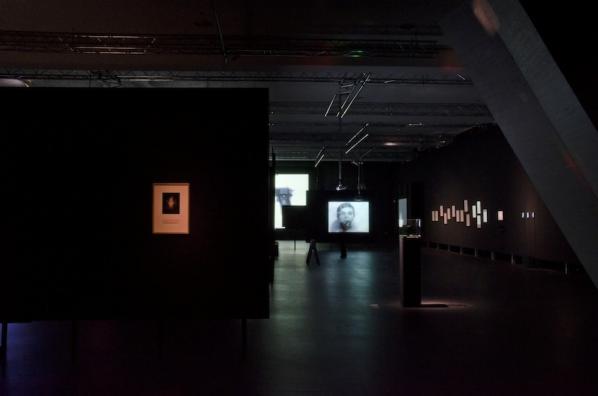
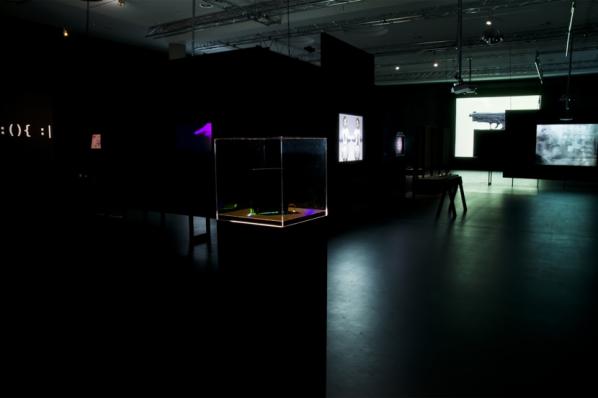
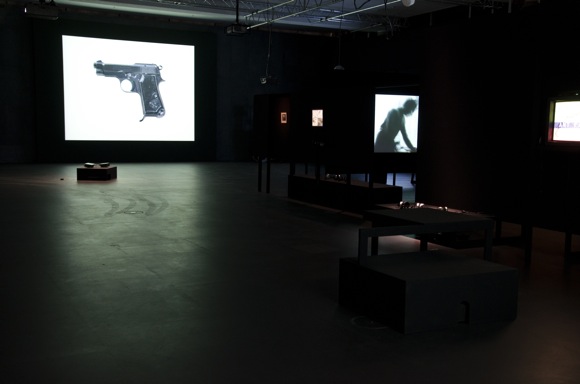
Similarly to what I have just described, it was Dark Drives as a whole that guided the visitor all the way through its display towards specific thematic directions, which were suggested by the installation in conjunction with the many visual and aesthetic links. But simultaneously, the visitor would also be free to follow the other and many trajectories arising from the content of each specific work, and this flexibility made the exhibition an attractive narrative territory ready to be employed for further explorations.
This section of the programme has been devised as an ongoing project by curator and researcher reSource is an initiative that started before transmediale festival with the gathering of an international network of PhD researchers for a conference and workshop held at the University of Arts in Berlin last November. The outcome of this collaborative network was launched on the second day of the festival, in the form of a research newspaper titled World of the News – Thank you & Goodbye . This newspaper operates as a platform in which an array of researcher, most of whom practising artists, presented a series of essays and interviews looking at the “unresolved questions and paradoxes of media technology” and how they might impact (and redefine) not only artistic production but also research processes and academic conventions, such as peer-review systems or the definition of what is currently accepted as ‘proper research’ within the academia.
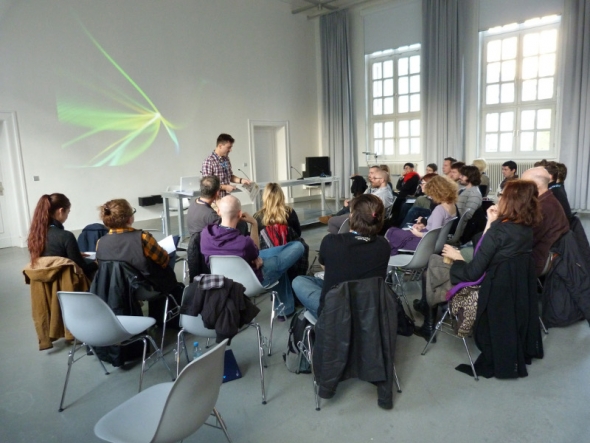
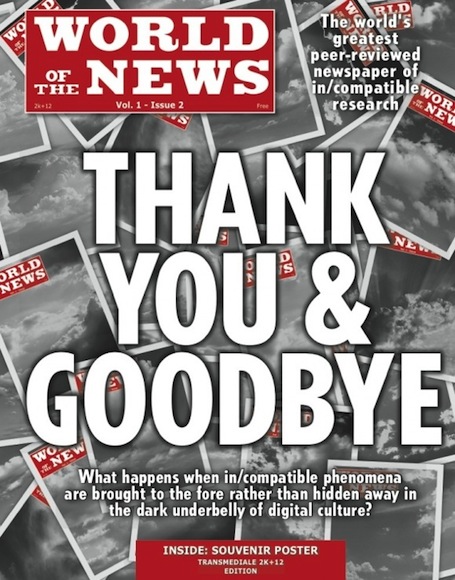
World of the News gathers a very well-thought through research material, and it does challenge academic formats, bringing forth the necessity (and preciousness) of collaboration and dialogues across disciplines, forms and formats.
The above is only one of the activities that were part of reSource; in fact, its programme was divided into five different sub-themes, Methods, Activism, Networks, Markets and Sex, each of which ranged from panels to presentations and workshops.
One of the proposed panel was titled Coded Cultures – Sub-Curatorship Beyond Media Arts and drew on a previous event organised by the group 5uper.net in Vienna, Coded Culture: The City as Interface (2011). Although aimed at addressing questions about curatorship and media art festivals, thus the public sphere, I wonder why curatorship as a practice within the field of new media and, supposedly within what was termed as “beyond new media art”, were not discussed more in depth, especially given the changes that transmediale exhibition itself proposed. If Joasia Krysa presented her specific approach to curating as a system that is informed by technology and thus embraces its inherent systems, like software codes and protocols of Internet and digital technology, in order to change the hierarchy of power; the other invited curators seemed to lack a depth in the discourse. The whole panel unfortunately stranded in general statements such as “technology changes the role of the curator” or “the curator does not want to define itself as a curator anymore, but as a coordinator and a producer”; a cliched conversation that – opportunely – ended with Krysa throwing on the table of discussion Christine Paul’s definition of “curator as filter feeder”.
Many other were the events presented at transmediale, such as the visually stunning, and purely analogue, performance of Joshua Light Show for the The Ghost in the Machine performance programme . At different times during the week of the festival Joshua Light Show performed with different musicians, such as the one man band Oneohtrix Point Never, bringing to light the beauty and magic that old(er) media can (still) give to a public of a “transmedial” festival.
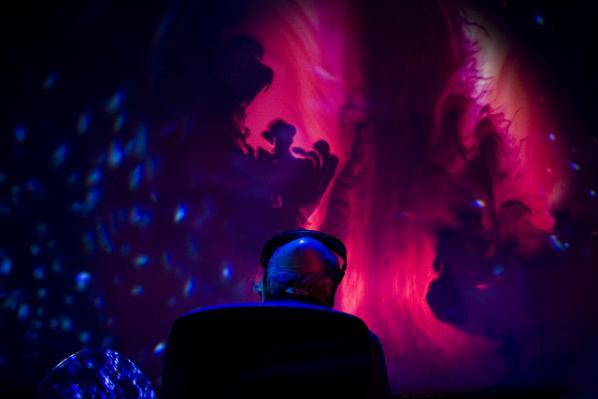
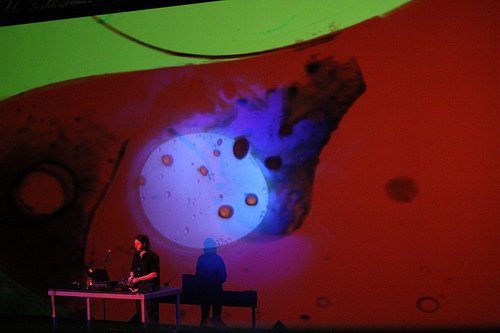
As a final round-up, it is also to be noticed that in/compatible embraced slightly more extensively the sphere of online production and distribution, specifically in conjunction with the 25 Years, Satellite Stories and Featured Projects programmes.
If when browsing the transmediale website you experience some strange episodes, such as pages merging into each other when scrolling up and down, that is because of a site-specific intervention by Danja Vasiliev and Gottfried Haider – the developers of a Content Manipulation System called HOTGLUE which allows to construct websites directly in a web-browser.
Also as part of 25 Years there was a video installation <collaborative documenting / archiving on netart.activities> initiated by artist Constant Dullart and art historian and artist Robert Sakrowski. The duo had devised an open database system which employes YouTube as a repository for net.art projects. This project tackles issues related to hardware and software obsolescence in relation to the (often impossible) access to early net.art projects, and proposes a way of archiving them by filming an ‘audience-in-action’ during the browsing; a strategy which is also useful for tracking users’ behaviours and thus highlight the changes brought about by technological development. Dullart and Sakrowski also led a workshop at the transmediale headquarter, as well as presenting their work during the panel discussion web.video the new net.art?.
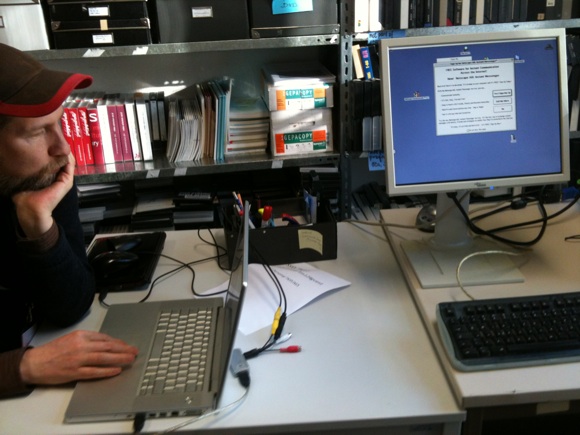

As a last mention, the video programme Satellite Stories was launched at the opening night with Screening Re-enactment Videospiegl, a looped video screening which connected the present of the festival with its history, its archive. In fact the festival first opened in 1988 as VideoFilmFest, and the Videospiegl selection of early videos is now accessible on transmediale website; hopefully marking the start of an archive which will be online and for all.
The online activity described here is certainly not enough for a festival like transmediale, which should investigate thoroughly the relationship between art festivals, artistic production and online distribution; but at least it seems a start for what is a much needed new exploration to be carried out by the organisers.
There is one more issue that I feel was only and often superficially addressed by this edition of transmediale. There were many mentions, in theory, of capitalism and its ramificated systems, such as the closeness of network systems which before were open and the consequent failure of techno-utopian ideals. However, there was little evidence of this in the artworks on display, nor in the site-specific installations presented. I don’t support the idea that artists should be literally political, or activists, but when I experienced jon.satrom’s performance at the opening, it came across as a sort of exercise in showing what can be done through bending technology to generate new languages and approaches to that which is established. In a way it reminded me again that we often operate within boxes, and rarely attempt to challenge the form and format of what is given to us. But then, most of us already know this. And although in/compatible as a festival did not want to give answers but generate a context for formulating questions, as Gainsing specified in his presentation, I felt the need of a next step, a step made of actions, which to me was only fully present in the reSource programme of Tatiana Bazzichelli. When I rethink of jon.sotrom’s performance, and I am very aware I am using him as an example to point to a larger scenario (my apologies to the artist!), I cannot refrain from thinking that the system he was challenging was that of an Apple Macintosh software, built on visual tricks like Spaces, Mission Control, etc; a system that perhaps needs to be challenged at a deeper level since, for instance, its reliance on the exploitation of developing countries workers?

This is just a final thought.
That said, I am really looking forward to seeing how transmediale will move forward, will it take the next step from this initial change?. It will be interesting to see how this merging of historical perspectives, academic research and artistic innovation will stir up more conversations and, as I said, more actions for another exploration of the relationship between contemporary cultural production, media and technology.
Please note: since the richness of the programme, I have highlighted my personal experience of the festival, so that this review highly reflects the choices I made about what to attend and what I (unfortunately) left out from my jammed daily schedule.
The video works of A Bill Miller seem to be at once futuristic and something recalled from our childhood (those of us who grew up with computers in some form or other) in what might be considered as a hauntological affectation that seems like a memory of the future from our childhood, with lines and simplicity of many early computer programs, forming complex ghosts of our pasts across the screen. These are a reminder that what computer graphics can do, doesn’t have to be composed of 3D, with million of vectors and a painful, failing attempt at verisimilitude. Just as theatre, with it’s artificial simplified set designs and symbolism. It can sometimes be more real, offering a greater empathy than a well designed and directed film. Often, there can be greater beauty and compulsion when engaged in simple works than those of greater complexity.
“We exist within a built environment that is constantly mediated by the grid. Grids organize space through coordinate mapping and patterns of development. Grids compress, redisplay, and reorder information. Grids are an enforcement system imposed upon both nature and culture. I respond to this ubiquity by creating gridworks. These forms examine the blurred boundary between the machine and the human – the tool of data collection and the interpretive mind.”
Like a lot of people, my first encounter with the work of A Bill Miller was on the small screen. Despite the numerous festivals and exhibitions that his works have appeared in1, this may be the only chance viewers have to enjoy them. Which is a shame because they really work well when expanded on to a larger screen. Even if you only get to view them on a larger television screen, it’s worth doing. Even some of the work that is small in scale and scope, benefits from being shown on as large a screen as possible. It takes a broader and more encompassing screen to really engage the viewer completely into the work. For some of the black and white work, the overlaying of ASCII letters (reduced to just shapes when not ‘read’ as alphanumeric characters) shows how some works can explore the technical palette of the production software as possible. Which isn’t to say that some of the works aren’t also complex and (literally) multilayered.
There is a psychic landscape explored in Miller’s works. A landscape that feels as though it sits just behind the everyday, observable world we inhabit. Not in a David Lynch, behind the picket fence, kind of way, but inside the mind’s eye, at a point where the brain hasn’t yet coalesced the datastreams of visual stimulation into a recognisable image. It’s that in-between space that seems to at the heart of some of the Gridworks: the spaces between being held in check by the grids. And clean white spaces are beautiful in themselves, but they also divide the elegance of those lines so that the work is about those spaces and the tension of being held in check: stopping them from bleeding into one another. The psychic landscape they map out is the same one that we have to face everyday as we negotiate our way through the ongoing datastream of western life. Work, rest, work, rest, shop, consume. Those days that you feel as though you’ve experienced and understood everything and life begins to blur into one continuous event: all it takes is to step back and really focus on individual moments to remind ourselves that life is actually full of thousands of unique and wonderful moments.
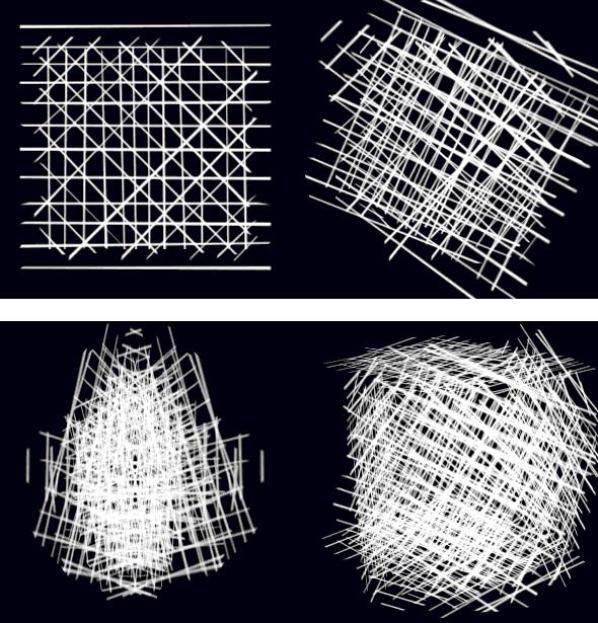
Works like Gridfont 7 suggest that the elegance of a few lines carefully placed can lead to great complexity through simple juxtaposition and rotation of basic forms. Just like so many other things in life, greater complexity begins to emerge from a gradual build up of even the simplest of those elements. Some of the work begins as a few short, hand-drawn lines before they re-adjust themselves and become a hive of geometric shapes: a honeycomb forming from the arrangement and connection of lines. Some works have the colour-bleed of early video work where over-saturated colours refuse to hold their place in the ordered spaces and begin to wander slightly.
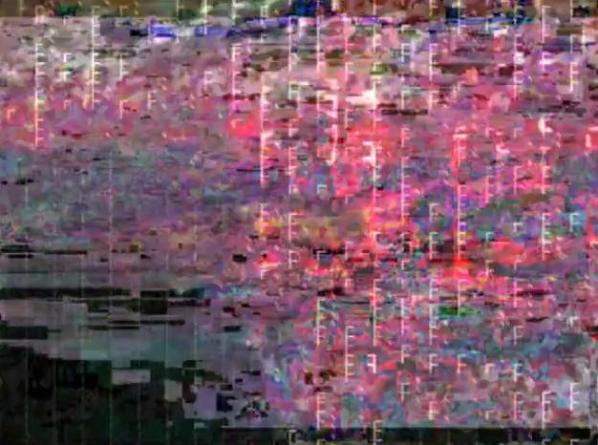
gridworks_textanimation2010 is made from pure ASCII text characters, and “transmits an unreadable message that is aesthetic and abstract.” It’s stark black & white play of the non-text elements of written communication gives the impression of loss and emptiness, like lines of communication broken down through digital channels. This could be extracted from a relationship being held together via email or it could be text messages sent between two unreliable narrators each hoping to convince the other of some shared moment. A line of Xs brings to mind censorship but the blank underlines suggest space for the other party to fill in the blanks that we don’t always admit to when trying to maintain the peace in a relationship. Things are constantly being said, but nobody is ever saying anything to each other. Those are the worst accusations of Internet communications but they’re just as guilty of being performed in every other channel. They just become more visual on the Internet and even more so in works like this.
In case these descriptions suggests that the works are dry and overloaded with metaphor and meaning, they can be enjoyed on their purely aesthetic merits. Gridworks2000-anim09 is a work that can only be described as beautiful in its elegance and deceptive simplicity.
Although these works are positioned within media art, they (like many moving image art work) could be considered as cinema (and let’s face it, cinema could do with a fresh burst from a ruptured blood vessel right now). These are part of a cinema of special effects where the use of computer graphics enhances the moving image and steps away from verisimilitude. As mentioned previously, this lack of verisimilitude is part of the reality of these works. An added element of what makes them hauntological ghosts within the screen.
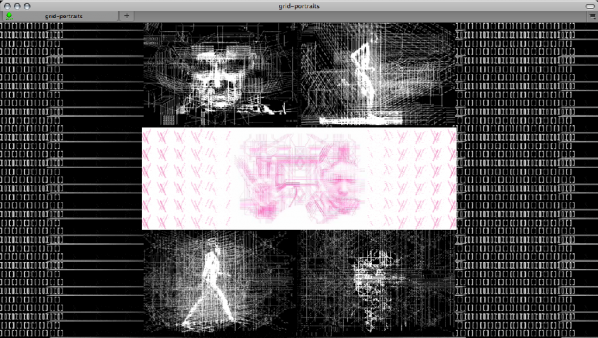
It’s imprinted into the very nature of cinema that it is a ghostly illusion or special effect, either computer generated or produced in the camera that belongs to every moment of cinema’s history. In fact it is even an illusion to believe that we are viewing an actual moving image when we watch a film or video. Either way, cinema is created on-the-fly by our own eye. The trick of creating moving images is to know how the brain responds to them and leverage that response to your own desires. The cross slicing of lines in Miller’s Gridworks feels so much like early computer graphics that at times it’s hard to step beyond thinking about technology’s desire for the new and the increasing momentum of the special effect algorithm and find the beauty in their simplicity. It’s in there and doesn’t take much effort to uncover. Like a good oyster in a restaurant, the reward can be unusual and pleasurable, but you have to get in and expend some energy to extract it.
FILE RIO 2012, Electronic Language International Festival, Art Galery of Oi Futuro, Rio de Janeiro, BR, Mar 12-Apr 8th
Scan2Go, New Media Caucus year long online exhibition, Released at CAA 2012
<terminal> monitors, Austin Peay State University, Clarksville, TN, 2/20-3/2
A/Vworkssssss, One Night Event/Performance, Borg Ward Collective, MIlwaukee, WI Jan 3
Streaming Festival 6th Edition, Het Nutshuis, The Hague, Netherlands, Dec. 1-18 2011
FestivalMulti2011_Especial – Curator David Quiles Guillo, Video Art Program, Rio de Janiero, BR, Nov-Dec 2011
Sheroes, One-Night Interactive Installations (Monthly), Toronto, CA, Nov. 18 and Dec. 23
GLI.TC/H Chicago – Live Video Performance, Chicago, IL Nov. 3-7
GLI.TC/H Program at FLIP Animation Festival, Birmingham, UK, Oct. 29
Punto Y Raya Festival, Museo Reina Sofia Madrid, November 3-6, 2011
BYOB Sao Paulo, Rojo Nova Sao Paulo, Oct. 29
Video On Paper Zine http://videoonpaper.tumblr.com/
3ra Convocatoria Belica, Valencia, Venezuala, September 2011 http://mvs.260mb.com/index2.html
I AM NOT A POET Festival, Edinburgh Aug.8-21 http://tkunst.wordpress.com/
Darko Aleksovski interviews OPA (Slobodanka Stevceska and Denis Saraginovski). OPA (Obsessive Possessive Aggression) is an artistic collaboration, based in Macedonia, whose focus is researching the social, cultural and everyday issues, as well as the ways of looking, thinking and behaving of a certain community in the shifting social and political conditions.
Their project entitled “Bollocks” is a complex and yet very simple interactive installation, made out of a video/image projection in a room in which only one viewer at a time is allowed to see it. The project was first shown at the Authorial Through The Appearance 3 exhibition in Veles, Macedonia (2009). Then it was modified in a second version entitled as “Bollocks for Everybody” for the Small Gallery in Skopje, Macedonia. After that the project was shown at the fifth edition of the AKTO- Festival for Contemporary Arts (2010) where it was awarded with the annual Dragisa Nanevski Award for interdisciplinary achievments. The project was also shown in Studio Golo Brdo, Rovinjsko Selo, Croatia (2011).
Darko Aleksovski: “Bollocks” is a project which was shown on several occasions in art festivals and group exhibitions. Once it was exhibited as “Bollocks for Everybody!”. Can you tell us what was first: its idea, or its title?
OPA: Our initial idea was to relate one specific phenomenon of the Macedonian cultural life: much stronger “gravitation” than in the other parts of the world. It means everything is much harder here, for every single “motion” connected to arts and culture, you need several times more energy compared to other places. It could be because of our institutions, or the specific mentality, or the geographical, political and economic situation of the country – it is a matter of larger analyses. However we didn’t have intention to speak about those reasons into this work, but simply to remind of the existence of the issue. That’s why the work (visually) is about seating and waiting. In the video-image we sit and endlessly wait for something to happen. And when the spectator enters, (s)he triggers the sensor and we both leave the image. So the spectator gets nothing and sees an image of two empty chairs. In the Macedonian colloquial speech you would say the spectator gets “tashak” or “tashaci” (Macedonian: ташак, ташаци). So that is the original title of the work – “Tashaci”, given when the work was completely shaped. “Bollocks” is the best English translation that we could find, but it still doesn’t represent the expression best.
And “Bollocks for Everybody” is the title of the second version of the work, created for the windows of Mala Galerija (The Small Gallery) located in a shopping mall in Skopje.
For our solo presentation in Mala Galerija, we made two different settings of the same work: (1) On the windows of the gallery there was a projected video-image of two empty chairs. When the casual passers by trigger the sensor, our figures were entering the video-image facing the spectator. (2) But inside the gallery we installed the original version of the work, which was intended for the regular visitors of the cultural events, this time invited for the official finissage of the exhibition.
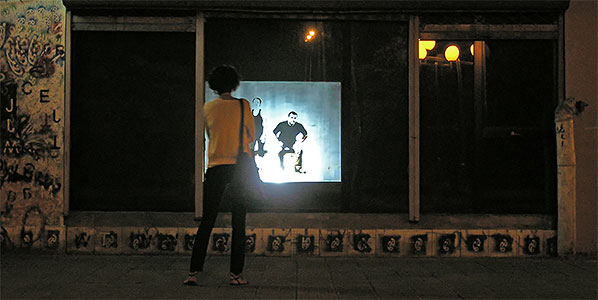
DA: Is the project primarily concerned with the general Macedonian cultural context, or it is dealing with more universal issues?
OPA: We could say that this work is emanated from these local issues, thus it is concerned with the Macedonian cultural context. Translated into the general context it speaks more about the art system, the expectations of the audience, the immateriality of the artwork, about the things that we always miss out, the absurdity, the nothingness…
DA: On one occasion, you say that the inspirational thought about the project is: ‘Art is always in another place’. Does the project speak of ignorant art or ignorant audience?
OPA: It is more about the expectations. About the expectations of where the “real” art should be, what should it look like, what is the art like in other places (always better than our), while we miss the things that are happening (or could happen) here, in front of us. One other interesting interpretation of this thought is that the art is happening during the process of creation. The artist touches it for a moment, and everything that we see as an exhibited object is only a document, a trace of the existence of the art, a way for the artist to share with the rest of the world what (s)he had experienced.
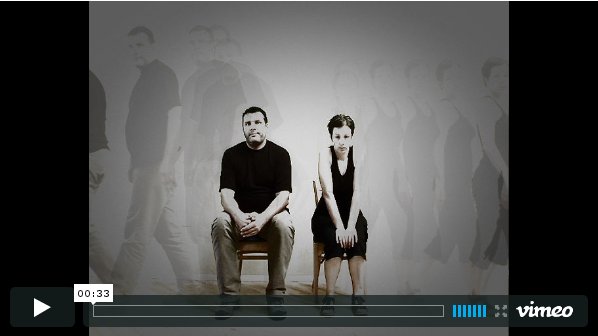
DA: Do you think interactive art is one of the easiest ways to communicate with the audience today?
OPA: It is one of the ways, but it doesn’t have to be the only or the easiest way. Anyway the art today should be in the things that surround us, or incorporated into our everyday life. It should reach us other ways than just through the galleries. It should try to surprise us, confuse us, shake our solid image of the world and make us think and reconsider our attitudes.
DA: How do you feel about joking with/ in art? Do you think a joke in an artwork should be considered a serious statement?
OPA: Humor is one very helpful tool to address the social and the political issues, or the things that bother you and the things that hurt you. It doesn’t mean that if the work involves humor it doesn’t have a serious statement. Thus it is often present in our work. One other tool that we often use in our work is entertainment. Often it is the first thing that catches the audience, it “steals” their time and attention, and than through it we try to convey our message.
DA: Absence is something one finds in many of your works. The absence of connection with reality, absence of objects, even absence of a final artwork, or project. What kind of presence do you think this absence refers to?
OPA: It is really exciting if you succeed, while acting with the art language, to make an artwork that would be communicated but not perceived as an artwork at first. In that case, the work has a direct communication with the audience, not burdened with the fact that art has “special place” in our society. It becomes a kind of subversion of the everyday life – you can experience art without knowing what’s in front of you, yet the situation you have experienced, is an artwork. What we do in our work is about creating “situations”, or often creating the artwork together with our audience. Whether this artwork is either immaterial or difficult to possess.
Featured image: Lynn Hershman Leeson Portrait (Photo Credit: Ethan Kaplan)
Woman, Art & Technology is a new series of interviews on Furtherfield. Over the next year Rachel Beth Egenhoefer will interview artists, designers, theorists, curators, and others; to explore different perspectives on the current voice of woman working in art and technology. I am honored to begin this series with an interview with Lynn Hershman Leeson, a true pioneer in the field who has recently produced !Women Art Revolution- A Secret History.
Over the last three decades, artist and filmmaker Lynn Hershman Leeson has been internationally acclaimed for her pioneering use of new technologies and her investigations of issues that are now recognized as key to the working of our society: identity in a time of consumerism, privacy in a era of surveillance, interfacing of humans and machines, and the relationship between real and virtual worlds. She has been honored by numerous prestigious awards including the 2010-2011 d.velop digital art and 2009 SIGGRAPH Lifetime Achievement Awards. Hershman also recently received the 2009 John Simon Guggenheim Memorial Foundation Fellowship, an award which supported her latest documentary film !Women Art Revolution – A Secret History.
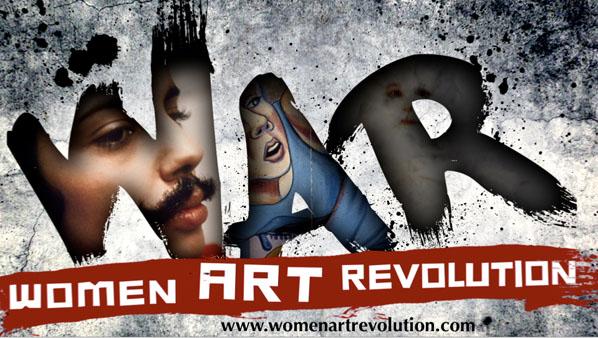
Rachel Beth Egenhoefer: Your most recent project is the film “!Women Art Revolution” which you have been collecting materials for and working on for the past forty years. Why is now the time to present it as a finished work?
Lynn Hershman Leeson: TECHNOLOGY! The film is one narrative, but I’ve put the entire 12,428 minutes online through Stanford University Library, making all the narratives and aterials accessible, so in effect there are no out takes. Also the RAWWAR org archive/website allows people to continue the story online. So the story continues to grow beyond the single narrative, which technology allows us to do now.
Additionally, I wanted to push out into public view the graphic novel, curriculum guide, and the story to affect the legacy while women who created the movement could be appreciated.
RBE: Can you expand on how you see the RAWWAR story continuing online? Or maybe what is the goal of the archive/website? Do you envision people adding to it?
LHL: Yes, it was made specifically so that people, especially younger generations will be able to add information. At the Walker Art Center, they have scanning stations and are training people how to upload work onto the site. My hope is that people from around the world will add materials and it will be a living repository of this type of growing and accessible information.
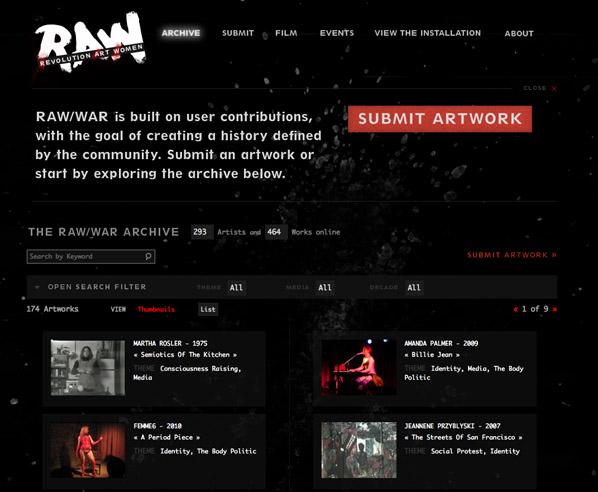
RBE: The film has been touring in the U.S., what has the response been?
LHL: Incredible. It has been in over 60 cities, and standing ovations in San Francisco, Houston, Toronto, Sundance, Berlin and Mexico City. People seem deeply affected by this secret history and seem to appreciate knowing about it.
RBE: Has the response varied either with geography or current events?
LHL: Not really, it seems vibrantly appreciated worldwide despite it being about women in America.
RBE: Can you explain the grammar behind the title “!Women Art Revolution”?
LHL: If you mean why the ! first, it was so we would be listed first, rather than under W. It didn’t work, but that was why we did it originally. It also is a wild exclamation at the start, which is what the movement was.
RBE: The film is described as presenting the relationships between the Feminist Art Movement and the anti-war and civil rights movements, showing how historical events sparked feminist actions. Do you see any connections to be made with the current Occupy Movements?
LHL: Yes, absolutely. In some ways because it is about how the disempowered and invisible people were able to gain their place in culture; how people who had their voices silenced were able to amplify their message and subverted social systems, with work that expressed censorship, freedom of expression, social justice and civil rights and directly made political change. It is an inspiring story of reinvention.
The goals were clearer than with Occupy. But the disenfranchised edges of culture is similar.
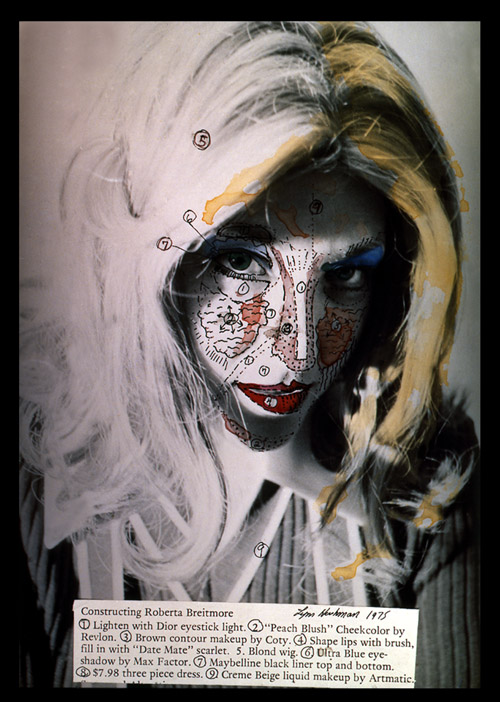
RBE: A lot of your early works dealt with issues of identity. How do you think the notion of identity has changed over the years?
LHL: It has become more technological, more global, more cyborgian. We now, because of the internet are linked globally and that has resulted in a “hive mind” and in turn, that seems to be a cohesion and holding together the individual fracturing that had occurred over the last two decades
RBE: Can you expand on the idea of the “hive mind that seems to be holding together the individual fracturing”? What makes up the hive, what is fracturing us? Is this good or bad or neither?
LHL: The hive is social media and people who participate in the Internet grammar. There is a congealing through access to information. As individuals, I think we have been fracturing, rupturing, split for decades and have become multi faceted and multi taskers. But there’s a price in the lack of personal cohesion that results. I think that having a common reference or ‘hive’ is a very good thing, as it tests our idea of ‘reality’, and serves as a hub of communication.
RBE: Do we make our own hives? Or are those defined for us (either by others/ FaceBook/surveillance/ etc)?
LHL: We are all part of global re-patterning that is happening live on a global scale and it is naive to assume we can act independently or not be connected or affected. We are constantly challenged, influenced by peripheral and pervasive information and in turn we have become fodder for surveillance and digital integration.
RBE: Some contemporary artists and thinkers have been critical of our online selves and physical selves. Sherry Turkel for instance has described people as “performing themselves” online by constantly updating Facebook profiles, tweets, etc to show an ideal version of ourselves. Can you draw any distinctions between virtual, physical, and performative selves?
LHL: I think we perform ourselves every day, not only on social media, but in all interactions. I do not think all images or versions of ourselves are ideal. There is absolutely a difference between real/physical and virtual selves. They each have a context, reference and function. As far as being performative, that depends upon the distinction used for how it is used. One can, in fact, consider life itself and everything one does as performance.
RBE: This interview is going to be part of a series of interviews with women working in Art & Technology. What do you consider to be important today about being a woman working in art & technology?
LHL: Ada Lovelace wrote the first computer language, Mary Shelley envisioned artificial intelligence, Hedy Lamar invented spread spectrum technology, which led to cell phones. Women have been enormously prescient in visioning and affecting the future of the world through technological linkage systems.
RBE: Do you think it is still useful to discuss the female voice as a separate voice in the field?
LHL: I think the female voice is critical in all aspects of the future and should not be limited to a category.

RBE: One of your earlier works, LORNA, depicts a woman who never leaves her apartment and becomes more and more fearful as she watches ads and news on the TV. Some might say television media has gotten far worse since the 80s in both fear mongering and controlling conversations. What do you think about the current state of the media?
LHL: Right, the idea of media as totally affecting our outlook has shifted. Media is no longer omniscient! The 99% are activating their voices and warbling into existence. There are other problems with social media… deeper ones that splay into the cracks of fractured identities and insist on more disruption and lack of focus. But perhaps that is what is affecting our constantly changing evolution.
RBE: If LORNA were around today what would she be thinking or doing in her little 1 room apartment?
LHL: Blogging and all forms of social media including excessive and obsessive shopping, no doubt. She would probably not really be agorophobic either. She would, however, probably be paranoid. She would use a webcam and notice all the ones surrounding her no matter where she moved.
RBE: Do you have hope for change in the future?
LHL: Hope? It is inevitable. I believe in the next generation! They always, in their amnesiac optimism re invent the future in ways that can’t be predicted.
RBE: You have been involved in academia for some time, what do you think is important to be teaching in the Universities right now?
LHL: Independent thinking and creativity, the maintenance of ethics and a profound sense of humor!
RBE: Do you have any new projects you are working on?
LHL: Yes, at least 3 .A new film which is part 3 of my trilogy about the evolution of the human specis, a new installation that uses scanned beating heart cells, and a long term project about Tina Modotti.
Find our more on Lynn Hershman Leeson and Woman Art Revolution here: http://www.lynnhershman.com/http://womenartrevolution.com/
Taina Bucher interviews curator Gaia Tedone about her latest online curatorial project called ‘Is Seeing Believing?’ as part of the TRUTH programme at or-bits.com, an online platform for the display of contemporary arts and production of new works. Born in Italy, in 1982 Gaia Tedone holds an MFA in Curating from Goldsmiths, and has for the past year been one of the curatorial fellows at the Whitney Independent Study Program, New York. She has been involved in a number of art projects and worked with institutions such as Whitechapel Gallery, James Taylor Gallery, The David Roberts Art Foundation and Tate Modern.
Taina Bucher: Tell me a bit about your background for doing curatorial work. How did it get started and what are some of the thematic interests that have been important to your work?
Gaia Tedone: I started doing curatorial projects in London, where I was living and working for the past five years. The time spent at Goldsmiths was extremely formative from a practical and intellectual point of view. I was involved in a number of projects – some of them in collaboration with institutions in London, such as the series of talks Curating Fictions organised at Whitechapel Gallery, others were developed within the academic context, as for instance IM magazine and the publication A Fine Red Line (A Curatorial Miscellany) which I edited with fellow curators Isobel Harbison, Ilaria Gianni, Nazli Gürlek, Rosa Lleo and Yannis Arvanitis. The latter experience led us to establish the curatorial collective IM projects – a platform for editorial projects for which I contributed for the following two years.
The MFA in Curating at Goldsmiths and the Whitney Independent Study Program have both helped me to locate my interest in the history of art production within today’s global context and to look at the ways in which specific economic and political contexts shape the production and circulation of art. These two complementary programmes of study informed my research interests, which are located at the intersection between the fields of new media and cultural studies.
This year, within the context of the Whitney Program, I was exposed to a number of seminal authors and texts that since the 70s have contributed to the development of the field of cultural studies, and I was deeply inspired by the recent work of David Harvey and the political philosopher Chantal Mouffe. This intense year of research has informed the conception and realization of the exhibition Foreclosed. Between Crisis and Possibility that I co-curated with ISP fellows Jennifer Burris, Sofía Olascoaga, and Sadia Shirazi at The Kitchen in New York.
The exhibition, which included works by Kamal Aljafari, Yto Barrada, Tania Bruguera, Claude Closky, Harun Farocki, Allan Sekula and David Shrigley, took the current housing crisis in the U.S. as the departing point to explore other meanings of the word foreclosure, which also evokes processes of exclusion and a shutting down of recognition.
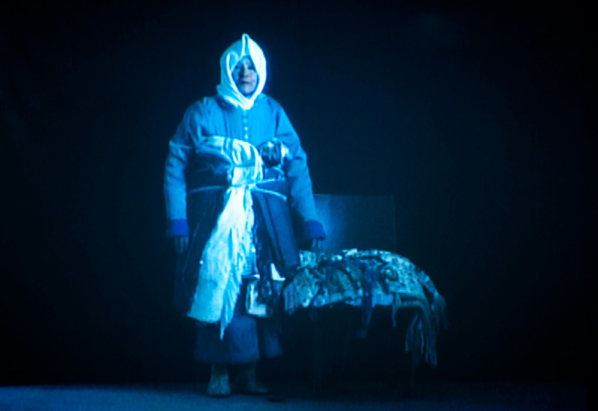
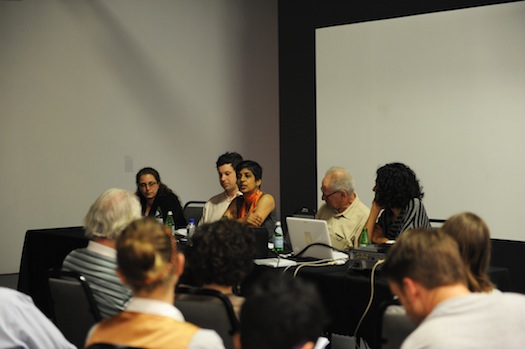
Taina Bucher: How did you get into doing online curatorial work?
Gaia Tedone: I was invited few months ago by Marialaura Ghidini to collaborate with her and Christine Takengny on the autumn issue of or-bits.com. Marialaura had some preliminary thoughts on how she wanted to develop the programme, and after few Skype meetings we established a common ground upon which we built three parallels projects. The programme curated by Marialaura was launched in early October with works by Angus Braithwaite/David Raymond Conroy/Adelita Husni-Bey/Iocose/ M+M (Marc Weis and Martin De Mattia)/Richard Sides and my response followed shortly after that. Is Seeing Believing? is my first curatorial work online.
Taina Bucher: How do you feel about exhibiting art online, what are the challenges and benefits? In what ways does the conceptual work with developing a project online differ from curating exhibitions in a more offline institutionalized setting?
Gaia Tedone: or-bits.com provided me with technical support in terms of coding and web-design, while I was left totally free to develop my own curatorial strategy. My original idea was to build up a True or False web-based questionnaire, mainly text-based. However, the project developed in a slightly different direction and I was happy to adapt its format to the eclectic contributions I was receiving. Once I gathered all the content, I chose to mimic the format of an online newspaper, as this seemed the best visual strategy to actually play with the ideas being put forth while maintaining an inner coherence for each artist’s contribution.
I found the context of the web extremely challenging from a curatorial perspective, as it required the ability to work simultaneously on different elements, from the editing of content to the formalization of a coherent visual output, employing an approach both flexible and rigorous. It felt like a condensed version of a ‘traditional’ show, yet faster in pace and with a different degree of curatorial control. It came together fairly organically. The Web I think poses a number of important questions, especially in relation to the short attention span we generally dedicate to what we read or look at when surfing the net. Would the type of art being produced have to play or interject whit this? How would it change the public’s experience or engagement? These are all open questions for me.
Taina Bucher: What is the idea behind your current exhibition on or-bits?
Gaia Tedone: The theme TRUTH developed out of several conversations inspired from Žižek’s text Good Manners in the age of Wikileaks and a shared interest in somehow questioning the democratic claim of the web as a space of freedom, in light of the recent developments of Wikileaks and of the role that social media played during the Arab Spring. In a world in which everyone can be the author of his/her own news, how do we assess what is true or false? And how is this shifting power’s relationships and individual agency?
Within this larger framework, the project Is Seeing Believing? specifically focuses on the relationship between image and belief and develops from the engagement with two particular images: first, the image of Caravaggio’s iconic painting The Incredulity of Saint Thomas (1601-1603), depicting Apostle Saint Thomas’ unwillingness to believe without direct, physical and personal evidence in Jesus Christ’s Resurrection. Second, the image published in the news showing President Obama, Hilary Clinton, Joe Biden, along with members of the national security team, watching Bin Laden’s death live.
The latter image, which quickly became one of the most publicly viewed in occasion of Bin Laden’s death, claims to present a less crude version of the story, but in fact it does not. On the contrary, it carries the absence of the image we are actually looking for – the one of Osama Bin Laden’s death body – affecting the viewer on multiple levels. On the one hand, by making the relationship between political power and media control even more visible; on the other, by acknowledging the necessity to see an image in order to believe in a fact. Then again, to what extent does it really matter if what we are looking at is the actual event or other people witnessing it? Has seeing become believing? These are some of the questions and preoccupations that have animated the conception and realization of this online project.
Taina Bucher: ‘Is Seeing Believing?’ is an exhibition displayed in the format of a newspaper. Who are the contributing artists?
Gaia Tedone: I began by approaching a number of artists, designers and activists whose work I admire and who, in my opinion, share a highly critical approach towards the production and reception of images and often employ a strategic use of the media in their practices. Some of the contributors, like for instance Jon Rafman, Nate Harrison, Alterazioni Video, The International Errorist and Foundand, have used the web extensively as the source and context of their works, others as for instance Azin Feizabadi and Oliver Ressler & Martin Krenn brought to the project their experiences of artists working within specific public spaces. A couple of interventions, such as the ones of MDR, Sadia Shirazi and Alessandro Sambini were specially conceptualised and produced for or-bits.com.
The idea of assembling them within the format of an online newspaper came at a later point, once all the material was gathered. It also pays homage to The New York Times Special Edition produced by The Yes Men and Steve Lambert and distributed for free in the streets of New York City in 2008. The paper announced the end of the Iraq’s war and changes in the US government’s policies on global warming, embracing for one day the philosophy of ‘All the News We Hope to Print’, at the beginning of President Obama’s administration.
The choice to play out specifically with Al Jazeera’s website was driven by the visual intelligibility of its design and by the desire to locate the project’s investigation within the context of this year political events and the role that social media played within the Arab Spring. As Sadia Shirazi interestingly points out in her contribution about Wikileaks as a socially engaged practice, if information is the terrain of war, what better context than a newspaper to put forth such urgent questions?
Taina Bucher: It is interesting that you say your or-bits contribution seeks to challenge the debate on image and truth by embracing the visual volatility of the web. Yet your newspaper is surprisingly static to be a webpage. Was this a conscious choice?
Gaia Tedone: This is a pointed observation. The webpage attempts to create a visual cohesiveness to the project, but it also asks the viewer to be actively engaged with the navigation.
I would see it as an attempt to fix in time the volatility of the web, maintaining in its content the associative and eclectic character of a browsing session, yet proposing a specific vantage point. In a sense it is like an exhibition, in which the works are in dialogue with each other, but have their own space and are framed by the specificity of the context.
Taina Bucher: Your project seems to suggest that we have no choice but to believe the image. Why is that? Haven’t we by now learned to be critical of the image, of its truthfulness and representability? Just think of Judith Butler’s book Frames of War where she addresses the dramaturgy of the Abu Ghraib photos. Susan Sontag already argued in 1977 that visual representation had become a cliché, that we are constantly bombarded with sensationalist images that numb our sense of believing. In what ways do you think, then, that the explosion of images online has somehow led to a diminished capacity to be critical?
Gaia Tedone: What interests me is the relationship between the access to images and the mechanisms of power that regulate this access and how this relationship is becoming more sophisticated and problematic within the context of the web and the role that social media play in the diffusion of images and information.
I think that a critical approach towards the reception of images is a condition that needs to shift and constantly adapt itself to the development of the image’s status itself. It cannot be separated from the historical and technological context in which images are produced and cannot be considered resolved as such, as the social and political configuration of the world is shifting also through the news and the images accompanying them.
Through the question Is Seeing Believing? I wanted to direct attention to the individual agency and the possibility for artists to filter, edit and rearrange the information and images they are exposed to, in this way challenging the notion of truth. To quote Siegfried Kracauer, who is also mentioned in the project, and his famous collection of essays ‘The Mass Ornament’ published in 1963: Never before has an age been so informed about itself, if being informed means having an image of objects that resembles them in a photographic sense. Never before has a period known so little about itself. In the hands of the ruling society, the invention of illustrated magazines is one of the most powerful means of organizing a strike against understanding.
These words still resonate powerfully with me, as they crucially point out to the ambiguous relationship between photography and information. Although there is a risk involved in believing in the image – risk that we must be aware of – what happens when the access to the image is negated to us? When this process of identification, compassion and repulsion that images often instigate is no longer accessible? Do we stop believing in reality or do we start to understand it?
President Obama’s decision not to diffuse the image of Osama Bin Laden’s body marks, in my opinion, a very important moment in the history of the images of the last decade.
It counterbalances with its absence 9/11, one of the most photographically reproduced events of this century – the day in which history and fiction met in the brutal instant of a photographic frame. I see this absent image as an occasion to stop, look back and critically reflect on what happened
On 28th October 2011, I travelled to Sète in the South of France to see and review Annie Abrahams’ show Training for a Better World.
The first of two reviews (the second will be somewhat longer and in an academic journal later this year) is now available on DVblog.
What was particularly pleasing about going to the press view and then staying on for the opening proper was the opportunity to engage with the work over quite a long period – some four hours.
About halfway through the evening, I started both photographing and sketching as aides-memoire for my reviews, but I soon began to enjoy the feeling of responding to the work for its own sake, and I began to think about presenting the drawings and photographs (plus some drawings made from the photos two days later, as well as a couple of manipulated photos) as a kind of photo-essay/derivative work.
This is a collection of artworks, texts and resources about freedom and openness in the arts, in the age of the Internet. Freedom to collaborate – to use, modify and redistribute ideas, artworks, experiences, media and tools. Openness to the ideas and contributions of others, and new ways of organising and making decisions together. This collection is intended to inspire, inform and enable people to apply peer-to-peer principles for making things and getting organised together. We hope that all art lovers, makers, thinkers, organisers and strategists will find something for them from this set of imaginative, communitarian and dynamic contemporary practices.
Commissioned and hosted by Arts Council England 2011
Featured image: Installation Speed. Public Space Exhibition Plattform Bohnenstrasse in Bremen September 2006. Aram Bartholl.
Pole Position, Outrun, F1 Racer and Need for Speed are some of the countless racing games that have attracted artists to explore a world of speed and burning rubber. In 2004 Cory Arcangel hacked the old Japanese Famicom driving game F1 Racer and removed, in the same way as he did in Super Mario Clouds, cars and other objects so that the only thing that remained of the game was the road and the landscape rushing toward the viewer.
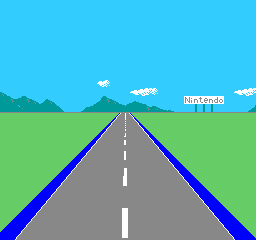
Hacking and modifying videogames is one artistic approach, another approach in Game Art is to transfer virtual objects into real objects. The Swedish artists Simon Goldin and Jakob Senneby in an exhibition called Objects of virtual desire (2005), introduced virtual objects from players in Second Life. The object was then reproduced as physical art as limited edition in an exhibition, exploring immaterial production in a virtual world and how this can be transferred into an economy of material production. “Objects of Virtual Desire exploits the augmented value of immaterial objects to create and market tangible products, thereby reversing the process and highlighting the materiality of the immaterial.” Goldin & Senneby.
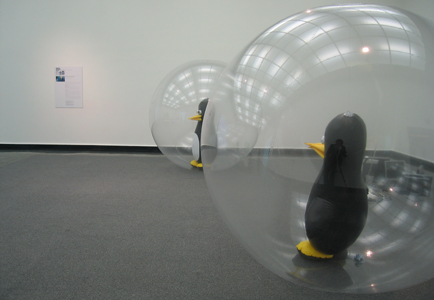
In a similar way both Aram Bartholl and Brody Condon have used virtual objects from Speed racing games. In Speed (2006) Bartholl made a 1:1 scale sign with red flashing arrows and placed the sign at a street in Bohnenstrasse in Bremen. The model to the arrows had he found in the game Need for Speed Underground NFSU where the red blinking signs leads the player on the right track. Condon on the other hand made an exact replica of a Lamborghini Countach from 1985, a model that he found in the game Need for Speed. The big different was that the car was made of plastic branches and there was only the outline of a car, in a 3D program you would say it was the wireframe of a car. What Bartholl and Condons does is that they investigates and problematizes the borderline between the virtual world and the reality by moving virtual and real objects between these two worlds. Worlds that today are more and more integrated and harder to distinguish.
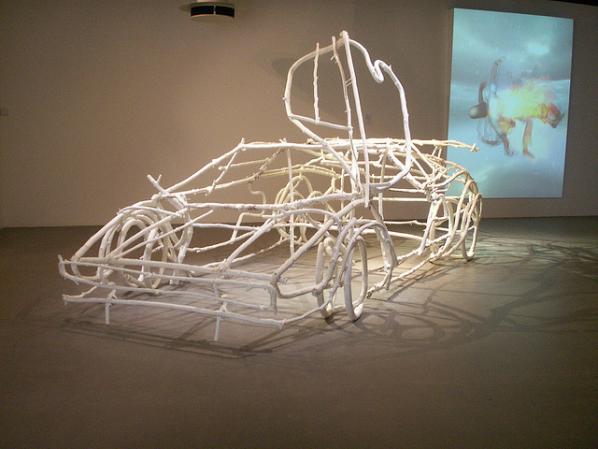
The Dutch artists Marieke Verbiesen is also mixing elements from the virtual and real world in her work Pole Positon. Pole position was a racing game released in 1982 by Namco and was one of the first games to use the rear-view racer format, where the player’s view is behind and above the vehicle. In her installation the background in the game created by a realtime recording of a miniature landscape in perspective. Visitors can interfere in the landscape and be a part of the game by passing by the camera filming the landscape.
The ultimate combination of real and virtual game play is found in Garnet Hertzs work OutRun. Outrun was a game that was created by Sega 1986. Some arcade versions of the game were presented in a red sit down cabinet that looked like a car. Garnet Hertz has used this cabinet version as a model for his work and made a red real car where the front window is replaced with an aracde cabinet. With help of augmented reality the road ahead of you is an 8-bit video game, so at the same time you are playing the game you are driving down the road.
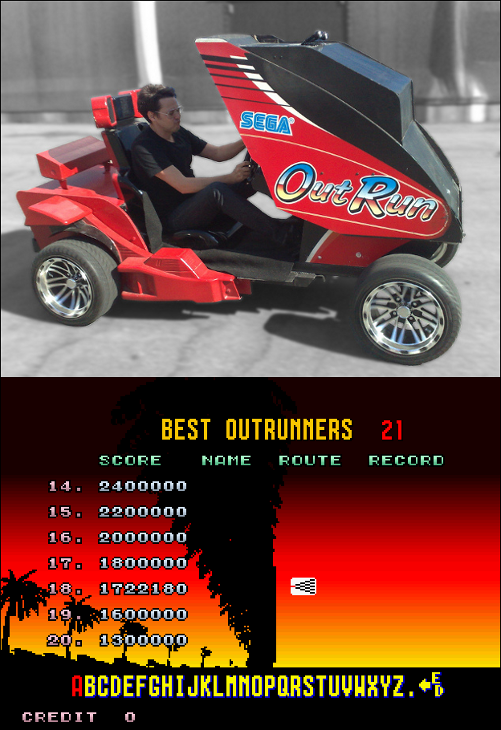
OutRun – Garnet Hertz. Images/video: http://www.conceptlab.com/outrun
“where game simulations strive to be increasingly realistic (usually focused on graphics), this system pursues “real” driving through the game. Additionally, playing off the game-like experience one can have driving with an automobile navigation system, OutRun explores the consequences of using only a computer model of the world as a navigation tool for driving.” Hertz
One thing that you could not blame racing games for is air pollution. In the installation “Colorless, odorless and tasteless” from 2011 this is exactly what you can blame Eva and Franco Mattes for.
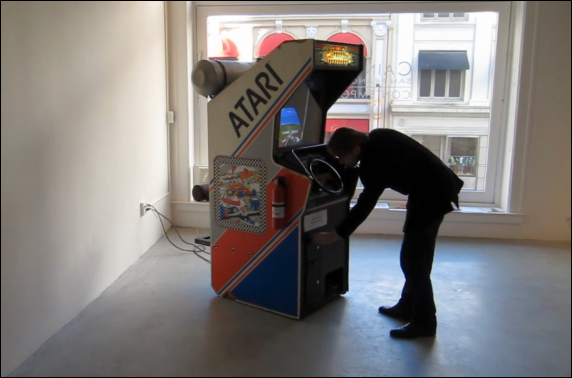
They modified an old Pole Position game and installed a real engine in the arcade cabinet. When the player is driving the virtual car on the screen the room is filled with carbon monoxide from the real engine. So the risk is not only that you run out of coins but you are also gassed.
More of Mathias’s reviews on Furtherfield & bio : http://www.furtherfield.org/user/mathias-jansson
Featured image: Remixthebook Cover
“For us, art is not an end in itself … but it is an
opportunity for the true perception and criticism
of the times we live in.” Hugo Ball.
The challenge in trying to review a book like Mark Amerika’s Remixthebook, is the feeling you can only do justice to the text by doing the same with your review. The apparent simplicity coupled with the multifarious outcomes are intoxicating. You could be mistaken for believing that every possible remix would produce fresh and exciting outcomes. The key of course, is to have good source material in the first place. Also, to have developed a keen eye for what blends and meshes together and what doesn’t. Even the most disparate work requires judgment and prior awareness. Remixthebook asks us to consider the idea of remixology as part of the work of modern artists. The tone and style of the book is a blend of ideas, voices and thoughts with a myriad of concepts, which attempts be the very embodiment of the ideas it espouses.
Amerika explores various precedents for the remixological concept and draws on some known practitioners from the past: amongst them, Allen Ginsberg, William S. Burroughs and Brion Gysin. He explores existing ideas and welds them into his own armoury. Their ideas considered as part of his own creative practice, brought back to the now with new life, in our contemporary networked culture.
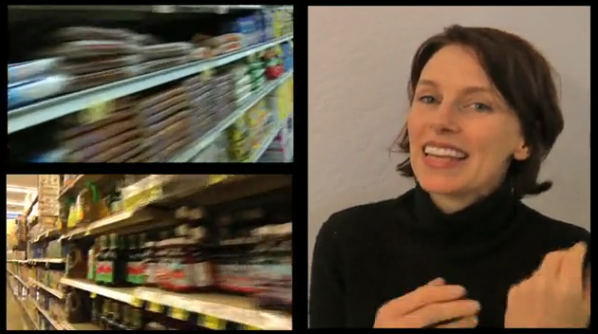
Other than just being a systematic breakdown of the different types of remixing and their potential outputs (or artifacts, as they might be better known in an art critical framework?) Amerika considers the pathways and theoretical underpinnings of remix culture. Having taken this beyond his own practice of the written word and web-based projects, he considers his recent and ongoing VJ work. Blending and collage-making with images during live music performances suggests some of the instinctive, instantaneous ideas that come out of a lifetime’s collecting, collating and absorbing of diverse imagery, words and cultural concepts. It’s within this process that he believes more novel outcomes can arise, against the constant flux of media creation and dissemination. It is the ‘becoming’ of the media artist that is revealed in the live remixing performance.
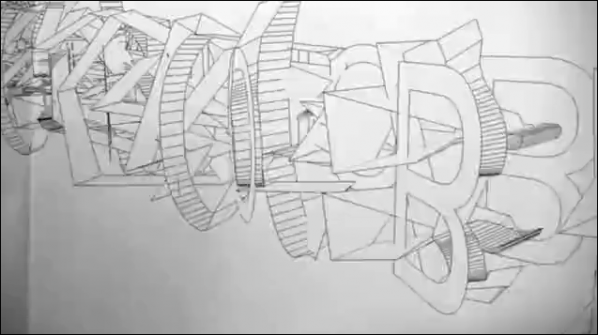
Reflecting on this process of cultural assimilation Mark Amerika, situates remixology within a wider creative output and theoretical framework. This involves a cross hybrid of everyday, mainstream references with high art and ‘high’ theory, all written in his at once complex and convoluted, yet easily read and enjoyable writing style. But like remixology, what looks simple is the result of deep reading and heavy conceptual thinking. This isn’t to say that you won’t have trouble decoding the writing and getting to the heart of his thinking, but it helps if you spend time with the text and allow the rhythms and structures to become second nature to you. Close reading allows the text to fall into place. For example, consider the following extract from the section eros intensification:
Here is where we enter the realm of
what I have been calling intersubjective jamming
which is different than the idea of a Networked Author
or Collaborative Groupthink Mentality that preys
on the lifestyles of the Source Material Rich
and seemingly forever Almost Famous.
It is worth remembering that Mark Amerika is a creative writer first and foremost. He uses theory as a palette from which to draw out ideas and situations for further reflection and to help give some context to the point he is trying to make. The text of remixthebook is an example of his creative practice in action, as much as it is a personal reflection on his attempts to develop a thought process for it. Theory becomes entwined in critical reflection and creative output. You don’t necessarily come to remixthebook for philosophical answers and hard academic points of view, instead you ride the maelstrom of thoughts and conceptualizing to gain a better handle on a way of considering artistic practice.
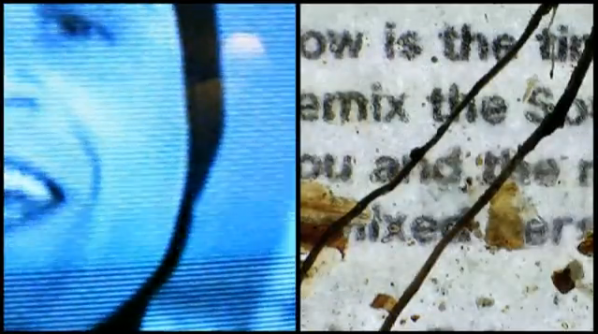
The website of the book (probably a ubiquitous extra for any media art-related publication these days) follows a natural path of inclusion and invites artists to take sections of the book and remix them according to their own aesthetic and remixological preferences. While some of the work brings in extra visuals and places itself in a flowing context of media streams, allowing different work to become part of the project, Rick Silva’s The Isarithm sources Amerika’s Sentences on Remixology 1.0 and explodes them out of the screen and into a layered and playful vortex of shapes and lines.
Will Leurs uses some captured footage taken directly off the tv screen for A Pixel and Glitch Hotel Room and combines it with some source material supplied by Amerika from several ‘lectures’ he has supplied. These lectures appear within several other contributors work as well. The point of some of these remixes and the varied forms they take (the collection includes some purely audio work) is that, as well as being interesting works themselves, they are exemplars and guides to even further potentials of the remixological principle.
Mark Amerika’s Remixthebook at times may leave you looking beyond it to the appendix or for any footnotes that would fill out spaces or help make conceptual leaps for you. That isn’t the point of the book. The idea is to take the book as a starting point and expand on your own creative process. Possibly the best approach is to literally cut-up the book and try some experimentation of your own, Brion Gysin style. Flex the covers back and pull out the pages. Through destruction and reconfiguration, the book might be bent to your will and become something that you can use. Perhaps the sight of a ripped and destroyed book would strike horror into some authors. I can’t help thinking that Mark Amerika would take great joy in the image and say that he’d planned it all along.
The remixthebook.com website
http://www.remixthebook.com
The remixthebook Blog
http://www.remixthebook.com/theblog
Remixology by OpenMedia.ca – a national, non-partisan, non-profit organization working to advance and support an open and innovative communications system in Canada.
http://openmedia.ca/remixology
Society of the Spectale (A Digital Remix)
By Mark Amerika On August 16, 2011.
http://www.remixthebook.com/society-of-the-spectale-a-digital-remix
REMIXTAPE 2.0 //
Remixology is a music blog based in Paris (France) devoted to remixes friendly music.
http://remixology.tumblr.com/
REFF- Remix the world! Reinvent reality! exhibition at Furtherfield Gallery between 25 February and 26 March 2011. http://www.furtherfield.org/exhibitions/reff-remix-world-reinvent-reality
Visitorsstudio – an online place for real-time, multi-user mixing, remixing, collaborative creation, many to many dialogue and networked performance and play.
http://www.visitorsstudio.org/x.html
Brion Gysin. Essays & Stories, Interviews, Excerpts & Publications
http://briongysin.com
“At the dawn of the new millennium, Net users are developing a much more efficient and enjoyable way of working together: cyber-communism.” Richard Barbrook.
Dmytri Kleiner, author of The Telekommunist Manifesto, is a software developer who has been working on projects “that investigate the political economy of the Internet, and the ideal of workers’ self-organization of production as a form of class struggle.” Born in the USSR, Dmytri grew up in Toronto and now lives in Berlin. He is a founder of the Telekommunisten Collective, which provides Internet and telephone services, as well as undertakes artistic projects that explore the way communication technologies have social relations embedded within them, such as deadSwap (2009) and Thimbl (2010).
“Furtherfield recently received a hard copy of The Telekommunist Manifesto in the post. After reading the manifesto, it was obvious that it was pushing the debate further regarding networked, commons-based and collaborative endeavours. It is a call to action, challenging our social behaviours and how we work with property and the means of its production. Proposing alternative routes beyond the creative commons, and top-down forms of capitalism (networked and physical), with a Copyfarleft attitude and the Telekommunist’s own collective form of Venture Communism. Many digital art collectives are trying to find ways to maintain their ethical intentions in a world where so many are easily diverted by the powers that be, perhaps this conversation will offer some glimpse of how we can proceed with some sense of shared honour, in the maelstrom we call life…”
Marc Garrett: Why did you decide to create a hard copy of the Manifesto, and have it republished and distributed through the Institute of Networked Cultures, based in Amsterdam?
Dmytri Kleiner: Geert Lovink contacted me and offered to publish it, I accepted the offer. I find it quite convenient to read longer texts as physical copies.
MG: Who is the Manifesto written for?
DK: I consider my peers to be politically minded hackers and artists, especially artists whose work is engaged with technology and network cultures. Much of the themes and ideas in the Manifesto are derived from ongoing conversations in this community, and the Manifesto is a contribution to this dialogue.
MG: Since the Internet we have witnessed the rise of various networked communities who have explored individual and shared expressions. Many are linked, in opposition to the controlling mass systems put in place by corporations such as Facebook and MySpace. It is obvious that your shared venture critiques the hegemonies influencing our behaviours through the networked construct, via neoliberal appropriation, and its ever expansive surveillance strategies. In the Manifesto you say “In order to change society we must actively expand the scope of our commons, so that our independent communities of peers can be materially sustained and can resist the encroachments of capitalism.” What kind of alternatives do you see as ‘materially sustainable’?
DK: Currently none. Precisely because we only have immaterial wealth in common, and therefore the surplus value created as a result of the new platforms and relationships will always be captured by those who own scarce resources, either because they are physically scarce, or because they have been made scarce by laws such as those protecting patents and trademarks. To become sustainable, networked communities must possess a commons that includes the assets required for the material upkeep of themselves and their networks. Thus we must expand the scope of the commons to include such assets.
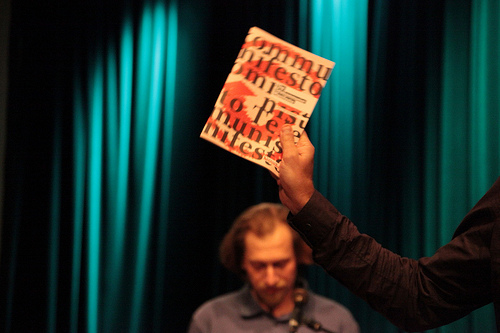
MG: The Manifesto re-opens the debate around the importance of class, and says “The condition of the working class in society is largely one of powerlessness and poverty; the condition of the working class on the Internet is no different.” Could you offer some examples of who this working class is using the Internet?
DK: I have a very classic notion of working class: Anyone whose livelihood depends on their continuing to work. Class is a relationship. Workers are a class who lack the independent means of production required for their own subsistence, and thus require wage, patronage or charity to survive.
MG: For personal and social reasons, I wish for the working class not to be simply presumed as marginalised or economically disadvantaged, but also engaged in situations of empowerment individually and collectively.
DK: Sure, the working class is a broad range of people. What they hold in common is a lack of significant ownership of productive assets. As a class, they are not able to accumulate surplus value. As you can see, there is little novelty in my notion of class.
MG: Engels reminded scholars of Marx after his death that, “All history must be studied afresh”[1]. Which working class individuals or groups do you see out there escaping from such classifications, in contemporary and networked culture?
DK: Individuals can always rise above their class. Many a dotCom founder have cashed-in with a multi-million-dollar “exit,” as have propertyless individuals in other fields. Broad class mobility has only gotten less likely. If you where born poor today you are less likely than ever to avoid dying poor, or avoid leaving your own children in poverty. That is the global condition.
I do not believe that class conditions can be escaped unless class is abolished. Even though it is possible to convince people that class conditions do not apply anymore by means of equivocation, and this is a common tactic of right wing political groups to degrade class consciousness. However, class conditions are a relationship. The power of classes varies over time, under differing historical conditions.
The condition of a class is the balance of its struggle against other classes. This balance is determined by its capacity for struggle. The commons is a component of our capacity, especially when it replaces assets we would otherwise have to pay Capitalist-owners for. If we can shift production from propriety productive assets to commons-based ones, we will also shift the balance of power among the classes, and thus will not escape, but rather change, our class conditions. But this shift is proportional to the economic value of the assets, thus this shift requires expanding the commons to include assets that have economic value, in other words, scarce assets that can capture rent.
MG: The Telekommunist Manifesto, proposes ‘Venture Communism’ as a new working model for peer production, saying that it “provides a structure for independent producers to share a common stock of productive assets, allowing forms of production formerly associated exclusively with the creation of immaterial value, such as free software, to be extended to the material sphere.” Apart from the obvious language of appropriation, from ‘Venture Capitalism’ to ‘Venture Communism’. How did this idea come about?
DK: The appropriation of the term is where it started.
The idea came about from the realization that everything we were doing in the free culture, free software & free networks communities was sustainable only when it served the interests of Capital, and thus didn’t have the emancipatory potential that myself and others saw in it. Capitalist financing meant that only capital could remain free, so free software was growing, but free culture was subject to a war on sharing and reuse, and free networks gave way to centralized platforms, censorship and surveillance. When I realized that this was due to the logic of profit capture, and precondition of Capital, I realized that an alternative was needed, a means of financing compatible with the emancipatory ideals that free communication held to me, a way of building communicative
infrastructure that was born and could remain free. I called this idea Venture Communism and set out to try to understand how it might work.
MG: An effective vehicle for the revolutionary workers’ struggle. There is also the proposition of a ‘Venture Commune’, as a firm. How would this work?
DK: The venture commune would work like a venture capital fund, financing commons-based ventures. The role of the commune is to allocate scarce property just like a network distributes immaterial property. It acquires funds by issuing securitized debt, like bonds, and acquires productive assets, making them available for rent to the enterprises it owns. The workers of the enterprises are themselves owners of the commune, and the collected rent is split evenly among them, this is in addition to whatever remuneration they receive for work with the enterprises.
This is just a sketch, and I don’t claim that the Venture Communist model is finished, or that even the ideas that I have about it now are final, it is an ongoing project and to the degree that it has any future, it will certainly evolve as it encounters reality, not to mention other people’s ideas and innovations.
The central point is that such a model is needed, the implementation details that I propose are… well, proposals.
MG: So, with the combination of free software, free code, Copyleft and Copyfarleft licenses, through peer production, does the collective or co-operative have ownership, like shares in a company?
DK: The model I currently support is that a commune owns many enterprises, each independent, so the commune would own 100% of the shares in each enterprise. The workers of the enterprises would themselves own the commune, so there would be shares in the commune, and each owner would have exactly one.
MG: In the Manifesto, there is a section titled ‘THE CREATIVE ANTI-COMMONS’, where the Creative Commons is discussed as an anti-commons, peddling a “capitalist logic of privatization under a deliberately misleading name.” To many, this is a controversy touching the very nature of many networked behaviours, whether they be liberal or radical minded. I am intrigued by the use of the word ‘privatization’. Many (including myself) assume it to mean a process whereby a non-profit organization is changed into a private venture, usually by governments, adding extra revenue to their own national budget through the dismantling of commonly used public services. Would you say that the Creative Commons, is acting in the same way but as an Internet based, networked corporation?
DK: As significant parts of the Manifesto is a remix of my previous texts, this phrase originally comes from the longer article “COPYRIGHT, COPYLEFT AND THE CREATIVE ANTI-COMMONS,” written by me and Joanne Richardson under the name “Ana Nimus”:
http://subsol.c3.hu/subsol_2/contributors0/nimustext.html
What we mean here is that the creative “commons” is privatized because the copyright is retained by the author, and only (in most cases) offered to the community under non-commercial terms. The original author has special rights while commons users have limited rights, specifically limited in such a way as to eliminate any possibility for them to make a living by employing this work. Thus these are not commons works, but rather private works. Only the original author has the right to employ the work commercially.
All previous conceptions of an intellectual or cultural commons, including anti-copyright and pre-copyright culture as well as the principles of free software movement where predicated on the concept of not allowing special rights for an original author, but rather insisting on the right for all to use and reuse in common. The non-commercial licenses represent a privatization of the idea of the commons and a reintroduction of the concept of a uniquely original artist with special private rights.
Further, as I consider all expressions to be extensions of previous perceptions, the “original” ideas that rights are being claimed on in this way are not original, but rather appropriated by the rights-claimed made by creative-commons licensers. More than just privatizing the concept and composition of the modern cultural commons, by asserting a unique author, the creative commons colonizes our common culture by asserting unique authorship over a growing body of works, actually expanding the scope of private culture rather than commons culture.
MG: So, this now brings us to Thimbl, a free, open source, distributed micro-blogging platform, which as you say is “similar to Twitter or identi.ca. However, Thimbl is a specialized web-based client for a User Information protocol called Finger. The Finger Protocol was orginally developed in the 1970s, and as such, is already supported by all existing server platforms.” Why create Thimbl? What kind of individuals and groups do you expect to use it, and how?
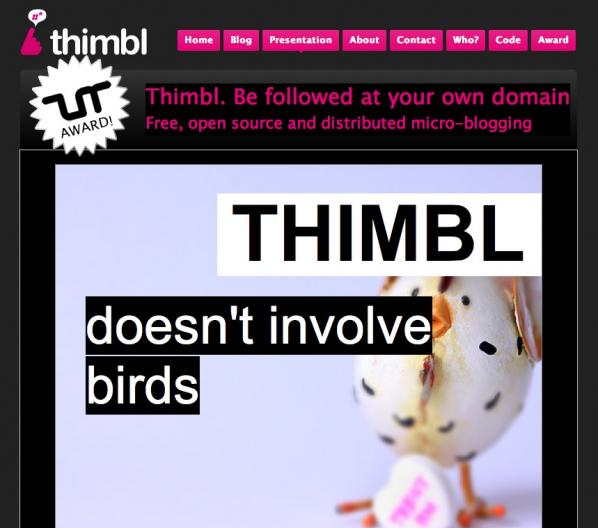
DK: First and foremost Thimbl is an artwork.
A central theme of Telekommunisten is that Capital will not fund free, distributed platforms, and instead funds centralized, privately owned platforms. Thimbl is in part a parody of supposedly innovative new technologies like twitter. By creating a twitter-like platform using Finger, Thimbl demonstrates that “status updates” where part of network culture back to the 1970s, and thus multimillion-dollar capital investment and massive central data centers are not required to enable such forms of communication, but rather are required to centrally control and profit from them.
MG: In a collaborative essay with Brian Wyrick, published on Mute Magazine ‘InfoEnclosure-2.0’, you both say “The mission of Web 2.0 is to destroy the P2P aspect of the Internet. To make you, your computer, and your Internet connection dependent on connecting to a centralised service that controls your ability to communicate. Web 2.0 is the ruin of free, peer-to-peer systems and the return of monolithic ‘online services’.”[2] Is Thimbl an example of the type of platform that will help to free-up things, in respect of domination by Web 2.0 corporations?
DK: Yes, Thimbl is not only a parody, it suggests a viable way forward, extending classic Internet platforms instead of engineering overly complex “full-stack” web applications. However, we also comment on why this road is not more commonly taken, because “The most significant challenge is not technical, it is political.” Our ability to sustain ourselves as developers requires us to serve our employers, who are more often than not funded by Capital and therefore are primarily interested in controlling user data and interaction, since delivering such control is a precondition of receiving capital in the first place.
If Thimbl is to become a viable platform, it will need to be adopted by a large community. Our small collective can only take the project so far. We are happy to advise any who are interested in how to join in. http://thimbl.tk is our own thimbl instance, it “knows” about most users I would imagine, since I personally follow all existing Thimbl users, as far as I know, thus you can see the state of the thimblsphere in the global timeline.
Even if the development of a platform like Thimbl is not terribly significant (with so much to accomplish so quickly), the value of a social platform is the of course derived from the size of it’s user base, thus organizations with more reach than Telekommunisten will need to adopt the platform and contribute to it for it to transcend being an artwork to being a platform.
Of course, as the website says “the idea of Thimbl is more important than Thimbl itself,” we would be equally happy if another free, open platform extending classic Internet protocols where to emerge, people have suggested employing smtp/nntp, xmmp or even http/WebDav instead of finger, and there are certain advantages and disadvantages to each approach. Our interest is the development of a free, open platform, however it works, and Thimbl is an artistic, technical and conceptual contribution to this undertaking.
MG: Another project is the Telekommunisten Facebook page, you have nearly 3000 fans on there. It highlights the complexity and contradictions many independents are faced with. It feels as though the Internet is now controlled by a series of main hubs; similar to a neighbourhood being dominated by massive superstores, whilst smaller independent shops and areas are pushed aside. With this in mind, how do you deal with these contradictions?
DK: I avoided using Facebook and similar for quite some time, sticking to email, usenet, and irc as I have since the 90s. When I co-authored InfoEnclosure 2.0, I was still not a user of these platforms. However it became more and more evident that not only where people adopting these platforms, but that they were developing a preference for receiving information on them, they would rather be contacted there than by way of email, for instance. Posting stuff of Facebook engaged them, while receiving email for many people has become a bother. The reasons for this are themselves interesting, and begin with the fact that millions where being spent by Capitalists to improve the usability of these platforms, while the classic Internet platforms were more or less left as they were in the 90s. Also, many people are using social media that never had been participants in the sorts of mailing lists, usenet groups, etc that I was accustomed to using to share information.
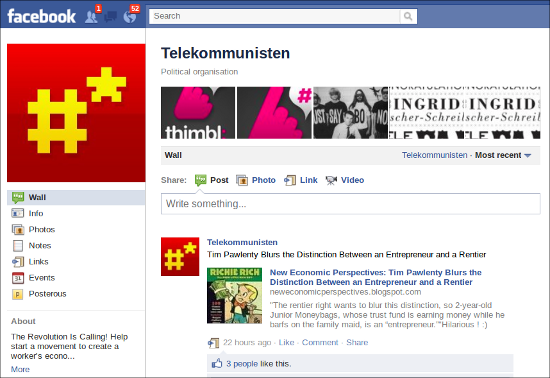
If I wanted to reach people and share information, I needed to do so on the technologies that others are using, which are not necessarily the ones I would prefer they use.
My criticism of Facebook and other sites is not they are not useful, it is rather that they are private, centralized, proprietary platforms. Also, simply abstaining from Facebook in the name of my own media purity is not something that I’m interested in, I don’t see capitalism as a consumer choice, I’m more interested in the condition of the masses, than my own consumer correctness. In the end it’s clear that criticizing platforms like Facebook today means using those platforms. Thus, I became a user and set up the Telekommunisten page. Unsurprisingly, it’s been quite successful for us, and reaches a lot more people than our other channels, such as our websites, mailing lists, etc. Hopefully it will also help us promote new decentralized channels as well, as they become viable.
MG: So, I downloaded deadSwap (http://deadSwap.net) which I intend to explore and use. On the site it says “The Internet is dead. In order to evade the flying monkeys of capitalist control, peer communication can only abandon the Internet for the dark alleys of covert operations. Peer-to-peer is now driven offline and can only survive in clandestine cells.” Could you explain the project? And are people using it as we speak?
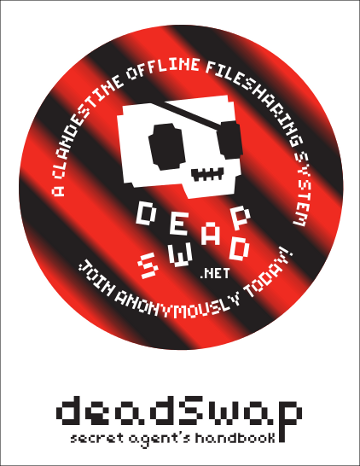
DK: I have no idea if people are using it, I am currently not running a network.
Like thimbl, deadSwap is an artwork. Unlike thimbl, which has the seeds of a viable platform within it, deadSwap is pure parody.
It was developed for the 2009 Sousveillance Conference, The Art of Inverse Surveillance, at Aarhus University. deadSwap is a distopian urban game where participants play secret agents sharing information on usb memory sticks by hiding them in secret locations or otherwise covertly exchanging them, communicating through an anonymizing SMS gateway. It is a parody of the “hacker elite” reaction to Internet enclosure, the promotion of the idea that new covert technologies will defeat attempts to censor the Internet, and we can simply outsmart and outmaneuver those who own and control our communications systems with clandestine technologies. This approach often rejects any class analysis out-of-hand, firmly believing in the power of us hackers to overcome state and corporate repressions. Though very simple in principal, deadSwap is actually very hard to use, as the handbook says “The success of the network depends on the competence and diligence of the participants” and “Becoming a super-spy isn’t easy.”
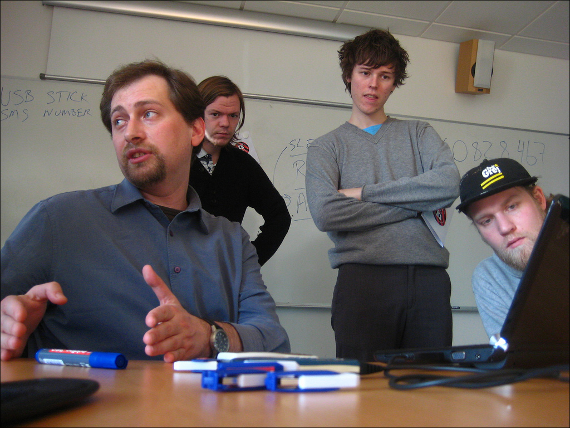
MG: What other services/platforms/projects does the Telekommunisten collective offer the explorative and imaginative, social hacker to join and collaborate with?
DK: We provide hosting services which are used by individuals and small organizations, especially by artists, http://trick.ca, electronic newsletter hosting (http://www.freshsent.info) and a long distance calling service (http://www.dialstation.com). We can often be found on IRC in#telnik in freenode. Thimbl will probably be a major focus for us, and anybody that wants to join the project is more than welcome, we have a community board to co-ordinate this which can be found here: http://www.thimbl.net/community.html
For those that want to follow my personal updates but don’t want don’t use any social media, most of my updates also go here: http://dmytri.info
Thank you for a fascintaing conversation Dmytri,
Thank you Marc 🙂
=============================<snip>
Top Quote: THE::CYBER.COM/MUNIST::MANIFESTO by Richard Barbrook. http://www.imaginaryfutures.net/2007/04/18/by-richard-barbrook/
The Foundation for P2P Alternatives proposes to be a meeting place for those who can broadly agree with the following propositions, which are also argued in the essay or book in progress, P2P and Human Evolution. http://blog.p2pfoundation.net
In the essay ‘Imagine there is no copyright and no cultural conglomerates too…” by Joost Smiers and Marieke van Schijndel, they say “Once a work has appeared or been played, then we should have the right to change it, in other words to respond, to remix, and not only so many years after the event that the copyright has expired. The democratic debate, including on the cutting edge of artistic forms of expression, should take place here and now and not once it has lost it relevance.”
Issue no. 4 Joost Smiers & Marieke van Schijndel, Imagine there are is no copyright and no cultural conglomorates too… Better for artists, diversity and the economy / an essay. colophon: Authors: Joost Smiers and Marieke van Schijndel, Translation from Dutch: Rosalind Buck, Design: Katja van Stiphout. Printer: ‘Print on Demand’. Publisher: Institute of Network Cultures, Amsterdam 2009. ISBN: 978-90-78146-09-4.
http://networkcultures.org/wpmu/theoryondemand/titles/no04-imagine-there-are-is-no-copyright-and-no-cultural-conglomorates-too/
A Computer in the Art Room: The Origins of British Computer Arts 1950-1980
Catherine Mason
ISBN: 1899163891
JJG Publishing 2008
Computing anywhere else but its history often seems like a carefully guarded secret. This has been alleviated by activity around the resurrected Computer Arts Society in the 2000s, notably the acquisition of CAS’s archives by the V&A and the CaCHE project at Birbeck College which ran from 2002-2005. CaCHE, run by Paul Brown, Charlie Gere, Nick Lambert and Catherine Mason, produced conferences, exhibitions, and publications including the book “A Computer In the Art Room”, by Mason.
The art room of the title is the art department of British educational institutions prior to art becoming a degree-level subject. From the 1950s to the 1970s, when the cost of computing machinery dropped from the level where only major government and corporate organizations could afford them to the level where you only needed a second mortgage to afford one, the best way for artists to get access to the enabling technology of computing machinery was usually in an educational institution.
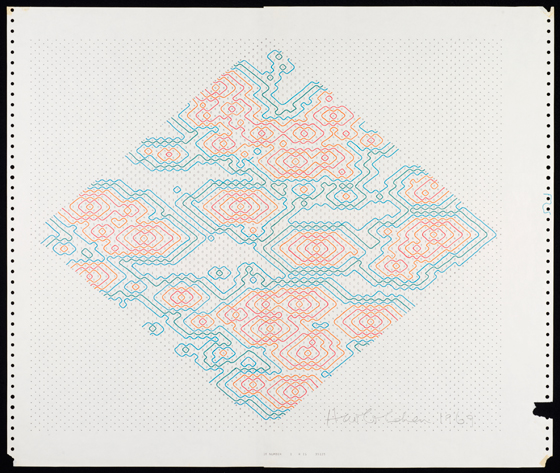
Mason starts out by describing the artistic and art educational situation in the UK at the time of the Festival Of Britain and the foundation of the ICA in London in the early 1950s. She then explains the structure and significance of the emergence of Basic Design teaching, the impact of the Coldstream report on art education, and the rise of the polytechnic colleges over the next thirty years. This provides vital context for the emergence of art computing teaching in the UK. It is also of more general interest for British art history. Conceptualism, performance, Land Art, the Hornsey Art School occupation, and the educational and media graphics that are currently being used as the basis of “hauntological” art all share this background and can better be understood and critiqued with better knowledge of it.
Basic Design courses started in London but didn’t remain there for long. They spread and matured throughout the UK, becoming entangled with the earliest teaching of art computing in provincial technical colleges. Mason traces the family trees of art computing teaching over time through these institutions and back to London-based institutions. Some of the names are familiar from art history (Richard Hamilton, Stephen Willats), some from art computing history (Harold Cohen, John Latham). Where the people involved cross over with cybernetic art, Conceptualism or other artistic currents Mason shows how their ideas fed into and from their art computing work.
The conceptual content of art computing followed the Bauhaus, cybernetics, systems, sociological and environmental influences on art from the 1950s to the 1970s. Its technological forms likewise followed those of mainstream computing. In the 1960s time was leased on mainframes or computers were built by hand. In the 1970s, minicomputers became available and art domain-specific software frameworks or programming languages were written by their users. In the 1980s, workstations with touch tablets, framebuffers, and increasingly proprietary software brought previously unprecedented power and ease of use at the cost of more fixed forms.
The history that I had to piece together as a student from hearsay and from hints in old publications, of the PICASO graphics language at Middlesex University that I found a print-out of the manual for when I was there in the 1990s, of Art & Language’s use of mainframe computers, of early cross-overs between art computing and dance, of cybernetic systems and games that attracted mass audiences before disappearing, is detailed, illustrated and contextualized in page after page of descriptions of hardware, software, institutions, courses and projects. The detail would be overwhelming where it not for Mason’s ability to bring the human and broader cultural aspect of it all to life.
There’s Jasia Reichardt’s Cybernetic Serendipity show at the ICA, Andy Inakhowitz’s Senster robot, John Latham’s dance notation experiments, The Environment Game, and computer graphics drawn with the languages and environments developed in UK art institutions. There’s pictures of the computer systems at the Slade, the RCA, Wimbledon and other art schools that serve as insights into the artists’ studios. There’s the Computer Arts Society, IRAT, APG. And, crucially, there’s the links between them told in a narrative that is coherent while still presenting the breaks and false starts in the story.
The history of “A Computer In The Art Room” reads all too often as brief moments of individuals triumphing against the odds to produce key works of art computing then fading into obscurity, academia or commerce. But any art history that considers a specific context at such a level of detail will look like this. Mason describes works, institutions and artists that deserve broader recognition, although she is under no illusion about how far the road to that recognition may be, citing the example of how long it has taken for photography to be recognized as art in the culturally conservative UK.
The social and pedagogical changes of the period covered by “A Computer In The Art Room” reflect a time of hope and ambition for education in society that made the academy less remote. Mason provides the social, technological and educational context needed to appreciate the very real achievements of art computing that she describes against this backdrop. As a slice of art history this is richly detailed. It touches on subjects far beyond art computing that will help any art student of history better understand the period covered. And it is both a relief and an inspiration to finally have a public record of this important aspect of the history of art computing in the UK.
The text of this review is licenced under the Creative Commons BY-SA 3.0 Licence.
Between July 27th and August 29th, 2010, the eleventh edition of the FILE festival is taking place in Sao Paulo (Brazil), at several locations along the popular Paulista Avenue. After a decade of existence, this veteran festival, which spreads over several cities in Brazil (including Rio de Janeiro and Porto Alegre) as well as other international locations, has introduced for the first time its own award: the FILE PRIX LUX. With a total amount of approximately 120,000 euros, distributed in three categories, the prize is unprecedented in the continent and has received, on this first edition, 1,235 registrations from 44 countries.
Yet this award is not the only remarkable aspect of this year’s festival, which stands out for being particularly accessible to the general public. On the one hand, the exhibitions, performances and workshops as well as the symposium have no entrance fees, and therefore there have been many visitors, most of all young people who line up every day to experience the interactive installations at the FIESP-Ruth Cardoso Cultural Centre. On the other hand, the festival organizers, Ricardo Barreto and Paula Perissinotto, have developed this year a project that takes digital art to the Paulista Avenue by placing several interactive artworks at different locations in the public space. Finally, even the FILE PRIX LUX has been open to the interaction with the public by introducing a popular vote category and an online voting system which was accessible between May and June. This openness sets a good example of how media art festivals can engage the general public to approach this somewhat ignored form of art.
In general terms, the award categories at media art festivals have been subject to change as the creative uses of technology evolved during the last decades. The FILE PRIX LUX has the advantage of being created at a time in which it can be relatively safe to set up a few broad categories that cover most of the forms of combining art and technology. Only three categories have been established: Interactive Art (which usually refers to objects and installations that respond to inputs from the viewer/s), Digital Language (related to the festival’s title and which embraces any artwork that deals with language, narrative, code or text in a generative or interactive manner) and Electronic Sonority (the category assigned to any artwork in which the production or manipulation of sound is a key element). These three categories prove to be comprehensive, as shown by the diversity of the projects distinguished with a prize or an honorary mention: immersive interactive installations, musical performances, urban interventions, bioart pieces, a collectively created machinima movie and even an iPhone app are among this year’s FILE PRIX LUX awardees.
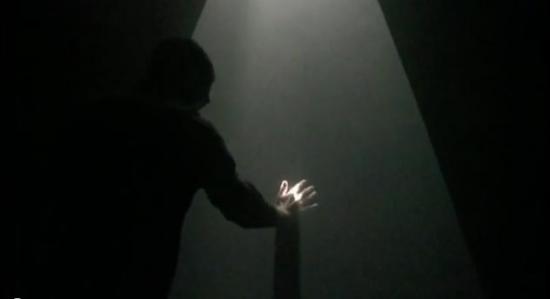
In the Interactive Art category, the winners are Ernesto Klar for Relational Lights (1st prize) and Kurt Henschläger for Zee (2nd prize). Both present immersive environments in which light and space are key elements, although the interaction is totally different. Klar’s work invites the viewer to interact with two projected geometric drawings inspired by the work of Lygia Clark. In a hazy dark room, the viewer sees two T-shaped projections of white light on the ground, which form a three-dimensional space which reacts to the visitor’s presence. The interaction is playful and really beautiful in its simplicity, whilst also limited in time: after a few minutes, the projections suddenly stop reacting to the user’s movements and reconfigure themselves in a new shape. This abrupt interruption is consciously introduced by the artist in order to remind the viewer that the artwork has a life of its own. In contrast, Henschläger’s Zee takes place mostly in the mind of an audience exposed to an overdose of audiovisual stimuli in a foggy room. Continuing the experience of his acclaimed performance FEED, this time the artist allows the viewer to walk around the space and have a more meditative sensory experience.
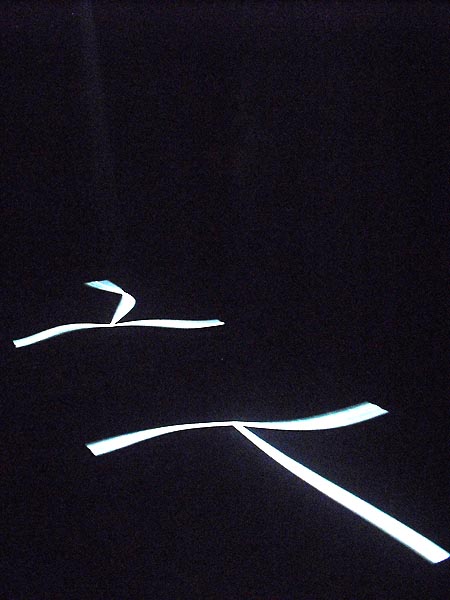
The Electronic Sonority category has brought together several outstanding works, among which Jaime E. Oliver’s Silent Percussion Project and TERMINALBEACH’s Heartchamber Orchestra have been distinguished with the 1st and 2nd prize, respectively. In both projects the human body is incorporated in a novel form in the creation of music, the sound being produced, moreover, not simply by direct inputs but by complex interactions in a constant flow of data. Oliver’s instruments convert the shapes created by the performer’s hands into streams of data that generate, in turn, different sounds. These sounds are not always the same, as could be the case in a traditional instrument, but are changed by the variables established in previous interactions. Thus, Oliver does not simply create a new form of interacting with an instrument but rather a new form of creating music. In a similar way, the [i]Heartchamber Orchestra[/i] project developed by TERMINALBEACH (Erich Berger and Peter Votava) explores a form of creating music based on a feedback loop in which the performers are writing and following the score at the same time. As the artists state, in their project “the music literally comes from the heart”: a network of 12 independent sensors record the heartbeats of the musicians in an orchestra and sends the data to a software that generates a musical score in real time. The musicians play the score as it is displayed on the laptops in front of them, while their heartbeats set the notes in a continuous cycle in which music and performer constantly influence each other.
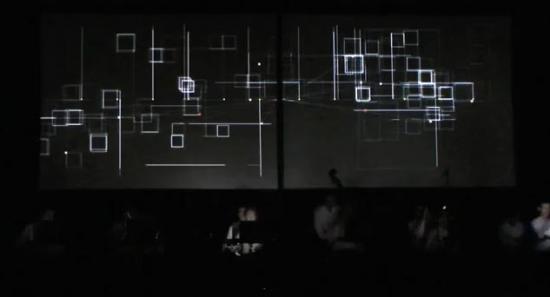
Digital Language is certainly the broadest category of this FILE PRIX LUX, its awardees being quite dissimilar in the formats they use and the objectives of their respective projects. The organizers define this category as including “all research and experiments in the ambit of the multiple disciplines that use digital media”, and the winners exemplify how diverse these disciplines can be. The 1st prize winner, Tardigotchi by the artists collective SWAMP (Douglas Easterly, Matt Kenyon and Tiago Rorke) is a bioart project that sets a critical comparison between artificial and real life. A nicely designed, steam punk-inspired device hosts, on the one hand, a tardigrade, a microorganism measuring half a millimeter in length, along with a robot arm that injects a substance that feeds the creature and a heating lamp that provides warmth. On the other hand, a digital display shows the virtual avatar of this tardigrade, with which the user can interact. Humorously referencing the popular Tamagotchi toy, the artists create a link between the avatar and the real creature: when the user presses the button to feed the avatar, the device inserts real food in the environment of the tardigrade; when an email is sent to the digital creature, a heating lamp gives warmth to the microorganism. Thus, interacting with the virtual pet has consequences in a real living being. This brings our attention into what we can consider alive and how we emotionally attach to artificial creatures while at the same time we undervalue the existence of other living beings. On a different approach, the 2nd prize winner, Hi! A Real Human Interface, by the collective Multitouch Barcelona (Dani Armengol, Roger Pujol, Xavier Vilar and Pol Pla), proposes a more human relationship with technology. A video presents the concept developed by this interaction design group of a different GUI in which a real person is displayed as impersonating the computer. Common interface elements are replaced by handmade physical objects which remind the aesthetics of a video by Michel Gondry. The result is a playful form of interaction in which simple operations such as checking email or upgrading the operating system are shown as actions carried on with real objects by a person inside a box. The proposal is engaging and certainly sets a departure from the old desktop concept, yet it remains unsure to what extend this type of interaction can be applied in a real operating system.
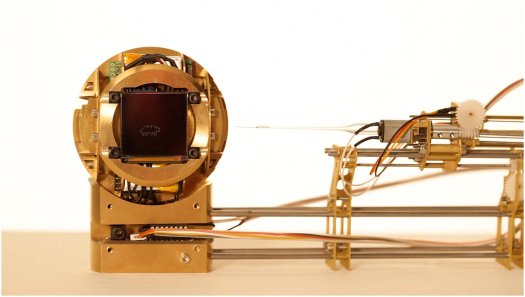
The works that obtained a Vesper statuette (symbol of the FILE PRIX LUX award) along with the also outstanding Honorary Mentions are exhibited at the FIESP-Ruth Cardoso Cultural Centre in a group show that also includes FILE Media Art, a selection of more than 70 works that can be accessed on several computers, as well as a selection of videogames and machinima films. The exhibition is thus richer in content than it would seem at first sight, as the space is divided in numerous sections that conceal several installations which demand (as usual) almost total obscurity. The artworks are well presented, although at times the sound from one installation invades the others, and there are no wall labels that inform the viewer about the concept of the piece or the way to interact with it. The latter, much-discussed issue is quite important, since the info-trainers cannot explain the artworks to every visitor, and quite often this entails that some people may not interact with the pieces or worse, start smashing buttons or interfering projections blindly in the hope of modifying them. Despite this fact, the exhibition has proven to be very successful during the first week of the festival, with a steady flow of visitors who showed a profound interest in the artworks.

A part of the exhibition is devoted to the FILE MACHINIMA section, curated by Fernanda Alburquerque, who selected over 40 works. Among these is the award winner in the Popular Vote category, War of Internet Addiction, by Corndog and the Oil Tiger Machinima Team from China, a 64-minute movie collectively created by players in the MMORPG War of Warcraft. More than mere entertainment, this film has been created as a form of protest against the Chinese authorities’ attempt to control the access and commercial benefits derived from the WoW game, which is extremely popular in the country. The film has had 10 million views since January 2010 and despite being available only in Chinese, it has been the favorite work of those who participated in the online voting system of the FILE PRIX LUX. Besides this feature film, other short films explore the possibilities of building narratives in virtual environments such as Second Life and videogames such as Half Life 2, Eve Online or Shadow of the Colossus.
In addition to the main exhibition, the FIESP Cultural Centre hosts a series of performances and screenings. Under the title Hypersonica, the festival presented a series of digital music performances, among which where the two winners of the FILE PRIX LUX in the Electronic Sonority category. FILE DOCUMENTA, curated by Eric Marke, offers in its 5th edition a selection of “rare and new” documentary films, among which Andreas Johnsen’s Good Copy Bad Copy, an interesting exploration of the conflicts between remix artists and copyright owners, or Robert Baca’s Welcome to Macintosh, which records the first years of the history of Apple Computers.
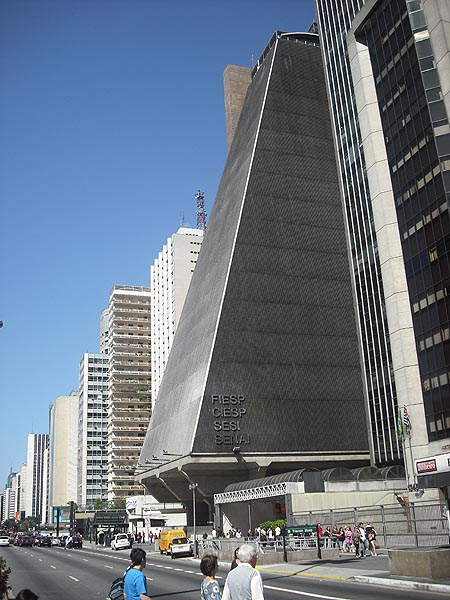
The symposium, hosted by the Instituto Cervantes in Sao Paulo, gathered several experts and artists who presented their explorations in the theory and practice of media art. Among the most interesting contributions were the presentation of Prof. Espen Aarseth on the aesthetics of ludo-narrative software, and the colloquy of South American digital art, in which Raquel Renno (Brazil), Jorge Hernandez, Ricardo Vega (Chile) and Vicky Messi (Argentina) discussed the current developments in the media art scene in the South Cone.
Alongside the FILE PRIX LUX, the most outstanding feature of the present edition of the festival is FILE PAI (Paulista Avenida Interactiva), which takes several interactive artworks to the public spaces in the Paulista Avenue. Interactive art offers the possibility of bringing art to the public space in a more efficient and dynamic form than what is usually known as “public art”. As Ricardo Barreto states: “the public environment is not something empty, aseptic and dead, as is the old white cube; on the contrary, it is an environment teeming with life, with multiple interests and multiple behaviors”. Interactive art integrates itself into this environment and is much more apt to relate to a public that is now willing to take an active role. The organizers of the FILE festival have distributed twelve interactive artworks along the Paulista Avenue, at subway stations, inside shopping malls, and even in a bus. The selected artworks include, among others, videogames such as Patrick Smith’s Windosill or the celebrated games of That Game Company, Flower and Flow; VR/Urban’s SMSlingshot, an urban intervention project that allows users to write a message in a custom-made slingshot that incorporates a screen and a keyboard and then send the message to a wall, where it is displayed as a virtual graffiti; Karolina Sobecka’s Sniff, an interactive projection in which a virtual dog reacts to the presence of passersby; the installations of Rejane Cantoni and Leonardo Crescenti Piso and Infinito ao Cubo, which attracted a large number of people, and the sound piece Omnibusonia Paulista by Vanderlei Lucentini, which is played in a bus as it moves along the avenue, interacting with several points in the itinerary and thus generating a new set of sounds in every trip. These works reveal the possibilities of integrating interactive art in the public space, to the point that, as Ricardo Barreto indicates, “the new paradigm of public art will be the interactive city”. The busy Paulista Avenue is certainly a good location for the creation of an emerging, interactive city.
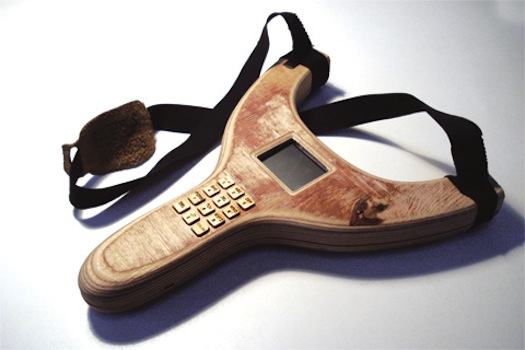
In this 11th edition, the FILE festival has achieved a state of maturity. The FILE PRIX LUX, FILE PAI and an estimated 25,000 visitors to date support its claim of being the largest festival of its kind in Latin America, and a steady event that places Brazil in the map of the international digital art scene. In a tightly interconnected world, each region is a node: there isn’t a center and a periphery anymore, there are no colonies. FILE exemplifies how a region can become a powerful node in this network by promoting the most recent developments in art and technology, avoiding obsolete distinctions between North and South and becoming a point of development for the future stages of our digital culture.
Co-published by Furtherfield and The Hyperliterature Exchange.
Last October I received an e-mail headed “Introducing Vook”:
The Vook Team is pleased to announce the launch of our first vooks, all published in partnership with Atria, an imprint of Simon & Schuster, Inc. These four titles… elegantly realize Vook’s mission: to blend a book with videos into one complete, instructive and entertaining story.
The e-mail also included a link to an article about Vooks in the New York Times:
Some publishers say this kind of multimedia hybrid is necessary to lure modern readers who crave something different. But reading experts question whether fiddling with the parameters of books ultimately degrades the act of reading…
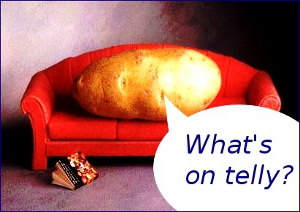
Note the rather loaded use of the words “lure”, “crave”, “fiddling” and “degrades”. The phraseology seems to suggest that modern readers are decadent and listless thrill-seekers who can scarcely summon the energy to glance at a line of text, let alone plough their way through an entire book. If an artistic medium doesn’t offer them some form of instant gratification – glamour, violence, excitement, pounding beats, lurid colours, instant melodrama – then it simply won’t get their attention. But publishers have a moral duty not to pander to their readers’ base appetites: the New York Times article ends by quoting a sceptical “traditional” author called Walter Mosley –
“Reading is one of the few experiences we have outside of relationships in which our cognitive abilities grow,” Mr. Mosley said. “And our cognitive abilities actually go backwards when we’re watching television or doing stuff on computers.”
In other words, reading from the printed page is better for your mental health than watching moving pictures on a screen: an argument which has been resurfacing in one form or another at least since television-watching started to dominate everyday life in the USA and Europe back in the 1950s. To some extent this is the self-defence of a book-loving and academically-inclined intelligensia against the indifference or hostility of popular culture – but in the context of a discussion of Vooks, it can also be interpreted as a cry of irritation from a publishing industry which is increasingly finding the ground being scooped from under its feet by younger, sexier, more attention-grabbing forms of entertainment.
The fact that the Vook publicity-email links to an article which is generally rather sniffy and unfavourable about the idea of combining video with print no doubt reflects a belief that all publicity is good publicity – but it is also indicative of the publishing industry’s mixed attitudes towards the digital revolution. On the whole, up until recently, they have tended to simply wish it would just go away; but they have also wished, sporadically, that they could grab themselves a piece of the action. But those publishers who have attempted to ride the digital surf rather than defy the tide have generally put their efforts and resources into re-packaging literature instead of re-thinking it: and the evidence of this is that the recent history of the publishing industry is littered with ebooks and e-readers, whereas attempts to exploit the digital environment by combining text with other media in new ways have generally been ignored by the publishing mainstream, and have therefore remained confined to the academic and experimental fringes.
The publishing industry’s determination to make the digital revolution go away by ignoring it has been even more evident in the UK than in the US. The 1997 edition of The Writers’ and Artists’ Yearbook, for example, contains no references to ebooks or digital publishing whatsoever, although it does contain items about word-processing and dot-matrix printers. On the other hand, Wired magazine was already publishing an in-depth article about ebooks in 1998 (“Ex Libris” by Steve Silberman, http://www.wired.com/wired/archive/6.07/es_ebooks.html) which describes the genesis of the SoftBook, the RocketBook and the EveryBook, as well as alluding to their predecessor, the Sony BookMan (launched in 1991). Even in the USA, however, enthusiasm for ebooks took a tremendous knock from the dot-com crash of 2000. Stephen Cole, writing about ebooks in the 2010 edition of The Writers’ and Artists’ Yearbook, summarises their history as follows:
Ebook devices first appeared as reading gadgets in science fiction novels and television series… But it was not until the late 1990s that dedicated ebook devices were marketed commercially in the USA… A stock market correction in 2000, combined with the generally poor adoption of downloadable books, sapped all available investment capital away from internet technology companies, leaving a wasteland of broken dreams in its wake. Over the next two years, over a billion dollars was written off the value of ebook companies, large and small.
After 2000, there was a widely-held view (which I shared) that the ebook experiment had been tried and failed: paper books were a superb piece of technology, and perhaps a digital replacement for them was simply never going to happen. There were numerous problems with ebooks: too many different and incompatible formats, too difficult to bookmark, screens hard to read in direct sunlight, couldn’t be taken into the bath, etc. But ebooks have always had a couple of big points in their favour – you can store hundreds on a computer, whereas the same books in paper form demand both physical space and shelving, you can find them quickly once you’ve got them, and they’re cheap to produce and deliver. Despite the dot-com crash and general indifference of the reading public, publishers continued to bring out electronic editions of books, and a small but growing number of people continued to download them.
Things really started to change with the launch of Amazon’s Kindle First Generation in 2007. It sold out in five and a half hours. With the Kindle, the e-reader went wireless. Instead of having to buy books on CDs or cartridges and slot them into hand-helds, or download them onto computers and then transfer them, readers using the Kindle could go right online using a dedicated network called the Whispernet, and get themselves content from the Kindle store.
Despite this big step forward, the Kindle was still an old-school e-reader in some respects: it had a black and white display, and very limited multimedia capabilities. The Apple iPad changed the rules again when it was launched in April 2010. The iPad isn’t just an e-reader – it’s “a tablet computer… particularly marketed for consumption of media such as books and periodicals, movies, music, and games, and for general web and e-mail access” (Wikipedia, http://en.wikipedia.org/wiki/I-pad). Its display screen is in colour, and it can play MP3s and videos or browse the Web as well as displaying text. For another thing, it goes a long way towards scrapping the rule that each e-reader can only display books in its own proprietary format. The iPad has its own bookstore – iBooks – but it also runs a Kindle app, meaning that iPad owners can buy and display Kindle content if they wish.
It seems we may finally be reaching the point where ebooks are going to pose a genuine challenge to print-and-paper. Amazon have just announced that Stieg Larsson’s The Girl with the Dragon Tattoo has become the first ebook to sell more than a million copies; and also that they are now selling more copies of ebooks than books in hardcover.
It is certainly also significant that the past couple of years have seen a sudden upsurge of interest in the question of who owns the rights over digitised book content, and whether ordinary copyright laws apply to online text – a debate which has been brought to the boil by a court case brought against Google in 2005 by the Authors Guild of America.

In 2002, under the title of “The Google Books Library Project”, Google began to digitise the collections of a number of university libraries in the USA (with the libraries’ agreement). Google describes this project as being “like a card catalogue” – in other words, primarily displaying bibliographic information about books rather than their actual contents. “The Library Project’s aim is simple”, says Google: “make it easier for people to find relevant books – specifically, books they wouldn’t find any other way such as those that are out of print – while carefully respecting authors’ and publishers’ copyrights.” They do concede, however, that the project includes more than bibliographic information in some instances: “If the book is out of copyright, you’ll be able to view and download the entire book.” (http://books.google.com/googlebooks/library.html)
In 2004 Google launched Book Search, which is described as “a book marketing program”, but structured in a very similar way to the Library Project: displaying “basic bibliographic information about the book plus a few snippets”; or a “limited preview” if the copyright holder has given permission, or full texts for books which are out of copyright – in all cases with links to places online where the books can be bought. Interestingly, my own book Outcasts from Eden is viewable online in its entirety, although it is neither out of copyright nor out of print, which casts a certain amount of doubt on Google’s claim to be “carefully respecting authors’ and publishers’ copyrights”.
In 2005 the Authors Guild of America, closely followed by the Association of American Publishers, took Google to court on the basis that books in copyright were being digitised – and short extracts shown – without the agreement of the rightsholders. Google suspended its digitisation programme but responded that displaying “snippets” of copyright text was “fair use” under American copyright law. In October 2008 Google agreed to pay $125 million to settle the lawsuit – $45.5 million in legal fees, $45 million to “rightsholders” whose rights had already been infringed, and “$34.5 million to create a Book Rights Registry, a form of copyright collective to collect revenues from Google and dispense them to the rightsholders. In exchange, the agreement released Google and its library partners from liability for its book digitization.” (http://en.wikipedia.org/wiki/Google_Book_Search_Settlement_Agreement). The settlement was queried by the Department of Justice, and a revised version was published in November 2009, which is still awaiting approval at the time of writing.
The settlement is a complex one, but its most important provision as regards the future of publishing seems to be that “Google is authorised to sell online access to books (but only to users in the USA). For example, it can sell subscriptions to its database of digitised books to institutions and can sell online access to individual books.” 63% of the revenue thus generated must be passed on to “rightsholders” via the new Registry. “The settlement does not allow Google or its licensees to print copies of books in copyright.” (“The Google Settlement” by Mark Le Fanu, The Writers’ and Artists’ Yearbook 2010, pp. 631-635).
Google, it will be noted, are now legally within their rights to continue their digitisation programme. This means they don’t have to ask anyone’s permission before they digitise work. If authors or publishers would prefer not to be listed by Google it is up to them to lodge an objection online. Google would argue that in launching their Library Project and Books Search they have merely been seeking to make their search facilities more complete, and thus to “make it easier for people to find relevant books” – but whether or not they have been deliberately plotting their course with wider strategic issues in mind, the end result has been to make them the biggest single player – almost the monopoly-holder – where digital book rights are concerned. As a reflection of this, an organisation called the Open Book Alliance has been set up to oppose the settlement, supported by the likes of Amazon and Yahoo: “In short,” their website claims, “Google’s book digitization strategy in the U.S. has focused on creating an impenetrable content monopoly that violates copyright laws and builds an unfair and legally insurmountable lead over competitors.” (http://www.openbookalliance.org/)
Whatever the pros and cons of the Google Settlement, it has undoubtedly helped to focus the minds of writers and publishers alike on the question of digital rights. Copyright laws and publishers’ contracts were designed to deal with print and paper, and until very recently there has been almost no reference at all to electronic publication. Writers who have agreed terms with a publisher for reproduction of their work in print have theoretically been at liberty to re-publish the same work on their own websites, or perhaps even to collect another fee for it from a digital publisher; and conversely, publishers who have signed a contract to bring out an author’s work in print have sometimes felt free to reproduce it electronically as well, without asking the writer’s permission or paying any extra money.
But things are beginning to change. A June 2010 article in The Bookseller notes that Andrew Wylie, one of the most prestigious of UK literary agents, “is threatening to bypass publishers and license his authors’ ebook rights directly to Google, Amazon or Apple because he is unhappy with publishers’ terms.” This is partly because he believes electronic rights are being sold too cheaply to the likes of Apple: “The music industry did itself in by taking its profitability and allocating it to device holders… Why should someone who makes a machine – the iPod, which is the contemporary equivalent of a jukebox – take all the profit?” Clearly, electronic rights are going to be taken much more seriously from now on.
Further indications that authors, publishers and agents are beginning to wake up and smell the digital coffee can be found in the latest editions of The Writers’ and Artists’ Yearbook and The Writers’ Handbook. For those who are unfamiliar with them, these annual publications are the UK’s two main guides to the writing industry. The 2010 edition of The Writer’s Handbook opens with a keynote article from the editor, Barry Turner, entitled “And Then There was Google”. As the title indicates, its main subject is the Google settlement and its implications – but its broader theme is that the book trade has been ignoring the digital revolution for too long, and can afford to do so no longer:
In the States… sales of e-books are increasing by 50 per cent per year while conventional book sales are static. An indication of what is in store was provided at last year’s Frankfurt Book Fair where a survey of book-buying professionals found that 40 per cent believe that digital sales, regardless of format, will surpass ink on paper within a decade.

The Writers’ and Artists’ Yearbook is more conservative in tone, but if anything its coverage is more in-depth. It has an entire section titled “Writers and Artists Online”, which leads with an article about the Google settlement. In addition there are articles on “Marketing Yourself Online”, “E-publishing” and “Ebooks”. Even in the more general sections of the Yearbook there is a widespread awareness of how digital developments are affecting the book trade. For example, there is a review (by Tom Tivnan) of the previous twelve months in the publishing industry, which acknowledges the importance not just of ebooks but print-on-demand:
Amazon’s increasing power underscores how crucial the digital arena is for publishing… Ebooks remain a miniscule part of the market,… yet publishers and booksellers say they are pleasantly surprised at the amount of sales… And it is not all ebooks. The rise of print-on-demand (POD) technology (basically keeping digital files of books to be printed only when a customer orders it) means that the so-called “long tail” has lengthened, with books rarely going out of print… POD may soon be coming to your local bookshop. In April 2009, academic chain Blackwell had the UK launch of the snazzy in-store Espresso POD machine, which can print a book in about four minutes…
There is also an article about “Books Published from Blogs” (by Scott Pack):
Agents are proving quite proactive when it comes to bloggers. Some of the more savvy ones are identifying blogs with a buzz behind them and approaching the authors with the lure of a possible book deal… Many bestsellers in the years to come will have started out online.
Most of the emphasis in these articles falls on the impact which digital developments are having on the marketing of books rather than the practice of writing itself. But now and again there are signs of a creeping awareness that digitisation may actually change the ways in which our literature is created and consumed. In The Writer’s Handbook, Barry Turner attempts to predict how the digital environment may affect the practice of writing in the coming years:
Those of us who make any sort of livng from writing will have to get used to a whole new way of reaching out to readers. Start with the novel. Most fiction comes in king-sized packages… Publishers demand a product that looks value for money… But all will be different when we get into e-books. There will be no obvious advantage in stretching out a novel because size will not be immediately apparent… Expect the short story to make a comeback… The two categories of books in the forefront of change are reference and travel. Their survival… is tied to a combination of online and print. Any reference or travel book without a website is in trouble, maybe not now, but soon.
Scott Pack’s article on “Books Published from Blogs” tends to focus on those aspects of a blog which may need remoulding to suit publication in book form; but an article by Isabella Pereira entitled “Writing a blog” is more enthusiastic about the blog as a form in its own right:
The glory of blogging lies not just in its immediacy but in its lack of rules… The best bloggers can open a window into private worlds and passions, or provide a blast of fresh air in an era when corporate giants control most of our media… Use lots of links – links uniquely enrich writing for the web and readers expect them… What about pictures? You can get away without them but it would be a shame not to use photos to make the most of the web’s all-singing, all-dancing capacities.
Even here, however, the advice stops short of videos, sound-effects or animations. Another article in The Writers’ and Artists’ Handbook (“Setting up a Website”, by Jane Dorner) specifically forbids the use of animations:
Bullet points or graphic elements help pick out key words but animations should be avoided. Studies show that the message is lost when television images fail to reinforce spoken words. The same is true of the web.
It’s a little difficult to fathom exactly what point Dorner is trying to make here, but it seems to be something along the lines that using more than one medium may have a distracting rather than enhancing effect. If the spoken words on your television are telling you one thing, but the pictures are telling you another, then “the message is lost”. Perhaps a more interesting point, however, is where Dorner draws her dividing-line between acceptable and unacceptable practice. “Bullet points or graphic elements” are all right, because they “help pick out key words”, but “animations should be avoided”. In other words visual aids are all very well as long as they remain to subservient to text. They minute they threaten to replace it as the focus of attention, they become undesireable.
Clearly this point of view continues to enjoy a lot of support, particularly from traditionalists in the writing and publishing industries. All the same, combinations of text with other media may be about to enjoy some kind of vogue; and the development of the Vook brand since its launch last October is an instructive case-history in this regard.
When Vooks were first launched it seems fair to say that they were broadly greeted with a mixture of indifference and scorn. Reviews which appeared in the first couple of months after the launch were usually either lukewarm of downright unfavourable. Here, for example, is one from Janet Cloninger, writing in The Gadgeteer, November 2009:
So how were the video clips? Have you ever seen any of those old 60s TV shows where they were trying to show a bad acid trip? You know the crazy camera work, the weird color changes, the really bad acting?… I don’t think they added anything to the story at all… I found they were very distracting while trying to read.
Here is another from the Institute for the Future of the Book:
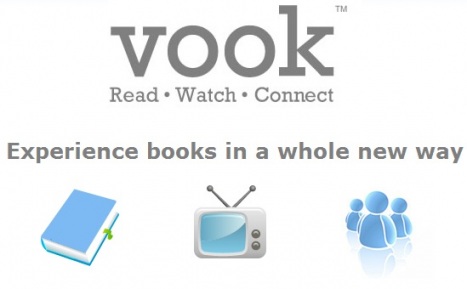
In terms of form the result is ho-hum in the extreme, particularly as there doesn’t seem to be much attempt to integrate the text and the banal video, which seems to exist simply to pretty-up the pages.
Following on from this generally unenthusiastic reception for the first Vooks, news about the brand over the next few months seemed to suggest that it was struggling to establish itself. In January 2010 Vook announced that they were publishing a range of “classic” titles, mostly for children – since “classic” normally means “out of copyright”, this seemed to imply that they were trying to boost their titles-list on the cheap. In February there was an announcement that Vook had raised an extra $2.5 million in “seed-financing” from a number of Silicon Valley and New York investors, suggesting that perhaps initial sales had been disappointing, Simon & Schuster had been reluctant to put up more money, and new sources of finance had therefore been sought.
With the launch of the iPad, however, it became obvious that Vook was making another throw of the dice. In April they launched 19 titles specially adapted for the iPad: In a statement, Bradley Inman, Vook CEO and founder said, “We will remember the iPad launch as the day that the publishing industry officially made the leap to mixed-media digital formats and never looked back…” The Vook blog makes this pinning-of-hopes on the iPad even more apparent:
The release of the iPad this Saturday was not just a red letter moment for Silicon Valley, it marked a turning point for the publishing and film industries, and a great opportunity for those invested in the future of media. The team at Vook has been working hard for months to prepare apps for submission to Apple… In many ways, it seems like the iPad was literally made for us…
And it seems their hopes may not have been misplaced. In May they launched a title about Guns’n’Roses (Reckless Road, documenting the creation of the Appetite for Destruction album), and lo and behold it was favourably greeted:
…unprecedented photos and memorabilia from the early years of one of the great rock bands from the 1980s and 1990s… If you are a true hard rock fan, and Guns ‘N’ Roses was one of your favorite bands, this app is worth the try. (PadGadget)
Now that I’ve had some time to read through Reckless Road and watch many of the videos included in it I can see the value of the Vook approach. It lends itself well to a product like this… This is an app any Guns N’ Roses fan would greatly appreciate. (Joe Wickert)
In June, the Vook version of Brad Meltzer’s bestseller Heroes for my Son was also favourably received:
It is easy to see the tremendous possibilities in the Vook format, especially when tied to a tablet device like the iPad. I very much enjoyed my first experience with a Vook mainly because I rapidly dropped my attempt to think of it as a Book with video plug ins. A Vook is really a multimedia platform that centers around text, rather than a traditional book. (MobilitySite)
Both these books are non-fiction – a genre in which the relationship between video footage and text seems far less problematic. It is interesting to note, however, that in both cases the non-linear structure of the Vook is singled out as a positive feature, compared to the sequential organisation of a traditional book:
It is charmingly non-linear and can be approached from many different angles. More a chocolate box than a book, especially if you are like me and enjoy really digging down into a subject while reading. (MobilitySite)
Remember that old VH1 series, Behind the Music? Canter’s Vook app feels like a modern version of that approach, with the added benefit that you can hop around the story to your heart’s content… (Joe Wickert)
There are hints here of a realisation that digital media can sometimes offer kinds of reading which are unavailable to, or hampered by, traditional print-and-paper.
Further recognition that ebooks with multimedia in them might actually have market appeal came at the end of June from none other than Amazon, who announced that they were adding audio and video to the Kindle iPhone/iPad app. The irony of this move is, of course, that Kindle ebooks are now multimedia-capable on the iPhone and iPad but not on the Kindle itself – an irony which can hardly be allowed to continue, and which therefore doubtless presages the launch of a multimedia Kindle some time in the near future.
Of course, the story of multimedia innovation in literature goes back much further than Vooks and the iPad. The British writer Andy Campbell, for example, has been publishing his own new media fiction online for years – most recently on the Dreaming Methods website. Most of his work has been designed in Flash, which the iPad unfortunately does not support. He therefore finds himself in the one-step-forward-and-two-steps-back position where new media literature is finally starting to make some headway in the marketplace, but thanks to a whim of the Apple corporation his own work in the field, developed over more than a decade, been landed with a big disadvantage. Understandably, his feelings are mixed:
It does indeed seem like there is a shift going on with digital fiction, although there are still a large number of stumbling blocks from a development point of view… Whilst the potential of the iPhone and iPad is undoubtedly exciting, a lot of authors – including myself – do not work with Macs or have the programming experience required to produce Apple-happy content…. However that’s from the point of view of Apple dominating the market and forcing everyone to use their SDK, whilst in actual fact Android holds considerable promise… I wouldn’t say digital fiction is breaking through into the mainstream – although perhaps it depends what you mean by digital fiction… Whether anything has been produced that really takes reading as an experience to a new level, I’m not sure.
Since Flash has hitherto been one of the main tools used by new media writers and artists, many of them will now find themselves in the same predicament as Campbell – and many of them will doubtless be hoping, like him, that alternative platforms such as Android are going to make some headway in the coming months. But leaving the question of platforms on one side, another difficulty for existing new media writers seems to be that although publishers are suddenly discovering a new enthusiasm for the form, they have very little knowledge or understanding of the work which has already been done, and very few links with those who have been doing it. Nor is this entirely the publishers’ fault, because there seems to be a genuine cultural divide between those who work in the publishing industry and those who take an interest in new media literature. Emily Williams of Digital Book World alludes to this divide in her article about this year’s London Book Fair (“Old London vs. New Media”, April 2010):
In most [publishing] houses, the digital innovators are still operating on a parallel plane, touching on but not fully integrated into the publishers’ core business centers. This segregation is so complete that much of the digital crowd is liable to skip the traditional fairs altogether, gravitating instead to their own tech confabs (which are in turn often boycotted by, or unknown to, the bookish folk).
Michael Bhaskar, a publisher and one of the judges of the Poole Literary Festival’s New Media Writing Prize, makes a similar point in his blog:
There has been no real conversation between the two [publishers and new media writers]. Why? It seems like we should have hit the meeting point where there could and should be a productive alliance, when in fact the gulf seems as wide as ever… Publishers have to sell books – or something – to keep going… [whereas] much new media writing is not designed to be commercial, being associated with a more recondite and experimental mindset.
In other words, publishers and new media writers have failed to come together, not simply because publishers have been hoping for the digital revolution to go away, nor because new media writers have been go-it-alone experimentalists, but because culturally they have belonged to different worlds, moved in different circles and spoken different languages.
Even assuming that these difficulties can be overcome, it is open to doubt whether new media writers will necessarily want to throw themselves headlong into the commercial mainstream. Many of them, like Andy Campbell, have been going it alone for so long that the habit of independence may be difficult to shake. Undoubtedly a bit of money would be very welcome, but advice from marketing men about how to make their work more commercial might be less well-received. On the publishing side of the equasion, however, there are definite signs that things are starting to change. Experimentation was the buzzword of the 2010 London Book Fair:
The publishing industry must move at speed to adopt new business models and new ways of working if it is to seize the opportunities of the digital revolution, delegates were told at London Book Fair… Industry figures focused on the need to experiment and to get a real understanding of what consumers want from the new technologies in a fast-changing environment. (The Bookseller)

There are also signs that the influence of digital technology on writing now extends beyond the software-savvy fringe, and is starting to affect the ways in which less specialised writers create their work. One of the surprize best-sellers of last year was a book called Important Artifacts and Personal Property from the Collection of Lenore Doolan and Harold Morris, Including Books, Street Fashion and Jewellery, by Leanne Shapton, which (as the title suggests) takes the form of an auction catalogue, selling off the belongings of a fictional couple. As befits an auction catalogue, the book consists of photographs of the articles for sale, accompanied by snippets of text –
Lot 1231: Two pairs of white shoes. Two pairs of white bucks. The label inside the men’s pair reads “Prada”, the women’s reads “Toast”. Sizes men’s 11, women’s 9. Well worn. $40-60.
The artefacts in the catalogue are arranged in chronological order, which makes it easier for them to tell the story of the couple’s love-affair; but despite this concession to linearity what is striking about the novel, to anyone who has had very much to do with new media literature, is how like a piece of new media literature it is. Experimental it may be as a novel in print, but as a piece of digital writing it would be fairly conventional, albeit unusually well-put-together. It was obviously composed as collection of objects and pictures as much as a a piece of written text; there is no conventional dialogue or storytelling; despite its chronological sequence there is a strong non-linear element to the book, a feeling that it is as much designed to be dipped and skimmed as to be read from one end to the other; it makes a knowing reference to Raymond Queneau, the Oulipo writer; and in many ways it would be more at home on the Web, where the pictures could be in full colour and zoomable at no extra expense.
Another example of the influence of digital technology on “ordinary” literature comes from the small-scale end of the publishing industry – Martha Deed’s poetry chapbook The Lost Shoe, which was published earlier this year by Dan Waber at Naissance Chapbooks (about whom, more in a moment). The first point to note about this collection is that in order to publicise it Martha made a video, also called “The Lost Shoe” (http://www.sporkworld.org/Deed/lostshoe.mov), which deserves to be thought of as a companion-piece rather than a “trailer”. The poems in the collection are based on Martha’s experiences as a psychologist specialising in family law – more specifically, they deal with cases in which family members have done violence to each other, and some of them are harrowingly raw:
Upstairs, he tried twice to change his clothes
his fingers slippery with your blood…
You were looking at him
the last person you saw before your death
It bothered him, that lifeless stare,
so he stepped over your mother
your dying baby sister
and tried to close your eyes…
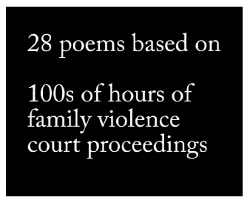
The video has the same combination of near-documentary authenticity and artistic control. It starts with a 911 telephone call from a man who has harmed his own children. There is a terrible moment when he is asked what has happened and he breaks into hysterical tears and says “They got stabbed”, as if somebody else might have done it. It ends with Martha reading aloud from one of her own poems, “Practice Tips”, which is based on the Center for Criminal Justice Advocacy‘s “Criminal Pre-Trial and Trial Practice”:
Play the tape 10 times at trial.
The jury will become accustomed to the carnage…
Obfuscate. Whine. Grandstand.
Fumble with your papers.
The fact that Martha feels equally at home working with both the written word and the camera, and therefore feels able to shoot her own video as a means of publicising her collection of poems, is an indication of the way in which digital technology is beginning to influence literary practice at grass-roots level. But the influence goes further. As well as conventional verse, her collection contains a number of visual poems – you could almost call them diagram poems – combining text with graphic design. “Jury Pool”, for example, shows a number of black stick-figures in and around the jury pool, labelled with reasons why they have been disqualified from the jury, or factors which will influence their outlook on the case: “Have to go back to school”, “Ate lunch with defendant’s mother”, “Crime victim”, “Don’t understand English”, and so forth. Including a diagram-poem such as this in a collection of poetry would not have been impossible before digital technology came along, but the fact that software packages such as Microsoft Word and Open Office Writer can handle images as easily as text, and make it simple to customise page-design without incurring any extra cost, means that poets now have an enormous range of experimental possibilities constantly at their fingertips.
Furthermore a lot of writers haven’t just moved beyond the pen or the portable typewriter to computers and word processing software; they have moved on to such things as blogs and web-pages, which have built-in multimedia capabilities. Sound-files and videos are rapidly becoming a normal part of the amateur writer’s working environment, and as a result the combination of text with other media is becoming a grassroots staple rather than a specialists-only field.
The Lost Shoeis published by Naissance Chapbooks, run by Dan Waber. A glance through Waber’s catalogue is enough to confirm the effect which digital technology is starting to have on poetic style. Amongst more formally conventional poetry he publishes, for example, Psychosis by Steve Giasson, which is based on comments collected by a YouTube posting of the shower scene from Psycho:
kthevsd Lame movies ? Kid I like all movies, old films, new films, etc. How is this classic lame ? Have you even ever watched it ? What would some 16 year old teenybopper know about cinema ? You probably have never even heard of Kurosawa and I bet you have never even seen a Daniel Day Lewis or Meryl Streep movie in your life. No wonder everyone laughs at your generations taste…
Or there is a collection by Jenny Hill called Regular Expressions: the Facebook status update poems –
Ron: I delivered a fucking BABY tonight! Yep, a fucking BABY!!!!!!!!! what did
u do today? Nursing school is AWESOME!!!!!!!
Someone asks if it was slimy, another wants
the placenta, most are stumped
at how to comment
on all your exclamation marks.
Then there is Watching the Windows Sleep by Tantra Bensko, which combines “fiction, poetry, and photographs”; or Open your I by endwar, which is “at times concrete, at times typoem, at times visual poem, at times conceptual poem, at times typewriter poem”. It is clear that the digital revolution has affected all of these collections in one way or another – either by making a wider range of experimental options available, or by providing them with their inspiration and subject-matter.
Of course, these are atypical exhibits, because Dan Waber, the publisher, is clearly interested in adventurous and experimental kinds of poetry. He also publishes a series called “This is Visual Poetry“, which now runs to about fifty full-colour booklets of visual poems, “answering the question [What is visual poetry?] one full-color chapbook at a time”, and answering it extremely variously. All the same, even allowing for Waber’s adventurous tastes, the fact that within a couple of years he has managed to put together fifty chapbooks of visual poetry, plus nineteen “conventional” poetry collections which often show clear signs of technological influence, is strongly suggestive of the directon in which things are moving.
Just as noteworthy is the business-model behind Waber’s publishing ventures. Basically, his operation relies on three key elements. The first is print-on-demand technology, which has almost completely done away with the printing expertise on which book production used to rely. These days, as long as writers can produce a competently-laid-out electronic original it can be turned into a book at the touch of a button. Colour reproduction is slightly more expensive than black-and-white, but not prohibitively so. Standards of reproduction are undoubtedly lower than they would be in the hands of a specialist printer, but most people never notice the difference. Self-publishing ventures such as Lulu (www.lulu.com) rely on this kind of print-on-demand process, and although Waber sends his electronic originals to the local print shop rather than using a completely automated online process, the technology is the same.
However, whereas the Lulu publishing process involves quite a bit of donkeywork (and usually a crash course in book-design and pagination) on the part of the author, the second key element of Waber’s publishing model is a drastically simplified and stringent set of layout criteria. Submissions to the visual poetry series must be “17 color images of visual poems of yours that are 600 pixels wide by 800 pixels tall”; and submissions to the Naissance chapbook series must be a maximum of 48 pages, in A4 portrait layout, with specified page-margins. Waber has designed a macro which takes Word files laid out according to these specifications and converts them instantaneously into print-ready book originals. This means that responsibility for the page layout is left squarely with the author – as Waber’s guidelines say, “all you need to do is make each page look how you want it to look… and we’ll convert it” – with the added effect that as long as authors stay within the guidelines, they are free to experiment as much as they like.
This combination of strict limitations and artistic freedom has undoubtedly helped to foster some of the adventurous design his chapbook series displays. At the same time, however, Waber has eliminated so much complexity from the publishing process that the third key element of the business model looks after itself: his costs (including time-costs) have come right down, to the point where he can show a modest profit on print-runs as low as ten units. All he has to do is decide whether he wants to publish something: if he does, he runs his macro, sends his print-ready file to the printer, and has ten copies of the chapbook in his hands within 24 hours. As he writes with understandable pride:
The beauty in all of this is no cash outlay. No huge print runs. No wondering if there’s grant money to support it, no worrying if it’ll actually sell enough to cover costs. It’s all profit after one copy sells… I am in a situation where because I make money off of every book I publish, all I need to do is find more books to publish. Because I de-complexified the process so completely.
Waber believes that his kind of venture represents the way forward for literary publishing in the era of digital technology, and he also believes that it is the kind of solution which can probably only come from outside the existing print industry, not from inside, because, as he puts it, “Big Publishing has a model that is blockbuster-based”. To explain this more fully, he cites an article by Clay Shirkey called “The Collapse of Complex Business Models“, which argues that big and complex businesses become unable to adapt to new circumstances, because their ideas about how they should operate become culturally embedded. If the new circumstances are sufficiently challenging then the only way forward will be for big organisations to collapse, and for new small ones, without the same culturally embedded assumptions, to take their place.
When ecosystems change and inflexible institutions collapse, their members disperse, abandoning old beliefs, trying new things, making their living in different ways than they used to… when the ecosystem stops rewarding complexity, it is the people who figure out how to work simply in the present, rather than the people who mastered the complexities of the past, who get to say what happens in the future.
This, argues Waber, is likely to be the ultimate effect of the digital revolution on the publishing industry; not simply dramatic changes in publishing formats and marketing methods, but a complete collapse of “Big Publishing”, and a multitude of small-scale, dynamic new ventures like his own, growing up out of the wreckage.
Clearly this is something that publishers themselves are worried about. As Michael Bhaskar writes in his blog for The Poole Literary Festival’s New Media Writing Prize,
On the writing side I often hear that people feel ignored by publishers.Essentially the world of commercial publishing is a closed shop unwilling to listen to the maverick, the outsider and the original, and will ultimately pay for this as audiences gravitate to newer and amorphous forms… This might be an argument for by-passing publishers or intermediaries altogether… [but] what I would like is mediation.
Clay Shirkey quotes the example of the “Charley bit my finger” video on YouTube to illustrate how production values have changed:
The most watched minute of video made in the last five years shows baby Charlie biting his brother’s finger… made by amateurs, in one take, with a lousy camera… Not one dime changed hands anywhere between creator, host, and viewers. A world where that is the kind of thing that just happens from time to time is a world where complexity is neither an absolute requirement nor an automatic advantage.

The “not one dime changed hands anywhere” line is perhaps a bit of an oversimplification. Wikipedia notes that “According to The Times, web experts believe the Davies-Carr family could earn £100,000 from ‘Charlie Bit My Finger’, mostly from advertisements shown during the video.” (http://en.wikipedia.org/wiki/Charlie_Bit_My_Finger) But the Davies-Carrs didn’t make or post the video with the intention of becoming celebrities or making money. They posted it so that it could be viewed by the boys’ godfather. The success of the video, in other words, owes nothing to its production values or to any marketing strategy, and everything to the environment created by YouTube and its viewers.
An alternative to the Big Publishing model is already with us, and despite odd viral phenomena like “Charlie Bit My Finger”, it consists in the main of very large numbers of small-scale products reaching small audiences, rather than small numbers of very high-profile products reaching huge audiences. This alternative model is enabled by digital technology, and it replaces high production values and market-minded editorial controls with the principle that people’s desire to publish themselves and to look at each other’s efforts is itself a profit motor. No single book published by Lulu, for example, has to sell a lot of copies for Lulu itself to make a profit – it’s the volume which counts. The same is true of YouTube, and it’s also true, on a much smaller scale, of Dan Waber’s enterprise.
YouTube is now crawling with people hoping to become the next viral phenomenon – and there are also a number of talented individuals who have built up sizeable audiences on YouTube and who are making decent amounts of money out of those audiences – but the really big money is being made not by the people who contribute material, but by YouTube itself. The same is true of print-and-paper publishing via Lulu. The removal of editorial constraint has greatly freed up and democratised the creative side of the publishing process, but on the other hand, a system where most writers made relatively small amounts of money compared to publishers and agents is being increasingly shoved aside by a new system where most creators make no money at all, while the publishers do very nicely.
Add to this the fact that YouTube is now in the hands of Google – the same Google which has been “creating an impenetrable content monopoly” over digitised books through the Google Books programme – and the future of publishing starts to look less like an open field for small enterprises, created by the collapse of big corporations, and more like a battleground where a few monster Web 2 corporations – Amazon/Kindle, YouTube/Google and Apple – are carving up the territory as fast as they can, much as the major European countries carved up Africa during the nineteenth century.
What the future really holds for the publishing industry is probably a mixture of these two scenarios. It’s unlikely that conventional publishing is going to disappear any time soon, but in a shrinking market publishers are going to be more and more reluctant to publish untried material, more and more inclined to go with material which seems to tap into an already-established audience. The celebrity biography or autobiography; the book of the comedy series; the first novel by a TV personality; these are already familiar. The book version of a popular blog and the “global distribution” edition of something which has already sold very well via the Web are going to become increasingly familiar in the near future. Add to this books with associated websites, increasing emphasis on ebooks, and a cautious trial of ebooks with interactive elements, and you have a pretty good picture of how the conventional publishing industry is shaping up to deal with the digital revolution.
In the meantime, entrepreneurs like Dan Waber are taking fuller advantage of the new possiblities offered by digital technology, and perhaps planting the seeds for a whole new generation of publishing houses; while writers like Martha Deed and Leanne Shapton, under the influence of the digital revolution, are redefining literary genres.
But one consideration which should not be overlooked in all this is the importance of open standards. The digital revolution itself is predicated not only on technical advances – such as broadband, print-on-demand, digital video and multimedia handheld devices – but on the Web itself, and in particular on the fact that the Web is non-commercial and belongs to all its users. Material which appears on the Web doesn’t have to comply with a proprietary format laid down by any one corporation: it has to comply with standards laid down by the World Wide Web Consortium. It is this open structure which has enabled the Web to develop so rapidly and to serve as a framework within which so many enterprises have been able to flourish. For the field of publishing to flourish in the same way, open standards need to prevail here as well – open standards for ebooks, for example, so that standards-complaint work will be viewable on a whole range of different devices. Only under those circumstances can small enterprises and individual artists stand some kind of chance against the big corporations.
http://www.hyperex.co.uk/reviewdigitalpublishing.php
© Edward Picot, August 2010
© The Hyperliterature Exchange
Above image taken by Scott Beale, Laughing Squid.
Marc Da Costa interviews the ever dynamic Johannes Grenzfurthner, founder of monochrom. This is the first of three interviews, where he talks about the project ‘Soviet Unterzoegersdorf’; the fake history of the “last existing appanage republic of the USSR”. Created to discuss topics such as the theoretical problems of historiography, the concept of the “socialist utopia” and the political struggles of postwar Europe. In March 2009 Monochrom presented ‘Soviet Unterzoegersdorf: Sector II’. The game features special guest appearances of Cory Doctorow, Bruce Sterling, Jello Biafra, Jason Scott, Bre Pettis and MC Frontalot.
Since 1993, the Monochrom members have devoted themselves to the grey zones where systems intersect: the art (market), politics, economics, pop, gaiety, vanity, good clean fanaticism, crisis, language, culture, self-content, identity, utopia, mania and despair. The technique underlying Monochrom’s work is that of being and working in the fields of Pop/avant-garde, theory/reflection, interventionism/politics, gaiety/lust/tragedy, (self-)configuration/mystification. The project Monochrom pushes into and beyond these fields is, ‘networking’ events, people, possibilities, material, impetus and identities.” (Zdenka Badovinac, Moderna Galerija Ljubljana)
Grenzfurthner has collaborated with groups such as ubermorgen, Billboard Liberation Front, Esel and Mego (label). Grenzfurthner writes for various online/print magazines and radio stations (e.g. ORF, Telepolis, Boing Boing). Grenzfurthner has served on a number of art juries (e.g. Steirischer Herbst, Graz). He holds a professorship for art theory and art practice at the University of Applied Sciences, Graz, Austria and is a lecturer at University of Arts and Industrial Design in Linz, Austria.
Recurring topics in Johannes Grenzfurthner’s artistic and textual work are: contemporary art, activism, performance, humour, philosophy, sex, communism, postmodernism, media theory, cultural studies, popular culture studies, science fiction, and the debate about copyright.
The ‘Soviet Unterzoegersdorf’, a game created by monochrom, is described as being at once the “last existing appendage republic of the USSR” and located inside the Republic of Austria. Could you speak a bit about the project and its background?
From a conceptual background we have to state that we have been occupied with the construction, analysis and reflection of alternative worlds for quite a long time. A lot of our projects are treating this field partly as a discussion with concepts deriving from popular culture, science and philosophy, and partly as a direct reference to science fiction and fantasy fan culture. We first created the fake history of the “last existing appendage republic of the USSR” in 2001 — ten years after the ‘mighty Soviet Union’ went into this nation-state-splitting-up-process and new countries emerged like Firefox pop-ups that you can’t manage to click away.
We wanted to discuss topics such as the problems of historiography, the concept of “utopia” and “socialist utopia” and the political struggles of postwar Europe in a playful, grotesque way. You have to bear in mind that the real village of Unterzoegersdorf was part of the Post WWII Soviet zone from 1945 until the foundation of the ‘neutral’ Republic of Austria in 1955. Reactionary Austrians talk about 1955 as the ‘real liberation’… and I have to mention that that’s rather typical: cheering when Hitler arrives and being proud members of the Third Reich, afterwards proclaiming that Austria was the first victim of Nazi Germany and complaining about the allied occupation forces — especially the Soviet.
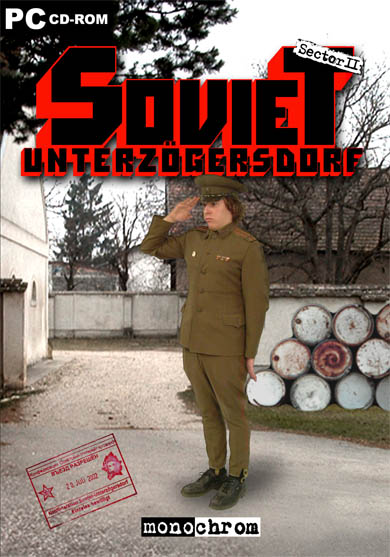
We transformed the theoretical concept into an improvisational theatre/performance/live action role-playing game that lasted two days. That means we really organized bus tours to Unterzoegersdorf — a small village that really exists — and acted the setting; beginning with the harsh EU Schengen border control. Later, in 2004, we started to think about a possible sequel to the performance. We thought that the cultural format of the “adventure game” provided the perfect media platform to communicate and improve the idea.
We started to work in February 2004 and presented ‘Sector 1’ — the first part of the trilogy — in the form of an exhibition in Graz/Austria in August 2005. We released ‘Sector 2’ in 2009, featuring guest stars as Cory Doctorow, Jello Biafra or Bruce Sterling. As the game series uses a 3rd person perspective with photo backgrounds and pictures of real actors as sprites, it took us quite a while to digitize and image process all of the material. This technique was actually first used by Sierra On-Line during the early and mid-1990s — but we are quite proud that we managed to get the feeling of discovering an old computer game that never existed on your old 500 MB hard drive. One aspect of the game is playing with memories and the future of the past. The future is a kind of carrot, the sort tied just in front of the cartoon donkey’s nose so it goes to work, goes off to war, learns Javascript and knows which bits to laugh at in Woody Allen’s Sleeper. You can imagine.
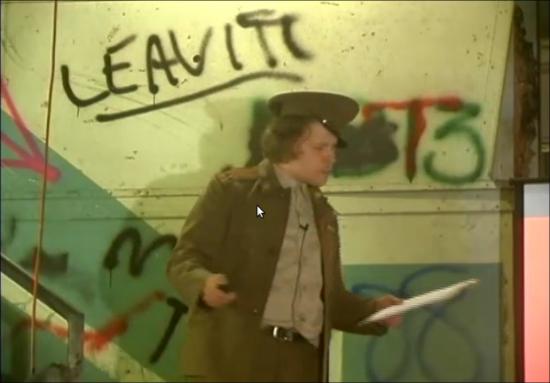
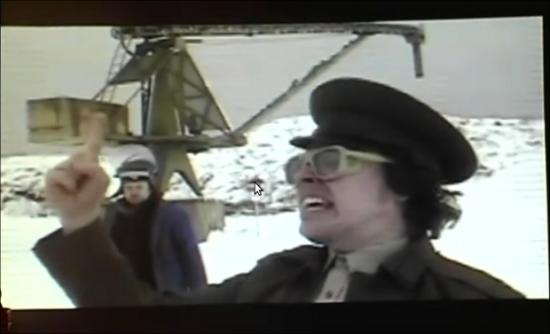
At a HOPE conference a few years back I was interested to hear you talk about the framing of the project as somehow deeply connected with a certain understanding of historiography that you and the other members of monochrom share. Could you elaborate on this a bit?
Debates triggered by postmodern culture have directed our attention towards questions of representation and the relevance of “history” and stories — i.e. The challenging proclamation of a post-histoire, the realization of the impossibility of a meta-narrative of history; the clash between reality and sign systems, the difference between fact and fiction, the impossibility of neutral contemplation or witnessing as well as the positioning of subjective awareness within such representations, etc. All these forms of representation have been playing a central part in the development of national, ethnic and tribal identities since WWII. And (as a by-product of military technology) computer game development is hardly aware of these discourses.
We wanted to combine (retro)gaming and (retro)politics and (crypto)humor to delve into this ongoing discourse. We wanted to harvest the wonderful aesthetic and historic qualities of adventure gaming. It is a commemoration and resurrection, and one more reminder that contemporary gaming (in its radical business-driven state-of-the-artness) should not dare to forget the (un)dead media of the past — or they will haunt them.
If you compare the status of the adventure game in the context of the economic growth of the computer game industry you could state that it is gone. Less than 1% of all computer games written are adventure games. Adventure games are nearly extinct… but only nearly. If media and media applications make it past their Golden Vaporware stage, they usually expand like giant fungi and then shrink back to some protective niche. They just all jostle around seeking a more perfect app.
For many people in the Soviet Unterzoegersdorf team, adventure games are part of their media socialization. For the computer industry it is one of the most successful gaming formats of the past. And for the feminist movement it is proof that a woman — I’m talking about Sierra On-Line’s Roberta Williams — was able to shape the form of a whole industry totally dominated by men.
Computer games are embedded in the cultural framework of technological developments. In the study of technological development and creativity, focusing attention on the failure, the error, the breakdown, the malfunction means opening the black box of technology. Studies have convincingly demonstrated that the widespread inability to understand technological artifacts as fabricated entities, as social and cultural phenomena, derives from the fact that in retrospect only those technologies that prove functional for a culture and can be integrated into everyday life are “left over.” However, the perception of what is functional, successful and useful is itself the product of social and cultural–and last but not least–political and economic processes. Selection processes and abandoned products and product forms are usually not discussed. According to Langdon Winner, there is a sense in which all technical activity contains an inherent tendency toward forgetfulness. Quote: “Is it not the point of all invention, technique, apparatus, and organization to have something and have it over with? (…) Technology, then allows us to ignore our own works. It is license to forget.”
Could you also perhaps talk about the choice of selecting the genre of an adventure game as the incarnation of this downtrodden republic. At the risk of being literal minded, is there any sense in which the existence of ‘Soviet Unterzoegersdorf’ as a kind of place that comes alive through players’ interactions with a program downloaded from the internet has anything to say to how you imagine being able to engage/critique/disrupt the idea of the nation-state?
We are postmodern leftists. A little bit melancholic… but you can count on us. We love to play with layers of consciousness and layers of layers of consciousness. On first view our project could be interpreted as a mock-up of the Soviet Union and the communist state structures that really existed. But, why on Earth do we need so many references to 1980s and 1990s metal music? Or Marvin Minsky? Or Negri? Or Austrian post-WWII history? Or geek adumbrations? Mocking the Soviet State would be much easier. In fact it’s about the wonderful clash between reality and sign systems, the impossibility of neutral contemplation or witnessing as well as the positioning of subjective awareness within such representations. The traditional humanists tend to see the whole philosophic aesthetic postmodern line of thought — from Judith Butler to Lyotard and Derrida — from the wrong angle. Okay, you can’t explain Sun Ra to a Green Day fan now, when he’s laying in the corner, piss-drunk and crooning “Anarchy”. But we think that the (radical) nature of postmodernism is often simply not grasped because people just copy it down into the conservative pattern of thinking which has been indoctrinated into us since the Enlightenment. Of course, on the other hand, it functions as a virus, and there’s nothing wrong with that.
Contemporary art — the field we are usually working in because there’s money — is mostly concerned with systems or systematic concepts. In the context of their work, artists adapt models of individual art-specific or economic or political systems like in a laboratory, to reveal the true nature of these systems by deconstructing them. So would it be fair to say that by their chameleon-like adaptation they are attempting to generate a similar system? Well… the corporate change in the art market has aged somewhat in the meantime and looks almost as old as the ‘New Economy’. Now even the last snotty brat has realized that all the hogwash about the creative industries, sponsoring, fund-raising, the whole load of bullshit about the beautiful new art enterprises, was not much more than the awful veneer on the stupid, crass fanfare of neo-liberal liberation teleology. What is the truth behind the shifting spheres of activity between computer graphics, web design and the rest of all those frequency-orientated nerd pursuits? A lonely business with other lonely people at their terminals. And in the meantime the other part of the corporate identity has incidentally wasted whole countries like Argentina or Iceland. That’s the real truth of the matter.
Read Part 2 of this Interview
http://www.furtherfield.org/features/interviews/interview-johannes-grenzfurthner-monochrom-part-2
Read Part 3 of this Interview
http://www.furtherfield.org/features/interviews/interview-johannes-grenzfurthner-monochrom-part-3
‘Living’ is the result of a six month residency at the V&A by Christian Kerrigan – from January to June 2010 – and it is part of The 200 Year Continuum. The 200 Year Continuum is the title of a project by the same artist that explores the relationship between nature and technology. Interestingly ‘Living’ was exhibited in the same space where it was created: in the digital studio of the V&A. This was a small room with dim light and crowded with rarities. It felt like one was penetrating the secretive and magical space of experimentation of some sort of mad professor.

Once in the space my gaze wandered around a series of oddities. On the right, a table full of raw materials; in the middle of the room, a fish tank with algae floating in high pH waters; on a wall, a real time video projection showing the evolution of the algae; on a different wall, a slide projection showing some drawings; in some shelves, notebooks with notes by the artist; above the sink, chemical products piled up on a shelf; and on each and every window a semi-transparent drawing. No explanations, no titles, nothing. It’s you and the objects. Luckily Christian Kerrigan was always about, meeting visitors and discussing the work. We started looking at the materials on the table. Christian told us those were unprocessed rocks and crystals that he used as the starting point for his drawings. He scanned pieces of amber, moss, fiber glass, volcanic rock or resin and produced a model using 3D software. Then he manipulated that model to create his drawings and printed them on semitransparent paper. He eventually placed them on the windows of the space. This routine allowed him to explore the different stages of a process that makes real matter and virtual space intermingled. It is a practice that explores where the process of creation begins, and what it does to reality. ”The drawings, he tells us, become extensions of the physical material which I started with.” Although we have become accustomed to discuss the hybridity of our nature-culture, the way Christian carefully interwove materialities and virtualities was very evocative. The fact that the drawings were placed on the windows gave yet another layer of complexity to the mixture. The colours of the printings morphed natural light into a hybrid light turning the atmosphere of the room into a creative and ongoing process.
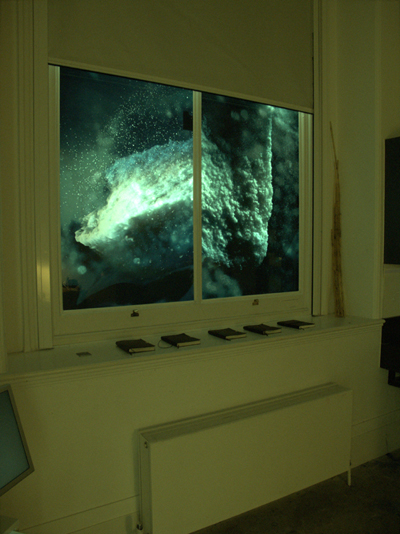
Next I wondered about that mysterious fish tank in the middle of the room where algae lived (and died) in high pH waters: Encased Nature. Apparently the algae reacted to the elevated pH creating a protective coat that eventually killed them. At the bottom of the tank: a graveyard of coated dead algae showed the consequences. I instantly loved the idea. Again an experiment about the hybridity of natural and controlled habitats. I thought it was a particularly dystopic illustration of the environment we inhabit where control works on the conditions of the environment, dictating the way reality unfolds. This is an emerging tendency in our most-discussed societies of control, what has come to be called soft control. And we could take it even further, and see it as a great illustration of today’s climate of fear. In such a habitat, the threat has become virtual and all-pervasive, it has become poisonous in itself, just like high pH. The nightmare of security measures that this artificially produced environment justifies links quite well to the ‘lethal-protective’ coat. What this allegory leaves out, though, is the power of imagination! The capacity of conditions to be turned around, the potential for intervention and deviation from the pre-programmed chain of (re)actions. The idea of projecting a live video recording on the wall was to intensify the experience and highlight the importance of mediation. As Christian argued, we are now more used to experience nature through a lens than to experience its presence. However, the quality of the footage seemed to work against the intentions of the artist and rather than intensifying the experience of that enclosed nature, it tended to obscure it. The particular texture that the webcam gave to the recordings turned that hybrid habitat almost into an abstract movie. On a different corner there was another video projection made out of a series of drawings. Interestingly they had been created using a ‘living technology’ and recorded at a nano-scale. For Living Drawing, the artist had collaborated with Martin Hanczyc from the Department of Physics and Chemistry at the University of Southern Denmark. They had manipulated some protocells that inhabited chemical gradients and reacted to ultraviolet light. When UV light was applied to the fiberglass where these protocells ‘lived’ their motion left traces of colour that were recorded. This technique, although still in its early stages, allowed the artist to ”explore the spontaneous event of drawing by using organic systems”, he told us. Kerrigan’s rather cryptic exhibition proved to be an inspiring and very personal exploration of the blurring between nature and culture in its absolute physicality. Paying particular attention to the materiality of the creative process, from the composition of the materials used, to the chemistry of the drawing process or to the laws of electromagnetism that inform light in its interaction with his work, his methodologies show a passion for unfolding reality in its many scales. His work is that of someone who’s starting to explore rather than someone who’s making an assertion; it is tentative rather than conclusive, it is interesting for its questions rather than its answers. However, even if sometimes vague, it is at points pleasingly dark and sometimes inspiringly intense.
HTTP Gallery is pleased to host LAB4 by Hedva Eltanani, an exploration of communication between two places using streaming media and web applications. It is another step in a series of LABs that explore digital technology and audience interaction. It is part of Heltanani’s research on digital performance and the way it affects audience experience.
LAB4 is a game that challenges the audience to bend the boundaries of space, interaction and intimacy. The two locations, HTTP Gallery in London and The Poly Centre in Falmouth, are linked via live-feed technology, using webcams and web applications. Eltanani will lead a series of activities, such as ‘truth or dare’, which challenges elements of group dynamics and technology – the aim is to engage the two audiences and help participants bond within each group.
How intimate will it go? The participants are invited to deepen the connection by keeping their community active using web applications.
BE PART OF THE EVENT IN LONDON
Doors open at 8:30pm
More info and documentation :
http://arthubfalmouth.blogspot.com/
http://vs4rslab.wordpress.com/
Featured image: People watching and being watched across virtual space
Ambient Information Systems
English, some texts in German. Translator: Nicholas Grindell
400 pages, 6-colour hardbound, 17.5 x 23 cm
edition of 1,500 unique & numbered.
now available at ambient.publishing.
ISBN-13: 978-0-9556245-0-6
Ambient Information Systems by Manu Luksch and Mukul Patel is a hardback book that presents writing, images and art by and about ambient.tv (Luksch and her collaborators) from during the last decade. Its purple and yellow cover tempered by a tracing paper slip-cover, contains almost four hundred pages of sans-serif text cleanly laid out among images and sidebars. As intermedia artists with a strong emphasis on research and dissemination. Recent works have addressed surveillance, corporate data harvesting, and the regulation of public space.
The material presented in the book ranges from written essays and project proposals through preparatory sketches, computer server log files and video screen grabs to modification of the printed book iteslf by unique rubber stamps and scribbling over sections of text. This diverse and detailed presentation of ambient.tv’s work provides an insight into the inspiration, planning and production of some conceptually and aesthetically rich new media art.
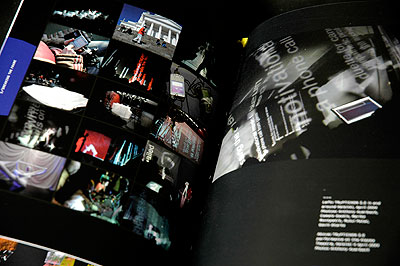
There’s a report from Kuwait during Ramadan 2002, a description of using cutting-edge wearable PCs, a discussion of the role of television, information about the harp in mythology, cyborg markets, the UK Data Protection Act, climate change, anti-gentrification, art and systems theory, UAVs, the Pacific plastic dead zone, and much, much more. There are projects that create free networks, dangerous musical instruments, taped-out surveillance camera boundaries, video installations, photographic images, movies of CCTV footage gained through freedom of information requests, manifestos, snowglobes, and cocktails.
(It’s a fascinating pleasure to read but it’s overwhelming to try and review.)
The portrait of Ambient.tv that emerges from all this is of intensive cultural critique pursued through a playful low-fi digital aesthetic. This isn’t a contradiction, the latter is in the service of the former. Ambient.tv’s projects and proposals tackle serious social and political issues. They do so through skilled use of the aesthetics and attitude of low-fi new media art and technological activism.
The wealth of ideas contained in the essays and other writing in the book show how historical, political and philosophical knowledge grounds the resulting art and indicates how it embodies a critique of contemporary culture.
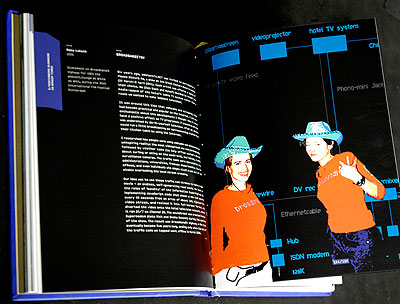
Contemporary culture as seen by Ambient.tv is surveillance culture, the database state with its DNA databases and laws that protect freedom by removing freedom. Ambient.tv is a realistic project, depicting the hidden forms of contemporary society that intrude into our lives. This is heavy stuff, and to air it critically without alienating the audience it requires precisely the playful touch that ambient.tv often bring to their art.
To take the example of FACELESS, 2007, (the first project I personally saw Luksch present), there is an exquisite balance between the disturbing idea of pervasive surveillance, the practical limitations of Freedom Of Information requests, and the visual and science-fictional narrative aesthetic that emerged from this. On their web site it states that it was produced “…under the rules of the Manifesto for CCTV Filmmakers. The manifesto states, amongst other things, that additional cameras are not permitted at filming locations, as the omnipresent existing video surveillance (CCTV) is already in operation.” The result is something more interesting and disturbing to watch than a simple collage of CCTV footage would be. The fact that the work can be made like this, that it can look like this, means something.
This strategy can be seen in “Mapping CCTV around Whitehall”, 2008, as well, which I also reviewed for Furtherfield here, and in many other pieces by Ambient TV.
Reading the proposals and essays shows the depth I suspected to this work, when I first saw it projected in a darkened room is there in its conception and execution.
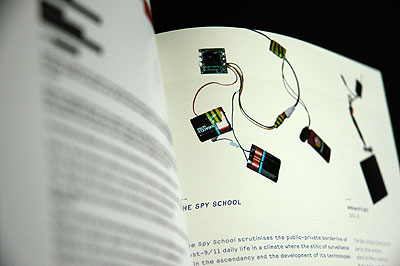
It’s an intense and inspiring experience to be faced with the textual equivalent of a decade-long open studio. The first essay in the book, a theory-laden piece by Fahim Amir, is almost overwhelming in a different way. It’s pure Theory, which will hopefully sell Ambient.tv to the artworld sectors that thrive on that sort of thing, but it isn’t the best introduction for newcomers to the project’s very accessible art.
But what a rare pleasure to be given such a wealth of insight into art that so acutely depicts our times. “Ambient Information Systems” is an important resource for contemporary artists and critics, an insight into the ideas and development of a very successful new media art practice. The grungey, playful, important realism of Ambient.tv’s work deserves presentation in a context that shows just what has gone into the art and just what people can get out of it. This is it.
The text of this review is licenced under the Creative Commons BY-SA 3.0 Licence.
Article by Rosa Menkman
Based on an interview with the Critical Glitch Artware Category organizers and contenders of Blockparty and Notacon 2010: jonCates, James Connolly, Eric Oja Pellegrino, Jon.Satrom, Nick Briz, Jake Elliott, Mark Beasley, Tamas kemenczy and Melissa Barron.
From April 15-18th, the Critical Glitch Artware Category (CGAC) celebrated its fourth edition within the Blockparty demoparty and this time also as part of the art and technology conference Notacon.
The program of the CGAC consisted of a screening curated by Nick Briz, performances by Jon Satrom, James Connolly & Eric Pellegrino, and DJ sets by the BAD NEW FUTURE CREW. There were also a couple of artist presentations and the official presentation of a selection of the (115!) winners within the Blockparty official prize ceremony.
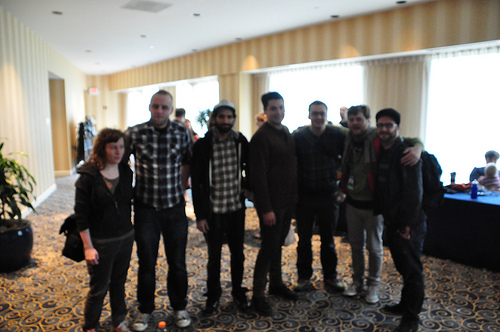
The fact that CGAC was coupled with a demoscene event is somewhat extraordinary. It is true that both the demoscene and CGAC or ‘glitchscene(s)’ focus on pushing boundaries of hardware and software, but that said, I (as an occasional contender within both scenes) could not think about two more parallel, yet conflicting worlds. The demoscene could be described as a ‘polymere’ culture (solid, low entropic and unmixable), whereas CGAC is more like an highly entropic gas-culture, moving fast and chaotically changing from form to form. When the two come together, it is like a cultural representation of a chemical emulsion; due to their different configuration-entropy, they just won’t (easily) mix.
But all substances are affected (oxidized) by the hands of time; there is always (a minimal) consequence at the margin. And this was not the first time these two cultures were exposed to each other either; Criticalartware had been present at Blockparty since 2007. Moreover, a culture can of course not be as strictly delineated as a chemical compound; it was thus clear that this year the two were reacting to each other.
While over the last couple of years the demoscene has been described in books, articles and thesis’, this particular kind of ‘fringe provocation’ is not what these researchers seem to focus on; they (exceptions apart) concentrate on the exclusivity of the scene and its basic or specific characteristics. The ‘assembly’ of these two cultures during Blockparty could therefore not only serve as a very special testing moment, but also widen and (re)contextualize the scope of the normally independent researches of these cultures. So what happened when the compounds of the chemicals were ‘mixed’ and what new insights do we get from this challenging alliance (if there is such a thing)?
The demoscene is often described as a bounded, delimitated and relatively conservative culture. Its artifacts are dispersed within well-defined, rarely challenged categories (for the contenders, there is the ‘wild card’ category). Moreover, the scene is a meritocracy – while the contenders (that refer to themselves with handles or pseudonyms) within the scene have roles and work in groups, the elite is ‘chosen’ by its aptitude.
The demoscene also serves a very specific aesthetics, as enumerated by Antti Silvast and Markku Reunanen this week on Rhizome (synced music and visuals, scrolling texts, 3d objects reflections, shiny materials, effects that move towards the viewer – tunnels and zooming – overlays of images and text, photo realistic drawing and adoption of popular culture are the norm). In the same article Silvast and Reunanen declare that: ‘Interestingly, even though we’re talking about technologically proficient young people, the demosceners are not among the first adopters of new platforms, as illustrated by numerous heated diskmag and online discussions. At first there is usually strong opposition against new platforms. One of the most popular arguments is that better computers make it too easy for anybody to create audiovisually impressive productions. Despite the first reactions, the demoscene eventually follows the mainstream of computing and adopts its ways after a transitional period of years.'[1]
More about this can be read at Rhizome’s week long coverage of the demoscene. Silvast and Reunanen’s statement might be most interesting when we move along to see what happened during the meeting of the two scenes.
Co-founded by jonCates, Blithe Riley, Jon Satrom, Ben Syverson and Christian Ryan in 2002, Criticalartware is a radically inclusive group that started as a media art history research and development lab. Since 2002 the group has shifted and transitioned. Criticalartware’s formation was deeply influenced by the Radical Software platform (publications and projects). Since then it has been an open platform for critical thinking about the use of technology in various cultures. Criticalartware applies media art histories to current technologies via Dirty New Media or digitalPunk approaches. Through tactics of interleaving and hyper threading it permeates into cultural categories of Software Studies, Glitch Art, Noise and New Media Art.
During the first phase of Criticalartware (from 2002 – 2007), the group was a collaborative of artist-programmers/hackers. It also functioned as a media art histories research and development lab. In this form, Criticalartware had become an internationally recognized and reviewed project and platform.
When this phase ended in 2007, jonCates, Tamas Kemenczy and Jake Elliott were the remaining active members of Criticalartware. During this time, Elliott and Kemenczy wanted to take the project in a new direction; into the demoscene. This direction has ultimately defined the second phase of Criticalartware; an artware demo crew, making work for and appearing annually at the Blockparty event and Notacon conference in Cleveland.
2010 marked the next important transition for the Criticalartware crew, when it started using the phrase ‘Critical Glitch Artware’- Category. Criticalartware now not only organizes itself around the demoscene but also around the concept of the glitch. While a glitch (not to be confused with glitch art) appears as an accident or the result of misencoding between different actors, CA’s Glitch-art category exploits this possibility in an metaphorical way. Criticalartware is now foregrounding these glitch art works (with an emphasis on the procedural/software works) that have been on a ‘pivotal axis’ of the crew for a long time.
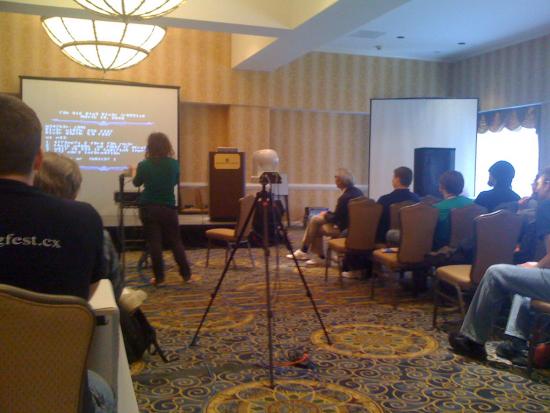
CGA, just like the demoscene, can be described as an open (plat)form for artistic activity/culture/way of life/counter culture/multimedia hacker culture and (unfortunately a bit of ) a gendered community. CA are about pointing out ideas or concepts within popular culture and incorporating (standardizing) these as machines or programs in a reflexive and critical self-aware manner.
CA can also be described as an investigating of standard structures and systems. They are often amongst early adopters of technology, in which they (politically) challenge and subvert categories, genres, interfaces and expectations. But the CGA – artists do not feel stuck in a particular technology, which makes it aesthetically, at least at first sight hard to pinpoint a common denominator.
There is not a real organization within this scene. The artists and theorists are scattered over the world, connected in fluid/loosely tied networks dispersed over many different platforms (Flickr, Vimeo, Yahoo groups, Youtube, NING, Blogger and Delicious).
Because of its bounded, intricate conservative qualities, the demoscene has been an easy target for outsiders to play ‘popular’ ironic pranks on, to misunderstand or misrepresent. A growing interest for the demoscene by outsiders has compelled jonCates and the Criticalartware crew to articulate their position towards the demoscene more extensively. In an interview with me, jonCates articulates Criticalartware’s points and contrasts these with problematic representations of the demoscene within two works by the BEIGE Collective (that in 2002 existed along side the Criticalartware crew in Chicago).
When the BEIGE collective went to the HOPE (Hackers on Planet Earth) Conference in 2002 they made a project called: TEMP IS #173083.844NUTS ON YOUR NECK or Hacker Fashion: A Photo Essay by Paul B.Davis + Cory Arcangel.
jonCates writes to me that ‘this problematic project characterizes or epitomizes a kind of artists as interlopers positionality that i + Criticalartware as a crew has always attempted to complicate. we do not want or understand ourselves as seeking out an ironic or sarcastically oppositional position in relation to the contexts that we choose to work in. we have not set out to ridicule the demoscene or otherwise make ridiculous our relations to the demoscene. in contrast, we set out to operate within a specific demoscene through multi-valiant forms of criticality, playfullness, enthusiasm, respect, interest, admiration, etc… this has also been in efforts to connect this specific demoscene to our experimental Noise & New Media Art scenes or what you Rosa referred to earlier as glitchscene…’
Another point of contention for jonCates is the Low Level All-Stars project by BEIGE (in this case, Cory Arcangel) + Radical Software Group (Alexander R. Galloway). this work is described as ‘Video Graffiti from the Commodore 64 Computer’ (2003) by Electronic Arts Intermix who sells/distributes this work as a video in the context of Video Art.
Low Level All-Stars has been shown at Deitch Projects in NYC in 2005 and circulated in the contemporary art world. jonCates writes to me saying the work seeks ‘to isolate + thereby establish cultural values for this ‘quasi-anthropological’ view of demos as found object + functioning as a tasteful ‘testament to a lost subculture.’ It is now being offered online as an educational purchase for $35 dollars.
However, as jonCates and Criticalartware work in the demoscene demonstrates, the demoscene subculture is not lost, nor over. jonCates moves on by writing that ‘the demoscene is a vibrant whirld wit a dynamic set of pasts + presents. this is another of which many (art) whirlds are possible. we seek to make those whirlds known to each others + ourselves out of respect, curiosity, investment, inclusiveness, criticality, playfullness, etc…’
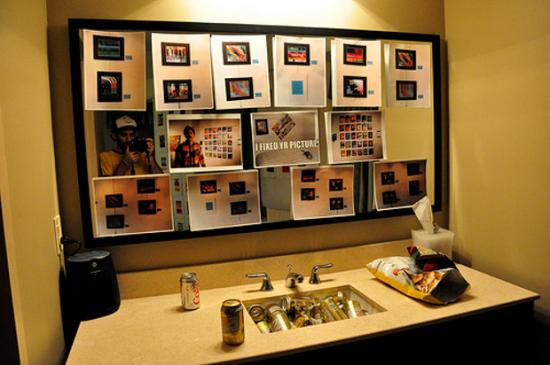
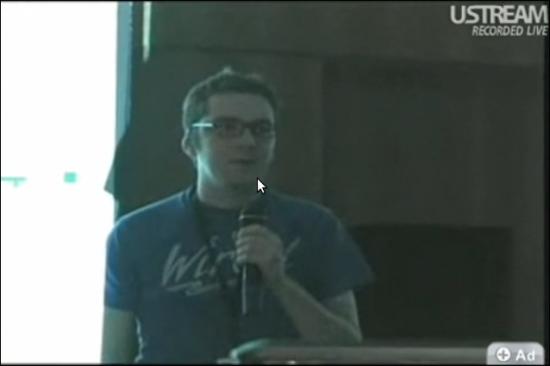
The Criticalartware crew has been taking part in Blockparty since 2007, when it won the last place in a demo competition and was disqualified. One year later, in 2008, through a number of efforts (including Jake Elliott’s presentation Dirty New Media: Art, Activism and Computer Counter Cultures at HOPE, the Hackers on Planet Earth conference in NYC in 2008). CA was able to mobilize and manifest the concept of the Artware category at Blockparty, a category which Blockparty itself retroactively recognized CA for winning.
In the same year (2009) CA organized a talk at Blockparty in which they revealed the “secret source codes” of the tool they used to develop the winning artware of the year before.
By 2010 CA wanted to expand the concept of Artware within the demoscene, which lead to the development of the ‘Critical Glitch Artware Category’ event. Within the CGAC Compo there where 115 subcategory winners, which showed some kind of glitch-critique towards systematic categorization of Artware. Jason Scott (the organizer of Blockparty) personally invited CGAC to pick 3 winners and present their wares at the official Blockparty prize ceremony. Besides these three winners, CGACs efforts got extra credits when Jon Satrom’s Velocanim_RBW also won the Wild card category compo.
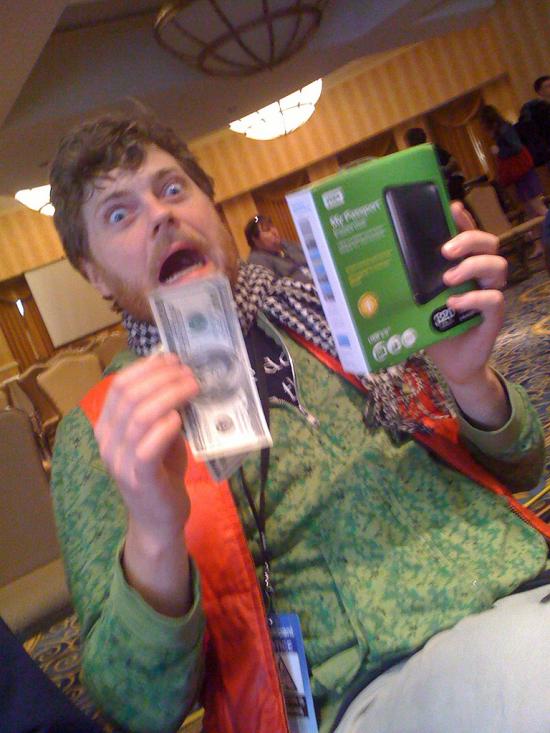
Therefore, not only did CA intentionally open up the Blockparty event to outsiders of the demoscene, it also provided a place for new media art and the glitchscene within the demoscene and got Blockparty to accept and invite the CA within their program. Thus, the outsiders (CA) moved towards the inside of the event, while the insiders got introduced to what happens outside of the demoscene (event), which led to conversations and insights into for instance bug collecting, curating and coding.
The Critical Glitch Artware Category has been accepted by, at least, the fringe of Blockparty 2010. Even though the category itself is not (yet) visible on the website, Satrom’s winning work Velocanim_RBW is. Moreover, CGAC was part of the official prize ceremony, streamed live on Ustream, the live Blockparty internet television stream. So how does CGAC redefine or reorganize the fringe between them and the demoscene and how does the demoscene redefine and reorganize the structure of CGAC?
For now, I think crystallized research into the aesthetics of the demoscene can also help describe the aesthetics within CGAC. Custom elements like rasters, grids, blocks, points, vectors, discoloration, fragmentation (or linearity), complexity and interlacing are all visually aesthetic results of formal file structures. However, the aesthetics of CGA do not limit themselves, nor should they be demarcated by just these formal characteristics of the exploited media technology.
Reading more about the demoscene aesthetics, I ran into a text written by Viznut, a theorist within the demoscene (who also wrote about ‘thinking outside of the box within the demoscene’). He separates two aesthetic practices within the scene: optimalism (an ‘oldschool’ attitude) which aims at pushing the boundaries in order to fit in ‘as much beauty as possible’ in as little code necessary, and reductivism (or ‘newschool’ attitude), which “idealizes the low complexity itself as a source of beauty.'[2]
He writes that “The reductivist approach does not lead to a similar pushing of boundaries as optimalism, and in many cases, strict boundaries aren’t even introduced. Regardless, a kind of pushing is possible — by exploring ever-simpler structures and their expressive power — but most reductivists don’t seem to be interested in this aspect”.
A slightly similar construction could be used for aesthetics within Glitch Art. Within the realm of glitch art we can separate works that (similar to optimalism) aim at pushing boundaries (not in terms of minimal quantity of code, but as a subversive, political way, or what I call Critical Media Aesthetics; aesthetics that criticize and bring the medium in a critical state) and minimalism (glitch works that just focus on the -low- complexity itself – that use supervisual aesthetics as a source of beauty). The latter approach seems to end in designed imperfections and the (popularized) use of glitch as a commodity or filter.[3]
Of course these two oppositions exist in reality on a more sliding scale. Debatebly and over simplified I would like to propose this scale as the Jodi – Mille Plateaux (old version) – Beflix – Alva Noto – Glitch Mob – Kanye West/Americas Next Top Model Credits continuum; A continuum that moves from procedural/conceptual glitch art following a critical media aesthetics to the aesthetics of designed or filter based imperfections.
This kind of continuum forces us to ask questions about the relationships between various formalisms, conceptual process-based approaches, dematerializations and materialist approaches, Software Studies, Glitch Studies and Criticalartware, that could also be of interest or help to future research into the demoscene. When I ask jonCates what other questions CGAC brings to the surface, he answers:
“when i asked Satrom to participate in the CRITICAL GLITCH ARTWARE CATEGORY event + explained the concept that Jake + i had developed to him he was immediately interested in talking about it as form of hacking a hacker conference, by creating a backdoor into the conference/demoscene/party/event. im also excited about this way of discussion the event + our reasonings + intentions, but i want to underscore that this effort is also undertaken out of respect for everyone involved, those from the demoscene, glitchscenes, hackers, computer enthusiasts, experimental New Media Artists, archivists, those who are working to preserve computer culture, Noise Artists + Musicians, etc… so while this may be a kind cultural hack/crack it is not done maliciously. we are playful in our approach (i.e. the pranksterism that Nick refers) but we are not merely court jesters in the kingdom of BLOCKPARTY. we have now, as of 2010, achieved complete integration into the event without ever asking for permission. perhaps that is digitalPunk. + mayhaps that is a reason for making so many categories +/or so many WINNERS! 🙂
…also, opening the category as we did (with a call for works [although under a very short deadline], an invitational in the form of spam-styled personal/New Media Art whirlds contacts + mass promotional email announcements of WINNERS! (in the style of the largest-scale international New Media Art festivals such as Ars Electronica, transmediale, etc…) opens a set of questions about inclusion.
…whois included? who self-selects? whois in glitchscenes? are Glitch Artists in the demoscene? etc… this opening also renders a view on a possible whirld, which was an important part of my intent in my selection of those who won the invitational aspect of the CRITICAL GLITCH ARTWARE CATEGORY. by drawing together (virtually, online + in person) these ppl, we render a whirld in which an international glitchscene exists, momentarily inside a demoscene, a specific timeplace + context.”
Lately the demoscene seems to get more and more attention from “outsiders”. Not only ‘pranksters’, artists and designers who are interested in an “old skool” aesthetic, but also researchers and developers that genuinely feel a connection or interest to a demoscene culture (I use ‘a’ because I think there still should be a debate about if there might be different demoscene cultures).
This development makes it possible to research a subculture normally described as ‘closed/bounded’ and to see where and how these different cultures are delineated. The tension between Blockparty/Notacon and Critical Glitch Artware Category is one that takes place on a fringe. They do not come together, but while it would be easy to just think that probably the CGAC sceners were just ignored (and maybe flamed) by the demosceners half of the time, some more interesting and important developments and insights also took place.
The CGAC-crew has over the years shown itself to be volatile, critical and unexpected, but it has also shown respect to the traditions of the demoscene and in doing so, earned a place within this culture (at least at Blockparty). This gave the CGAC-democrew not only the opportunity to put a foot in the backdoor of a normally closed system, but also to give some more insights into what they expose best: they confronted the contenders with their (self-imposed) structures and introduced them to (yet to be understood and accepted) new possibilities.
So what happens when a polymere is confronted with entropic gasses? I think the chemical compounds get the opportunity to measure the entropic elasticity of their dogmatic chains.
Also read:
Carlsson, Anders. Passionately fucking the scene: Skrju.
http://chipflip.wordpress.com/2010/05/20/passionately-fucking-the-scene-skrju/ Chipflip. May 20th, 2010.
Image: SMartCAMP logo, all images courtesy of SMartCAMP
Part of New York’s Art Week, SMartCAMP, or social media art camp, took place on March 5th and 6th, at the Roger Smith Hotel in New York, a slightly unusual kind of place in that it’s a hotel with its own production company. That company’s artistic director, Matt Semler, who is also the director of The LAB Gallery, became interested in the ways Roger Smith marketers Adam Wallace and Brian Simpson were using platforms like Facebook and Twitter to build an online community. According to Semler, his curiosity “ultimately led to more questions than answers and we found ourselves wanting to bring the leaders in the social media (SM) art world together to talk about their process, goals and best practices. Once we came up with the name SMartCAMP we were pretty much off and running.” Conference organizer Julia Kaganskiy of New York’s Arts, Culture, and Technology Meet Up curated SMartCAMP’s program and a former actor, Danika Druttman, handled communications for the event.
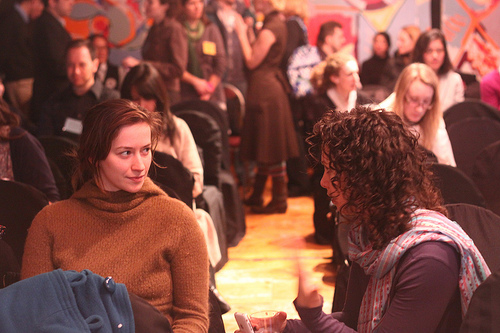
In other words, from the beginning SMartCAMP was about people, people who post, blog, tag, add, and tweet, but above all, people who meet and link up through quirky, often unpredictable, circumstances to pursue a shared idea. According to the speakers in SMartCAMP’s program, this is the kind of easy serendipity that gives social networks their authenticity and value. While these qualities can’t quite be summoned, they can be encouraged and directed. For artists and administrators, the question is how to sustain these connections to build audience and patron loyalty. Whether you like the idea of artists taking on their own distribution, or whether you find it somehow uncomfortable, social media is influential and growing. As more than one person pointed out, social networking has surpassed pornography as the number one activity on the web.
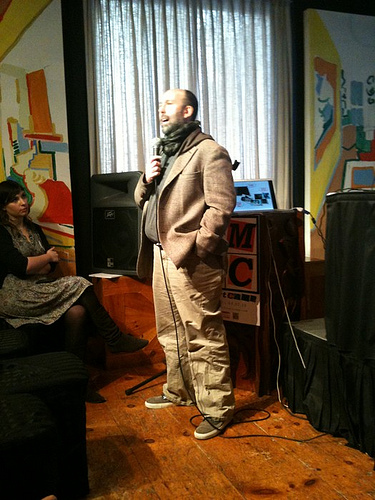
Mark Schiller’s keynote opened the Saturday session. Well-known in the New York arts community, Schiller is the founder of The Wooster Collective, a public arts site that documents street art from around the world. Like many successful online projects, Wooster Collective began accidentally. Out walking his dog in his downtown neighborhood, Schiller began photographing street art, which he then posted online, forwarding the link to friends, and asking for their reactions. Soon his web page was managing hundreds of photos, receiving thousands of hits per day, and turning artists into online celebrities. Two Wooster Collective discoveries that have gone viral are Josh Harris, famous for his subway grate inflatable dog, and Jan Vorman, an artist who uses Lego bricks to patch crumbling city walls. Today, after eight years of posts, The Wooster Collective is the online authority on street art. Schiller receives a self-sustaining five hundred emails a day from artists who have done work, or have seen work, and would like to contribute. Wooster Collective also has a YouTube channel and a Twitter feed.
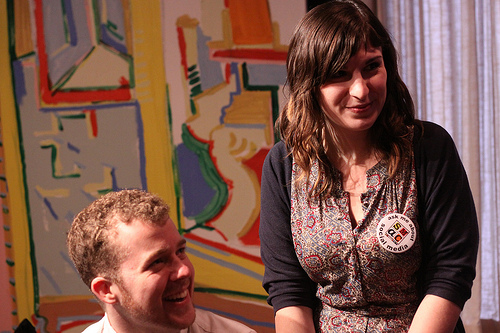
In many ways Wooster’s success seems unpredictable and non-reproducible, a fad, some kind of dumb luck. Yet, in retrospect, Schiller is able to point out specific qualities that made the site popular. First, there was page rank. Since no one was writing about street art in any other media, Wooster Collective’s art tags quickly went to the top of the search engine indexes. This kind of self-reinforcing rank allowed Schiller’s blog to get more traffic and, consequently, to pull more traffic from user searches. Second, ninety percent of the content on The Wooster Collective was original, making Schiller’s blog a feeder for other arts pages, increasing its incoming links and, again, boosting its reputation and its rank. Third, there are no ads at all on the Wooster site per se, mostly, Schiller says, because ads would be distracting both for him and his followers. Free from ads, Wooster Collective has no traffic stats to maintain, meaning Schiller is free to indulge himself in what his readers like best, Wooster’s own weird personality. On most days the site wavers slightly between media outlet and community bulletin board.
However, as important as his community may be, Schiller explained that Wooster readers are actually heavily restricted. The community is largely passive. Readers can email, but they can’t comment, upload, or see who else is online. Although some of site is user generated content, sites built on user content are notoriously second-hand and boring, so reader contributions are very heavily curated. The result is a blog that remains personal and interesting to all. Schiller also says audience building on the Wooster site has always been secondary to his main mission of sharing a passion for street art. According to Schiller, that passion is what works online and the effort to express it means a willingness to try anything. After all, Schiller reasons, “if you don’t like it, you can always stop. If a projects takes more than ten minutes to finish, stop. If it’s not fun, stop. If it’s not inspiring, stop.” Finding podcasts “not fun”, The Wooster Collective recently quit making them. They quit making mobile apps too. Schiller suspects that it is the resulting cheerfulness, lack of strain, exuberance, or even silliness, that connects an audience to a blog, a pursuit, or to an artist.
For Etsy, an online site where artists sell their work directly, community came first, web presence second. Anda Corrie, manager of Etsy’s Twitter feed, explains that Etsy was started at a time when the DIY arts culture was strong and growing, but artists still had few outlets for what they made. Etsy was one of the first sites to give them that outlet and, for a small commission, the site benefited greatly from its fortunate timing. Still, there is a balance between artist and audience that sustains Etsy and makes it work. In addition to responding to community needs, Corrie notes that the governance of sites like Etsy should be as transparent as possible. She reminds media managers rushing to reach out to remember to build a way for their readers and followers to reach in. Etsy uses a community council model. Councils change monthly, giving suggestions for improvements to the site and its forums. This is a time consuming model to attempt but, like Schiller, Corrie feels media planners who go through the motions without really getting involved are unlikely to succeed.
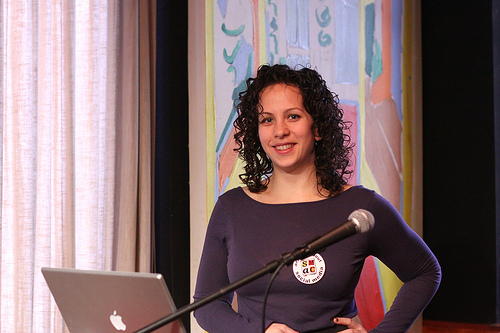
Michelle Shildkret, who represented Cake Group would say that you can’t fake what you are online, just as you can’t hire someone to “make you go viral”. She advises artists to slow down, figure out who to reach out to, where they are online, what they do when they’re online, and how someone might get their attention. When you can answer those questions, you’re ready to approach a social media plan. Shildkret also believes that a small, engaged community may be better than thousands and thousands of disinterested friends. Choose to introduce yourself and your work to places you like, make a difference there first, then advance slowly. John Birdsong of Panman Productions says artists often need to open up in exchange for popular attention. Birdsong endorses the strategy of a behind the scenes look at a studio or art process by posting “making of” videos to UStream or YouTube. These sentiments were echoed by others. Natasha Wescoat, a writer for EBSQ, the self-represented artist’s blog, became obsessed with eBay auctions as a community college student. Wescoat noticed that what honestly attracted her to an artist’s online profile was not necessarily the work. As an audience member, she also wanted personality, a connection, and some sense that there was a real person behind the presentation. Where Schiller describes a community that grows out of a shared passion, Wescoat sees community as a group centered on personality. Like Schiller, she encourages artists to try all ideas, continue with what feels right, and allow a web identity to evolve over time. For example, Wescoat describes her own online identity as an arc with three phases: experimentation, where she tried different approaches to making and selling work; narcissism, where she spent a good deal of time showing how the work was made; and establishment, where the size of her online audience is large enough to attract commissions from corporations and collectors.
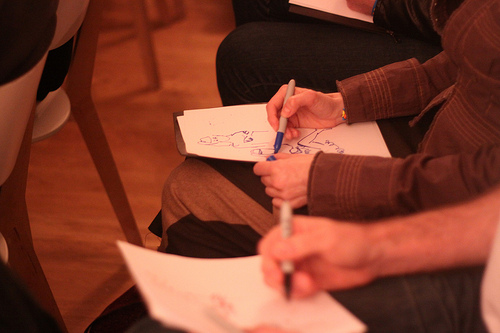
Sharpie sketch queen and self-described “art school drop out” Molly Crabapple credits her web personality as fundamental to a full-time practice that draws commissions from the New York Times and Marvel Comics. Founder of Dr. Sketchy’s Anti-Art School, Crabapple introduced her online persona by compulsively posting to LiveJournal. Today, her favorite platform is Twitter and her media tool of choice is the one hundred and forty character tweet. Crabapple likes Twitter’s immediacy and tweets to get illustration suggestions from her followers, to find emergency crash spaces, and to “manifest” anything. She advises underrepresented artists to do whatever it takes to build a following online: friend friends of friends, promise to perform humiliating stunts for your followers, tweet about everything you do, reward your one hundredth or one thousandth follower with some kind of gift, a sketch or drawing, for instance. When the earthquake struck Haiti, Crabapple tweeted for drawing suggestions, drew those suggestions live online, then auctioned those drawings off in a benefit for Doctors without Borders. Yancey Strickler who co-founded the microfunding platform Kickstarter goes a step further. Kickstarter allows artists to post projects online and request small funding pledges from their followers. These pledges remain virtual until the project pledges reach full funding. At that point, sponsors pay up, the project is funded, and Kickstarter receives five percent of the amount raised. But pledge money is not always a reflection of your project pitch, Strickler points out, saying that what succeeds online is a good narrative and a connection with the audience that feels authentic. According to Strickler, people on Kickstarter are only somewhat concerned with the quality or originality of the work in front of them. More often, their decision to contribute to an artist’s goal proceeds along the lines of questions like “Do I like this person?” or “Could I be friends with this person?”.
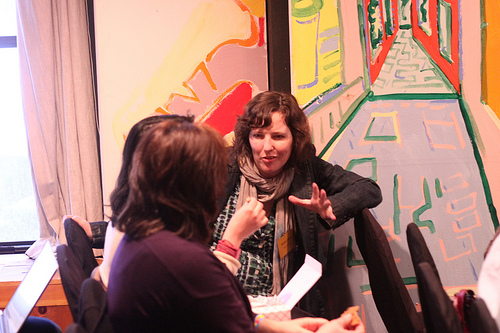
If all this sounds a bit disingenuous or self-serving, remember that social media connects artists and audiences directly and that this connection now has its own considerations. There are some dangers in its manipulation, but the benefits need to be recognized. Adam Smith of Dance Theater Workshop’s and the New York branch of the Neo-Futurists uses blogging and community choreography as forms of outreach. While there are no hard numbers for increases in audience through the blog, DTW’s paid audience has gone from sixty to eighty percent of the house. Working on getting the tools right isn’t necessarily a negative and will probably take some work. Dancer Lisa Niedermeyer says: “You can’t just be clever, you have to be smart, and that none of this has been around long enough for any of us to be wise (yet). That any one experiment can be clever, and with speed and easy access can go live, but it takes being smart for it to be sustainable.”
Niedermeyer works on Virtual Pillow, the tech initiative of Jacob’s Pillow Dance. In some ways Niedermeyer considers the company’s online presence a fourth stage: “A global, interactive space serving a virtual community that might not ever be able to physically visit us in the Berkshires of Massachusetts, but highly value our archives, performances, professional school, creative development residency programs, etc.”
A second part of Virtual Pillow’s mission is to bring the work of the company, including its history, to a wider audience via social media, streaming sites, or any other online platform. Niedermeyer attended SMartCAMP for the chance to hear other institutions and artists discuss what worked and what did not. She says the conference gave her more perspective on the strategies available to Virtual Pillow: “I felt that the conference speakers and participants were really talking about the big picture, big ideas. Gravity Rail, for example, with their passion to explode open and transform eCommerce models for artists.”
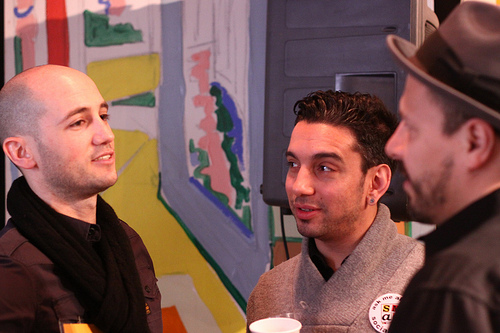
Performers are not alone in the need to link up. According to Nancy Proctor, the museum is a distributed network whether curators accept that idea or not, and agile use of social media is essential to responsive curation. Proctor heads New Media at the Smithsonian American Art Museum, a museum which now gets more visitors online than in person. Are those online visitors any less real? Should their visit be any less satisfying? Should their use of the museum be any less respected? Noting that desktop activities are increasingly moving to the mobile web, Proctor urges curators to meet visitors where they are through sms, tweets, and mobile applications.
Examples of another kind of user centered curation came from Titus Bicknell, founder of pinkink, who believes audiences and their questions now lie at the center of any program strategy. Bicknell’s examples of user centered curation included a podcast that asks visitors to enter a space, look at the art, and record any questions they might have. In this curation model, socially aware programmers ask audiences what they would like to know, rather than telling audiences what it is believed they should know. Allegra Burnette, Creative Director of Digital Media at MoMA, pointed out excellence in web presence like the Indianapolis Museum of Art’s fine arts blog ArtBabble, but added that MoMA uses Twitter feeds specifically to talk about current exhibitions at home and elsewhere. MOMA also offers podcasts on iTunesU where, Burnette says, downloads have increased about ten times this year. More and more, curation extends beyond the exhibit to the conversation about that exhibition, a conversation that defines your institution on the social web through bookmarking, favoriting, collecting, sharing, recommending, and searching. Like the Wooster Collective’s Schiller, Burnett advises media managers to avoid blatant marketing and to discuss events of interest to readers whether those events are part of a home exhibition or are occurring elsewhere.

Even in competition with Arts Week, SMartCAMP sold out. In addition to a long list of good speakers, there was a great deal of conversation and connection going on across the seats, in the halls, throughout the lobby and meeting rooms, and at the bar. Absolutely no one was asked to turn off a cell phone. Executive producer Matt Semler says: “We trended on Twitter both days and ended up with 120,000 individual views on UStream. The audience was very nicely mixed. While we don’t have any specific data on demographics my impression was that the room was evenly split between art executives and artists.”
In April, Semler and Roger Smith Arts will present a cello performance by Peter Gregson from within a Morgan O’Hara installation inside The LAB gallery space in New York. As Gregson plays, O’Hara will perform one of her “Live Transmissions” of Peter’s performance. The event will be streamed live over UStream and, as with all LAB performances, will be viewable from the street as well.
Digital Pioneers
Victoria And Albert Museum
7 December 2009 – 25 April 2010
(Illustration – Herbert W. Franke, Squares (Quadrate), screenprint, 1969/70)
Digital Pioneers is a deceptively modest exhibition hidden away in two rooms upstairs at the Victoria and Albert Museum. It contains some of the earliest examples of art produced using electronic devices and computing machinery along with some creative later work.
The bulk of the art in the show was produced between the 1950s and the 1970s. This means that it was produced or recorded as photographs from cathode ray tubes or as print-outs from teletypes and pen plotters. Some of this work will be familiar to students of the history of art computing through reproductions but as with most art reproductions do not tell the whole story.
Seeing the actual work itself is as important for art made using the paraphernalia of early digital computing as it is for art made with linseed oil and cotton duck. What Digital Pioneers drives home is just how deeply and intentionally involved early computer artists were in manipulating the aesthetically limited but socially and ideologically key technology of computing machinery. This leaves both social art historians and code aesthetes with some explaining to do, or at least some catching up.
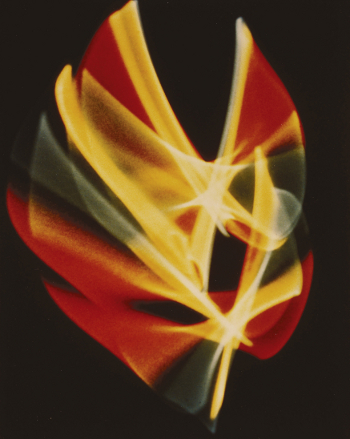
The show starts in the 1950s with the algorithmic and electronic but non-digital and non-computational photographs of oscilloscope patterns by Ben Laposky and screen-prints of photographs by Herbert W. Franke. Most of the works included in the show are prints of one kind or another, and these are no exception. They record the movement of a beam of light on a cathode ray tube as other prints in the show record the movement of a plotter pen or a laser in a laser printer.
If Constructivism was socially realistic for revolutionary Russia then these works are socially realistic against the backdrop of NATO’s military-industrial-educational complex. They turn the technology of that culture back on itself, using it not to produce weapons or market products but to produce aesthetics. This reclaims a space for perception and contemplation that is not simply militarily or economically exploited. The obsessively quantitative managerial culture of spreadsheets and inventories yields uncomfortably to the qualitative culture of aesthetics, productively so. These strategies continue through the show. Technology is pushed beyond its intended uses to address cultural tasks.
Many of the prints in the show have a similar number of stages of production to Franke’s process of screen, then photograph, then silkscreen prints. His later plotter-drawn work is also screen printed, as are Klee-inspired generative images by Frieder Nake, and Charles Csuri’s random montage of flies. I don’t know what to make of this. It feels like something should have been lost in the move from an original to a print but plotter drawings aren’t particularly originals, being already representations of data structures in the computer’s memory.
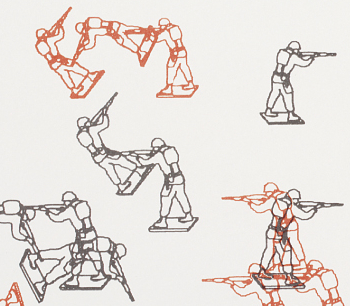
Csuri’s lithograph of randomly placed vector outlines of toy soldiers was produced in 1967 during the Vietnam War, a war that ran as long as it did in no small part due to game theory and computer simulation. There are two armies, one plotted in red and one plotted in black. They meet and presumably battle inevitably but only by chance. There’s more of the outside world in art computing than is often assumed.
William Fetter’s wonderful three dimensional vector images of human figures produced for the aircraft manufacturer Boeing, a lithograph from the Cybernetic Serendipity show of 1968, also deal with the human figure within the military-industrial complex. We should not be confused about the status of such images as art by the use and funding of computer graphics by corporations any more than we should be confused about the status of painting as art by the use and funding of oil painting by the Catholic church.
Ken Knowlton’s cheeky nudes and other typographic images of the 1960s and 1980s are an effective escape or release from the constraints of corporate information culture. I’d seen them many times in reproduction but again they are much richer visually as prints.
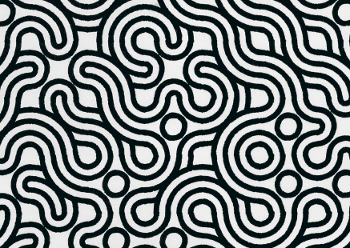
More detailed systems-based patterns emerge in the 1970s in the work of artists such as Manfred Mohr, Paul Brown, and Vera Molnar. This era that epitomises the approach of rule based serendipity so beloved of later Generative artists. These images are pleasurable to look at but also contain visual or psychological complexity. They also continues to push the performance of computer systems outside of their intended use cases.
By the late 1980s the technical achievements of computerised mass media were exceeding those of art computing. Pen plotters, where they were still used, were no rival to laser printers. Rendered images had to compete with the earliest rumblings of Pixar and Adobe. The increasing availability of digitally designed fashion and entertainment meant that far from being the exception, digital elements in the lived visual environment were becoming the rule.
The reactions to this that art computing in general have made are the subject of the Decode show that is also running at the V&A. Digital Pioneers instead follows the printmaking thread of art computing into the present day where artists such as Roman Verostko, Mark Wilson and Paul Brown have continued with the systems art all-overness of print-based art computing.
To continue in this way marks such work out as something different from the all-pervasive presence of digital imagery in the visual environment. The work has to look different from graphic design and new media rather than from CAD plots or teletype reports, and it does. These works remind us of the history and of the wiring under the board of digital culture. They successfully resist any attempt to reduce them to digital mass media images comparable to the output of the design software that they exist in the same era as.
This switch away from early adoption is necessary to maintain a figure/ground relationship (or a critical distance, or a constructive difference) between the general level of technology in society and the level of technology in art computing. It is not the only solution to this problem, as the Decode show demonstrates, but it is not a retreat.
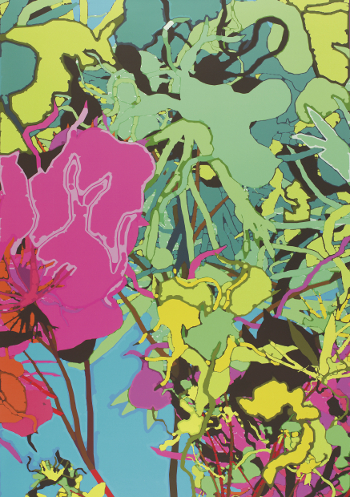
As a long time fan of Harold Cohen, I found the show’s inclusion of computer generated works from his very earliest 1960s felt-tip-on-teletype-print experiments with generating figure and ground relationships computationally to a recent large-scale full-colour inkjet abstract was a real treat. Plotter drawings of abstract shapes from the 1970s and of human and plant forms from the 1980s show the progress that Cohen made in using computers to rigorously explore how art and images are created and function. Being able to study this work close-up reveals details such as debugging information in the teletype prints and the operation of the collision-detection algorithm in the 1980s images. And it provides the pleasure of seeing detailed, well-composed drawings.
This is a recurring experience in Digital Pioneers. Despite the uniformly dismissive attitude of both popular and academic criticism towards art computing the fact is that when you actually see the work in the flesh it rewards sustained attention. Not as historical or technical curiosities, but as images with cultural and aesthetic content and resonance. To ignore this and to continue to claim that this art is less than the sum of its parts would ironically be to fall prey to a particularly extreme attitude of technological determinism.
The show also contains displays of ephemera including magazines and books such as back issues of the Computer Arts Society’s “PAGE” and William Gibson’s supposedly self-erasing story on a floppy disk “Agrippa”. I’d not seen an actual copy of “Agrippa” before. PAGE back-issues are available online, but their presence here flags an important point.
The revived Computer Arts Society has been key in promoting and deepening understanding of the history of art computing in the UK. The Digital Pioneers show and its excellent accompanying book are a good example of how CAS’s project has spread out into more traditional cultural institutions, and many of the images and exhibits in the show come from the archives that CAS has donated to the V&A.
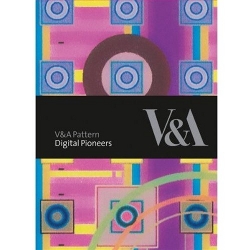
The “Digital Pioneers” book (by Honor Beddard and Douglas Dodds, V & A Publishing, 2009) serves as a catalogue for the show . It contains an informative introductory essay and printed images of many of the works on display as well as a CD-ROM with 200dpi scans of them. These scans are high-resolution enough to be able to examine the images in some detail, although they are no substitute for seeing the images in the gallery. A slightly excessive copyright licencing notice is the only indication that the book has in fact been produced as one in a series of pattern books from the V&A. It’s a must-have if you enjoy the show or have any interest in early art computing.
Digital Pioneers is an opportunity to really look at the work of early computer artists and to evaluate that work directly rather than through the medium of poor reproductions or through the fog of received critical opinion. As a slice of artistic history that just so happens to have been produced on computer it contains much to reward both the eye and the mind.
Update: Two recently published books provide more extensive background to the period covered by the show, making the history of this fascinating era available to current practitioners –
White Heat, Cold Logic: British Computer Art 1960-1980‘ edited by Charlie Gere et al covers the history of British computer art and the Computer Arts Society.
A Computer in the Art Room by Catherine Mason describes the relationship between British art schools and computing (which is how I became interested in this area in the first place).
The text of this review is licenced under the Creative Commons BY-SA 3.0 Licence.
A collaborative review by Marcello Lussana and Gaia Novati
The article features artwork, projects and conference highlights from individuals and groups/organisations such as Honor Harger, Gebhard Sengmuller, Franz Buchinger, Ryoji Ikeda, Julian Oliver, Damian Stewart, Clara Boj, Diego Diaz, Ken Rinaldo, Michell Teran, Aaron Koblin, Daniel Massey, F.A.T, Warren Neidich, Kahaimzon Michel, Bruce Sterling, I-Wei Li, Steve Lambert Matteo Pasquinelli and more…

This year’s Transmediale.10 Festival explores the theme ‘future’ through connections between arts and technology. A part of the introduction read “Futurity is a concept that examines what the ‘future’ as a conditional and creative enterprise can be. At its heart lays the intricate need to counter political and economic turmoil with visionary futures. […] what roles internet evolution, global network practice, open source methodologies, sustainable design and mobile technology play in forming new cultural, ideological and political templates.”
2010 is a year that has often represented the future in Science Fiction literature, such as Arthur C. Clarke’s 2010: Odyssey Two, and now here we are. A good time to compare how we percieved the future, the past, and assess what is really happening, what we lost and what we have gained, and ‘perhaps’ find better ways to proceed. Art can offer different perspectives, ways of seeing and understanding, revealing our present states of being, sharing alternatives or even new meanings for our futures. This festival allows those visiting and taking part, an opportunity to explore, negotiate possible avenues in understanding together, what all this means.
Most of the Transmediale.10 events and art presentations were hosted at Haus der Kulturen der Welt, the same venue for past editions. The main exhibition Future Obscura, was curated by Honor Harger. A big dark room, a labrynth of exhibits divided up with high black curtains. Presenting different artworks enhanced by their own resonances of light. The concept was to use the actual light-sources from each of the artworks, as a kind of curatorial, installation metaphor. Immediately effecting the visitor’s experience through its overall ambiance, built around the theme or vision of future.
We make our journeys out there in the low light of the future, and return to the bourgeois day and its mass delusion of safety, to report on what we’ve seen. What are any of these ‘utopian dreams’ of ours but defective forms of time-travel? Thomas Pynchon, Against the Day (2006).
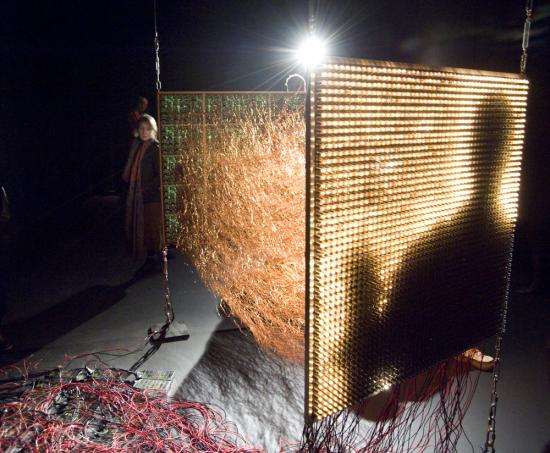
The work Parallel Image by Gebhard Sengmuller, in collaboration with Franz Buchinger, supported by Fels-Multiprint may of inspired the whole concept. An electronic camera obscura and media-archaeological, interactive sculpture. An apparatus for presenting different possible fictions, futures. “Unlike conventional electronic image transmission procedures, “A Parallel Image” is technologically completely transparent, conveying to the viewer a correspondence between real world and transmission that can be sensually experienced.” It presents the fiction that the technology of transmitting moving images was not discovered or invented at all – so no electronic pixels, just a camera and a monitor connected by 2,500 cables in order to track the movement of a body or an object.
Whilst weaving through the dark, curtain bound maze, discovering the separated presentations of Future Obscura, or what we can consider playfully here, as the ‘futurity tunnel’. We come across the video-audio installation data.tron, part of the datamatics project by Ryoji Ikeda. A huge screen (about 15 ft high & 40 foot wide) stands in front of visitors on a flat wall-surface. Various projected sets of data – consisiting of databases, computer consoles and white noise move and unfold before your very eyes. Music plays along with the images issuing forth deep hypnotic sensations. Each single pixel is strictly calculated by a mathematical principle and composed from a combination of pure mathematics. Ikeda reuses and deconstructs the data, building it up into a massive art-work, which also becomes an immersive experience. The same concept was used in his live performance at Transmediale.10 ‘Test Pattern’.
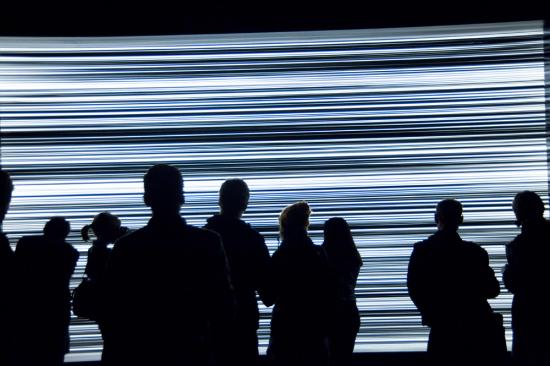
The Artvertiser, a work by Julian Oliver, Damian Stewart, Clara Boj and Diego Diaz, is a tool to swap advertisement with art in public spaces. With a self-made binocular device and dedicated software, you can experience a new metropolitan landscape, replacing the omnipresent adverts which plague our urban environments with art or images of your choice. The swapped, proposed images are often a play on the words of the original advertisement. Whichever image one substituted, the central message of the Artvertiser remains the same; our public city landscapes are bulging with publicity, we want to take that space back and personalize it – quite the same concept of graffiti, but dealing with the reproduction and re-representation of our public spaces. The software running on the device is an open source project and it will soon be available for all to download and use with Smartphones and Standard Camera phones. The Artvertiser points out a thoughtful and critical view point of our present, proposing an alternative future directly linked to our everyday lives. Ironically, this is a theme that is unfortunately scarce or missing in most of the selected Transmediale.10 works.
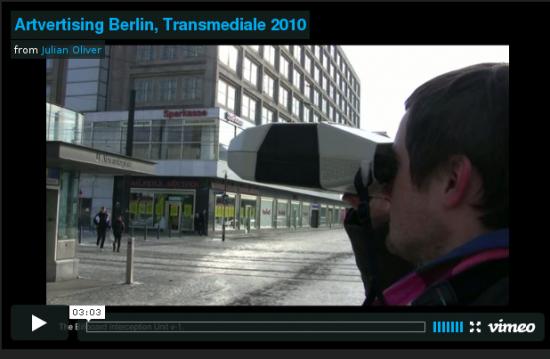
The work Paparazzi Botsby Ken Rinaldo, consisting of a series of autonomous robots. Each of them upright, the height of the average human. Packed with lens-based hardware, such as “cameras, sensors and robotic actuators on a custom-built rolling platform, they move at the speed of a walking human, avoiding walls and obstacles while using infrared sensors to move toward humans.” Capturing images of the visitors as though they were celebrities, flashes go off, then the images are projected up onto the surrounding walls. A popular installation reflecting on the abuse of reproduction and exhibition: some of the images were also uploaded and then distributed through social networking sites – a mass mediatic celebration of the visitors as well as the celebration of the bots.
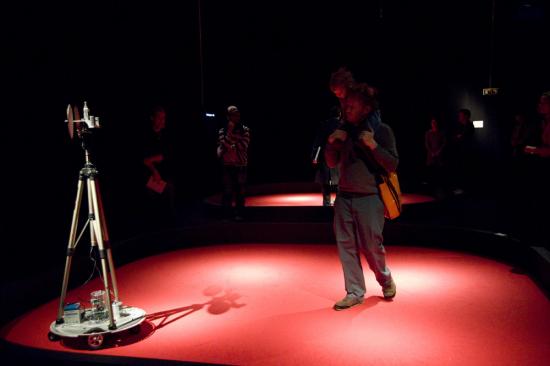
The selection of Transmediale.10 seems to award reproduction of content rather than consciousness of a different form of creativity. Also, the main prize is unexpectedly given to a woman, Michell Teran, with the project Buscando al Sr. Goodbar: a real tour through Murcia, a Spanish town, taking place at the same time on Google Earth and YouTube, an interaction between reality and social media. The work was presented at Transmediale.10 as a video remix of the original work. “The tour audience was introduced to everyday performances and actions happening in the city that often go unnoticed. Somebody solves a Rubik’s Cube in under 2 minutes, a young man plays a piano, a group of friends drunkenly sing together, a 14 year old boy headbangs in his bedroom, somebody is choked, a man teaches himself Arabic and two people fall in love. At certain points the audience left the bus and met some of the video authors who presented them with re-enactments of their performances.”
In the same way the second prize was awarded to the project Bicycle Built For Two Thousand by Aaron Koblin and Daniel Massey. A web-based, software able to record people repeating what they heard, then they used these voices to make a reconstructed version of the song Daisy Bell – the first song that implemented musical speech synthesis in the 1962.
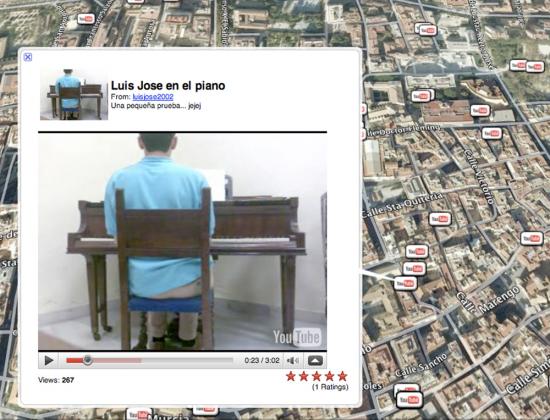
Speaking about the difference between re-production and creation, it is interesting to notice that the group F.A.T were present at the awards. Using intentionally, and excessively open source and pop culture as way of expressing their creative actvities, claiming and distributing activist propoganda-like projects, on networked territories and facilities (facebook/google ndr.) in order to stress out the holes of content present in the Web2.0 culture. For Transmediale.10, they presented a series of projects dedicated to the topic of the week: FUCK GOOGLE. In addition to free software, browser addons, live streams, communiques and on-site workshops, they also built a fake Google Street View car and toured it in the city of Berlin.
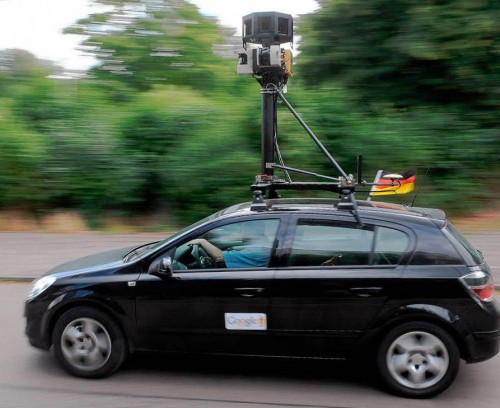
A more singular approach, which revealed different or other connections of a network is shown in Neuropower, by the biologist and artist Warren Neidich who won The Vilem Flusser Theory Award 2010: he researched new ways to manipulate the process of ongoing cerebral reconstruction. Exploring the potential of Neuroaesthetics, formulated in the mid-1990s “as a paradigm capable of describing the complex conditions of the ‘now’-a moment in which global technological networks and novel potentialities for subjectivity are coming into greater focus and correlation to each other. As knowledge becomes ever more commodified, and labor increasingly immaterial, our notions of art, work, and politics…”
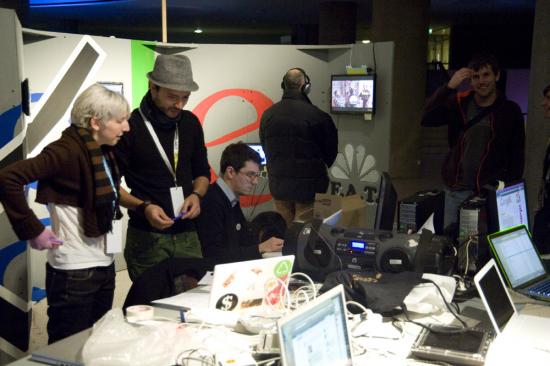
The gap between what could be the future or what we are imagining through the mass-media industry and the challenge that artists and creative thinkers are asked to face, is not really elaborated. A good example is the conference Phuturama: a space dedicated to the possible alternatives of an ‘imaginary’ for the future. One of the guests was Kahaimzon Michel: his description of the new version of Far Cray was mostly focused on the technical improvement of the game and no word at all was spent on the idea, the concept itself: the umpteenth war-games, colonialist and male-centered. The celebration of technology itself was the splitting point of this Festival, as it was somehow already announced at the opening day by Dr. Franke. His main contribution seemded to be about the importance of ‘Avatar’ the movie, for its big technological improvements.
Going back to the events, one of the most awaited speeches was Bruce Sterling’s keynote speech “Atemporality – A cultural speed control” about time and its relation to ‘future’. The main introduction text for Atemporality – A cultural speed control read “The speed of our society is constantly increasing in terms of processes, logistics and media, causing the present to ‘shrink’. We are experiencing the dissolution of meaningful frameworks in a similar way as Henry DeTamble: in politics, the intervals of planning and acting are reduced to the duration of a legislative period and in post-industrial economics volatile unpredictability has come to replace regular traits of growth and stability. Progress as the paradigm of modernity has been replaced by the continuous modulation of events. If progress is to go beyond the banal indulgences that give rise to a never-ending array of car shell designs then we need to analyse our present time with regard to its aesthetics and its media. The structure of the future has changed, and with it our sense of time. Are we running out of a future as a resource for growth, progress and stability? Has our cultural cruise control become defective?”
Reflecting on the proposed theme, Sterling presented Atemporality as he viewed it, an approach in understanding and recontextualizing history, “an effort in humanities” to embrace reality, the now.
“Step one – write problem in a search engine, see if somebody else has solved it already.
Step two – write problem in my blog; study the commentory cross-linked to other guys.
Step three – write my problem in Twitter in a hundred and forty characters. See if I can get it that small. See if it gets retweeted.
Step four – open source the problem; supply some instructables to get me as far as I’ve been able to get, see if the community takes it any further.
Step five – start a Ning social network about my problem, name the network after my problem, see if anybody accumulates around my problem.
Step six – make a video of my problem. Youtube my video, see if it spreads virally, see if any media convergence accumulates around my problem.
Step seven – create a design fiction that pretends that my problem has already been solved. Create some gadget or application or product that has some relevance to my problem and see if anybody builds it.
Step eight – exacerbate or intensify my problem with a work of interventionist tactical media. And step nine – find some kind of pretty illustrations from the Flickr ‘Looking into the Past’ photo pool.” Sterling.
The philosophy of history studies, an objective point of view, a map that does not always reflect the real. Atemporality instead, has to be a “calm pragmatic skepticism about the historical narrative” like telling stories of people who were not the winners, report history that has no literacy or playing fiction into reality, being a “personal public testimony of a future that doesn’t exist”.
“Atemporality is a philosophy of history with a built-in expiration date. It has a built in expiration date. It’s not going to last forever. It’s not a perfect explanation, it’s a contingent explanation for contingent times.
Futurity was expected, futurity is here now, there goes futurity into the past, so long futurity, thank you for an exciting, fulfilling and worthwhile time.” Sterling.
The Atemporal approach asks us to cool things down, challenge the need and desire for a constant, linear future. Proposing not to rush ever onwards, remembering what we have now, reclaiming and rediscovering the qualities we possess rather than feverishly running forward all of the time. You can read Bruce Sterling’s whole speech here – Atemporality for the Creative Artist
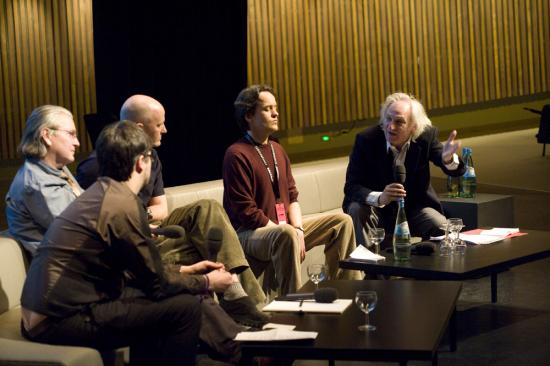
A subject which played a central role for much of the discussions held, was related to the economy and how it addresses the creative work (a third of the speeches were about this topic). The financial crisis had also influenced much of the artistic agenda. Unfortunately all this talking about commerce was often presented without critical reasoning, and so we had a lot of showing off and gesturing about how amazing certain new technologies were. Which gave off a more bland sense of enthusiastism, a technologically determined, already accepted future, without the necessary awareness of the overall social contexts of what it all really means. Yet there were some projects that tried to propose a different view on this theme. The performance Values, by I-Wei Li, pretended to calculate, with the help of a computer, the value (artistic-value) of the participant, based around questions on art and art practice. The Laboratoire Deberlinisation uses an uncommon way to discuss about immigration and value in our globalized world, with the provocative use of an African value, the Afro, an international insurance card and passport.
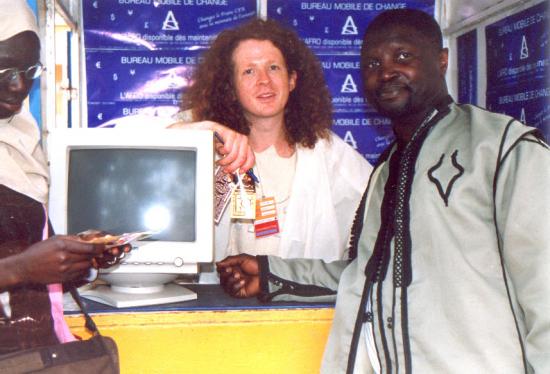
A deep critical, discussion of the current socio-economical situation produced by the international financial crisis, was held in the main auditorium, Liquid democracies. Steve Lambert presented his works and talked about direct politics, re-using our culture and how to subvert it. In his opinion, utopia has to be used as a direction and not as a destination, living moments of freedom: an alternative approach for direct, political change, using small actions and persistence, participating tactically through our cultures. Matteo Pasquinelli later focuses attention on the whole of net society and the digital matrix. He wondered who has the strongest power, who detains the monopolies and which place is dedicated to the workers and specifically to the cognitive (creative) workers? Pasquinelli used the concept of a “new feudalism” to define contemporary societies. The multitude is not fluid but embroils in a participatory process that traps it in-between the oligarchy of the big companies. Democracy in this sense has ended and gives the go-ahead to a post feudalistic society. The end of this construction is an open question: is there any subject able to break the power of these big monopolies?
Parallel to Transmediale festival is Club Transmediale Festival CTM a music and visual arts event held every year in Berlin. The festival started as the musical side of Transmediale and then added more and more interests involving the arts. Through the years it has become more popular and expanded, not just with music during the night, but also with their own exhibitions, talks and lectures during the day. This year the event was even longer than Transmediale itself, starting from January 28th and ending February 7th 2010, with the subject “OVERLAP – Sound & Other Media” giving a lot of attention to the relationship between music and videogames.
A missing element worthy of attention at Transmediale.10 this year, was its audience. Even though the amount of visitors were three times more than last year. The time for questions and discussion with the public was often too short, or ineffective. A contemporary approach in acknowledging the audience would be to understand there is not a clean divide anymore. And even though the old protocols still count in some cases, its representation at the festival was not necessarily a true reflection of the nature of networked, contemporary art and its culture. A hidden and dynamic audience which could have offered their own ‘valid’ interpretations around the subject was lost. Yet, on the whole the festival was extremely interesting in many ways, and had some excellent works and discussions well worth experiencing.
Arriving at the homepage of Ten Thousand Cents, an Internet artwork by Aaron Koblin and Takashi Kawashima, a mottled image of a one hundred dollar bill slowly fades into view. Ben Franklin looks out sedately. Mousing over the large image, the cursor is replaced with a small red rectangle. And here lays the beauty of the project; with the click of each rectangle, a zoomed in portion of the one hundred dollar bill is revealed. On the left side is a high-resolution photograph of that tiny portion of the bill. On the right side, a real-time moving image plays, revealing how the image was drawn by a human hand in a drawing program created by Koblin and Kawashima. There are, in fact, 10,000 such rectangles and each was created by a Turker through Amazon’s Mechanical Turk marketplace.
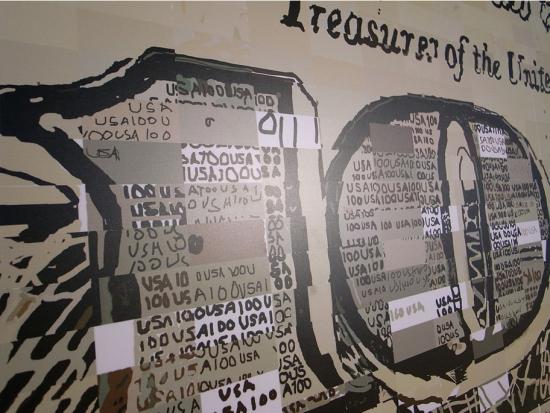
Over the course of five months (from November 2007 to March 2008) Koblin and Kawashima posted tasks, known as HITs, Human Intelligence Tasks, on Amazon’s Mechanical Turk site. Having broken down an image of a one hundred dollar bill into 10,000 sections, Turkers were tasked with redrawing their assigned section. Each Turker was paid $.01 for the task, making the total payment of drawing a one hundred dollar bill one hundred dollars. (Prints of the project can also be bought for one hundred dollars. All proceeds are donated to the One Laptop per Child (OLPC) project) Each Turker worked anonymously, unaware that what they were drawing was a section of a bill or that their work would eventually be combined with other Turkers’ work to create an art project. The variability is endless. Some Turkers methodically draw in the lines and painstakingly shade in boxes. Some quickly slash the paint tool across the page; one imagines they felt they had better things to do with their time. Some are cheeky, using the space for digital graffiti or messages like “I love U.” Most copy the image exactly. Yet, with the differing movements and tempos, every one suggests a different story and different person behind the tool. I suggest you take a few minutes and watch the unfolding scenes. They are oddly, satisfyingly banal and beautiful.
The project and its presentation on the website are undoubtedly elegant. Yet, the conceptual work behind the piece is a bit murkier. The project description states, “The project explores the circumstances we live in, a new and uncharted combination of digital labor markets, ‘crowdsourcing,’ ‘virtual economies,’ and digital reproduction.” Big and important themes. What are the implications of crowd-sourcing for creative work? For any kind of paid work? Where is the distinction between work and play? Creativity and re-presentation? In this deeply networked age, what are the evolving relations between individual and collective action?
The Mechanical Turk, made by Wolfgang de Kempelen in 1769, caused a sensation in 18th and 19th century Europe, first for its existence as a seemingly intelligent chess playing automaton – one who could beat Ben Franklin and even Napoleon in chess – and subsequently, for being an infamous hoax. Inside of the automaton was in fact a man, a skilled chess player. The Mechanical Turk was no thinking machine. It was an elaborate performance of concealment and human skill.

In 2005, in an ironic (and some might say distasteful) turn of events, Jeff Bezos of Amazon named a new business venture, Amazon Mechanical Turk. The idea was to make a digital marketplace that capitalized on the unique intelligence of human agents. Broken down into microtasks, known as HITs, Mechanical Turk provides a means to accomplish those tasks that humans can do quickly but which would take computers much longer to do, for instance, tagging images, taking surveys or transcribing audio recordings. This Mechanical Turk is also a performance of human skill, one that revels in its basis in human intelligence – Bezos calls it “artificial artificial intelligence” – but one that also operates within a mode of concealment and indeed, alienation.
As Katharine Mieszkowski of Salon wrote about Mechanical Turk in 2006, “There is something a little disturbing about a billionaire like Bezos dreaming up new ways to get ordinary folk to do work for him for pennies.” Critics of Mechanical Turk abound, and their objections point to the insidious labor relations that Mechanical Turk enforces, implying that Mechanical Turk approaches a virtual sweatshop. The system was designed for employers, not employees. The earnings of Turkers fall within a gray area of digital labor, officially being classified as contractor work, subject to high self-employment taxes and no option for benefits. Although a rating system protects employers, in so far as employers can choose to reject a work offer from a Turker or refuse to pay a Turker if the work is completed unsatisfactorily, no such system protects Turkers. As advocates of a Turker Bill of Rights have pointed out, there is no effective outlet within Mechanical Turk for Turkers to voice grievances against employers. What does exist is a vibrant community forum, Turker Nation, where Turkers advise each other on known scammers.
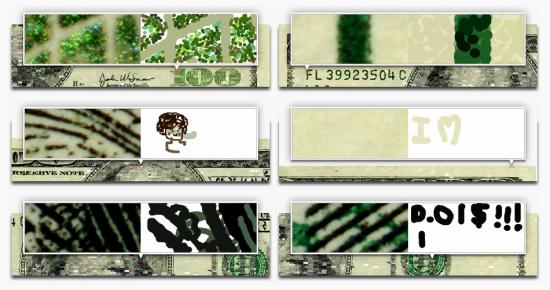
Moreover, although anecdotally Mechanical Turk is understood as more game or past-time than employment, a recent study out of University of California, Irvine’s Informatics Department points out that almost a third of Turkers rely on Mechanical Turk as a source of income. Another study found that nearly half of Turkers report their motivation for working as income related. For this population of Turkers, it is troubling to consider the possibilities of exploitation and unfair labor practices.
In this light, I find the artists’ neat appropriation of the mechanisms of Mechanical Turk unsettling. The implications and the stakes of Mechanical Turk as an economic system are left untouched. And considering that the artists chose to create a representation of money and employ Turkers, these dimensions of economy and labor are present but disappointingly unaddressed.
Yet, the moments in the project that remain in my mind’s eye like lovely specters as I glance at the dollar bill that I traded for coffee this morning, are the movements of the individuals who drew each section. On this level, the project is like a fantastic cabinet in which each drawer opens onto a new wonder. Perhaps what Ten Thousand Cents effectively offers is not a statement about labor politics or late capitalism’s continuing ability to provide structures for domination and exploitation. Perhaps Ten Thousand Cents asks us to take a different step toward understanding “the circumstances we live in,” revealing the endless variability of individual expression. In this networked age, we often act collectively, that is, together, parallel, most often without knowledge of the larger directions toward which our actions will lead. Collaboration, laboring together, is notion whose meaning is expanding and changing in the 21st century. What remains, even among protocols and code, is individuality. Though we are subsumed by larger structures, we do have spaces for self-expression and self-formulation. Leave an exploration of the limits of these spaces to others – and I surely believe we must consider the limitations. Yet we must also explore and value the spaces of possibility and the domains where we are active agents. We are called to remember that every artifact is irreducible to its mere instance in the world – it is a sum of processes and individual actions.
Of course, “the circumstances we live in” also requires us to keep in mind the bottom line. It’s all about the Benjamins, as the phrase goes. In response to a HIT, no less, requesting an answer to the question, “Why do you complete tasks in Mechanical Turk” one Turker wrote, “I do it for the money!”
Featured image: A group of Australian media artists known as Horse Bazaar produce Digital Fringe at the festival
Every year as part of the Melbourne Fringe Festival (September 23rd – October 11th), a group of Australian media artists known as Horse Bazaar produces Digital Fringe. This is a nonstop digital playlist of short form video, sound, and images, some of it made by artists, some of it not, uploaded to the Digital Fringe website from around the world. Once individual entries are catalogued, the work is assembled into feeds and DVDs, and then streamed or delivered to a network of public and private locations. As expected, the festival’s general stream is sent to museums and galleries but, in an effort to commandeer every available space, Horse Bazaar also sends Digital Fringe to bars, cafes, public squares, libraries, restaurants, and pretty much any other location that will allow them in. You can see the festival online, along with an interactive map of this year’s screen locations, at the Digital Fringe website, http://digitalfringe.com.au.
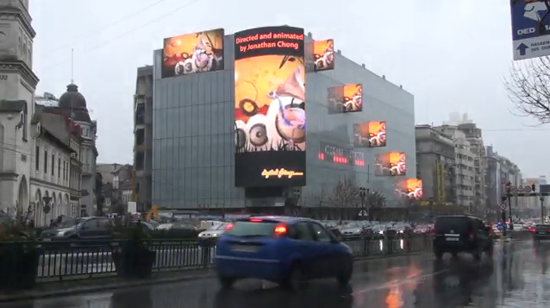
According to festival co-producer Simeon Moran, an estimated half-million people saw this year’s festival which was broadcast on about 250 screens. Most of these showings were in Australia, but there were also screenings in Africa, Europe, Asia, the US, and the UK. To project at locations where there is no existing equipment, on a street or in a public building, Horse Bazaar gathers donated screens from schools, community groups, and private supporters. To project across key buildings or monuments, Horse Bazaar calls in its mobile unit, also known as the MPU. Other than that, the festival can be, and is, about anything. There’s no jury. Submissions are not restricted to a theme. There’s just a global call for work followed by a global response.
As a result, one of the most enjoyable aspects of Digital Fringe is the range of sensibilities it manages to present. Emerging artists especially stand out. Among the more lyrical of this year’s entries is Waveform (2009), by the Amsterdam based French photographer Federico Campanale. Using video shot in Finland, Campanale lays an ambient track of digital pops and clicks against a perfect, languid, 360 degree pan of a line of trees reflected in a lake at dusk. The harsh, guttural rasp of the soundtrack set against the blue infinity of the horizon forms a direct commentary on environment and endurance, and on nature’s coexistence with the manmade.

There is the moody, existential narrative The Man in His Tower (2009) from Tone Gellein of Oslo. In this video, one of those tough guy movie characters walks down the street while suffering jump cuts and odd camera angles. He ends up swinging from lampposts in a cinematic expression of an existential state of mind. Other films may be less accomplished, but are equally philosophical. For example, filmmaker Joe Tusley sent in Spud & Amp in the Barra, Part 2 (2009), a no-frills documentary about a few minutes of fishing in the Apsley Straight, Bathurst Island, NT. Maybe it’s a personal reaction, but it’s hard not to think about the big picture as, on camera, Spud reels in a huge, silver barramundi, then slits its throat.
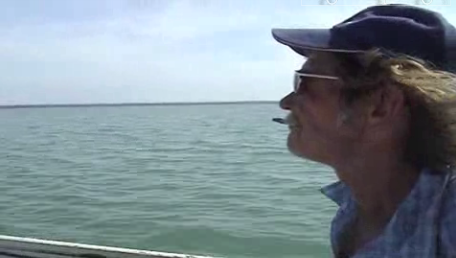
Digital Fringe also streams sound pieces, music videos, machinima, and performance films. There is a good amount of 3D modeling and animation. Colliderscope artist Zennor Alexander and musician Fiona Soe Paing submitted Thayn Tyha Hai (2009) from New Zealand. In this work, the sun and moon follow each other across a wispy, ethereal sky that lies somewhere between dreaming and waking. If you prefer something more scientific, there is the stop-motion simulation Every Second Equals Forty Million Years (2009) by animator Gregory Crocetti of Melbourne. In just under two minutes, Crocetti uses children’s blocks to build the Tree of Life from the beginning of time to just a little while ago.
There is software art such as Turkish programmer Tahir Un’s screensaver project Concepts and Images (2007). Ãœn chooses words ending with the suffix ‘ism’ as the query strings for an internet image search. After collecting images for 90 minutes, a software program fixes a random sampling of that data set into a collage.
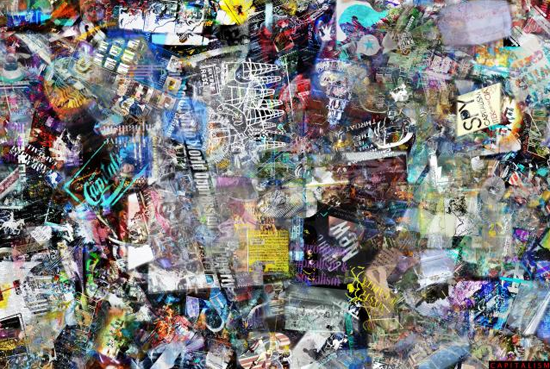
Another interesting aspect of Digital Fringe is its continued support of open source computing and shared culture. Artists uploading work to the Fringe website keep all rights to their projects and are able to license their work in a number of different ways. These include the traditional ‘all rights reserved’ copyright, the Creative Commons ‘some rights reserved’ license, and the completely unrestricted category of ‘public domain’. Creative Commons says that about 75 percent of the festival’s participants choose the CC license, which secures rights of ownership while allowing for mash-ups and remixes. This shows that many emerging artists are willing to distribute under non-traditional copyright provided there are a still few small protections.
Ultimately, Digital Fringe, is a festival that intends to include everyone, play everywhere, and show it all from the dreamscape of the perfect virtual environment to the underlit reality of the amateur video guy. Aside from its inspiring generosity, we get a lot of interesting experiments, the unmediated juxtaposition of the professional and the amateur, and a kind of yearly almanac of what up and coming digital media makers seem to have on their minds.
—
Link: Digital Fringe Trailer.
“The Space Between Analog and Digital”: Alan Sondheim’s Recent Executables
I’ve developed, over the last few years, certain assumptions about software art. Just browse through the many entries available at runme.org (http://runme.org/), and you, too will likely come away with some of these assumptions: that software art is, at its heart, utilitarian; it functions, it does something; it’s tool-like; it’s often more software than art.
Over the last month or so, July and August 2003, the writer Alan Sondheim has been happily chipping away at those assumptions. Alan is well known to netizens for his writing, which operates at the hinge of language and machine code; what isn’t so well known about him is that he’s spent some time programming–indeed, has been programming since at least the 1970s. A careful visitor to his monumental text work Philosophy and Psychology of the Internet (also known as the Internet Text)(http://www.anu.edu.au/english/internet_txt/), will see that Alan has, embedded in the text, some brilliant source code for Quick BASIC, the revival of the old BASIC language once shipped with all Windows PCs. He has written in Perl as well–see his Julu at runme.org (http://runme.org/project/+sondheimjulu/).
I’ve developed software art with Alan’s inspiration in mind myself–the application sondheim.exe (http://runme.org/project/+sondheim/) is a text editor written in Visual Basic designed to transform user input based on a configurable timer. The idea for this piece was wholly Alan’s; in electronic conversation, Alan mentioned that he had once, in the 1970s, written a similar application.
It was shortly after I wrote sondheim.exe that I mailed Alan a copy of Visual Basic, the object-oriented application development environment, developed by Microsoft, based on the old BASIC language. Visual Basic is about as close to English as one can get in the higher-level programming languages; it eschews the funky syntax most other languages have inherited from C, and which is often one of the more apparent stumbling blocks for new coders. And yet, despite its seeming simplicity, it succeeds as one of the most powerful Rapid Application Development (RAD) packages for Windows programming; one can do with Visual Basic almost anything that can be done in C and C++; indeed, if it weren’t for the fact that VB is exclusively a Windows programming tool, it might even approach that paragon of portability and power, Java.
Alan took the tool and ran with it. His characteristically unique vision, combined with his agile sense of mathematics, has produced a series of standalone executables in Visual Basic that are challenging the very core of what I had always assumed software art was about–creating strange and wondrous tools, creating functional pieces that interacted with unsuspecting users.
Alan’s recent Visual Basic works are nothing like that at all. These are not tools in any sense of the word. They’re only minimally interactive; usually, all one of these works require to get started is one simple mouse click from the user. Instead of crafting a functional artistic tool, Alan Sondheim has, in these works, highlighted the very processes one’s computer uses. These are narrative works, in the skin of software.
Anyone who has downloaded these is doubtlessly scratching their head right now, thinking, “Narrative? What’s narrative about watching an image dissolve or be defaced in some pre-programmed way?” Well, I understand your consternation. I’m not the most stable of people. Children run away from me when I smile.
Be that as it may, I’m sticking to my thesis: these executables are narrative; what we’re watching, when we download and run this software, is, as Alan himself states, “mathesis transform(ing) semantics…” And here’s how:
The Archaea Series
This is where I first began to notice the gist of Alan’s work in Visual Basic. The Archaea series consists of ten executables; they are all predicated on the dissolving and warping of images based on mathematical processes. The most vivid in the series is archaea3, downloadable here: http://www.asondheim.org/portal/archaea3.exe .
“The programs are operating in the space between analog and digital, although totally grounded in the digital,” Alan writes. “What are they deconstructing? Language, meaning, symbols, the symbolic. Through erasure and the growth of form.”
We’re confronted with a very red image of breasts pressed up against some glass when we first open archaea3. The glass is beaded with moisture; either the light or the filter makes the water gleam a sinister red. When we click on the image, what looks like static begins to eat away at the scene from left to right, very slowly; the static looks like it’s wiping away the image, as if it were cleansing the screen of this suggestively bloody site. It’s almost like watching a linear animation–except here the story, the plot, the interest, hinges on the horizontal erasure sweeping through the image. It’s a purgative myth we’re witnessing; like the big fish vomiting Jonah up out of the sea.
What clinches process works like these as narrative is the fact that Alan uses evocative images in this software. “…these images are interpreted in terms of the underlying photographs – a lichen-like growth upon them, empathetic and cohering. In turn, they modify, deconstruct….” Alan muses. The images serve as a reference point. The story’s there, not just in the images but in the process itself–a process the user stands outside of. Like cinema, like literature, it’s a closed system until it’s in front of us, in our heads, and when we perform the magic of watching.
The other works in the series follow the same principles. In archaea9 (http://www.asondheim.org/portal/archaea9.exe), a woman (Alan’s wife and long-time collaborator, Azure Carter, whose influence on Alan’s work is ever pervasive) paddling in a swimming pool that gets “erased.” But what kind of erasure is this? The paradox of this process that Alan is using is precisely in its “lichen-like” growth. In number 9, it’s quite evident that this image isn’t being erased so much as it is being penetrated by an emptiness. Ripples from the image linger as the process spreads throughout the surface of the picture. The emptiness left behind is an entity unto itself–may, indeed, be the protagonist in these stories.
Or is the image the protagonist? archaea4’s image is basically that of a rocky hole. Found at https://alansondheim.org/, the erasure in this piece resonates strangely with this hole. Which is the emptiness? Is this a zen koan, a linear animation, or software?
This Program is not Responding
One aspect of these pieces may actually come across as a design flaw; clicking on the close button in the upper right hand corner doesn’t close them. Indeed, just trying to move the piece from one area of the screen to the other causes a major hang on CPU resources; the image blanks out completely, along with its erasure.
“The immobility of some of the pieces, as well as the inability to resize is deliberate,” Alan maintains. “I thought of these as ‘sticky objects,’ insistent on their own processes. One of the earlier ones, of course, _does_ kind of stick to the desktop…”
I can see how this would enhance the work. When running one of these strange programs, I often feel as if to do anything at all on the computer while the process is playing itself out would be to violate the principle of the whole thing. I get the sense that what is happening in these pieces is both intense and enormous; and yet, fragile as far as the machine is concerned. This process will not tolerate any other process spinning off in the same space.
I like to leave the works running on my screen. Like a good movie, or a good novel, I’m fascinated enough by the interaction between the characters to sit still for a moment, absorb rather than react.